
|
I was on a business excursion to Smithfield, Virginia in mid-June 2006 and had an opportunity to shoot some birds along the Pagan River. I stayed at a hotel with a marina on the river, so walked down to the pier and took some shots several hours before sunset one day. Mostly I was experimenting with exposure compensation, right adjusting the histogram and trying out the 70-200mm f/2.8L lens with my EF 2X II Extender, which wide open represents 400mm at f/5.6. Overall it wasn’t real successful but I learned much and enjoyed it…
Below is a photograph of the hotel – Smithfield Station. As you can see it has a marina and is a nice facility with a restaurant and lounge that appears to be well frequented by the locals. Staying here was nice and being on the Pagan River, about two miles from where it runs into the James River, provided opportunities to image some birds. I couldn’t get close to the waders without a boat really so exposed from various points on the dock. I used my compact tripod or handheld the camera and imaged in Raw format. I use Raw nearly all the time these days unless I'm photographing non-presentation, work related tasks for the project record. You can see the crane behind the hotel; a large additon/expansion is underway and guests were awakened by the sound of a pile driver if you didn't get up early.

|
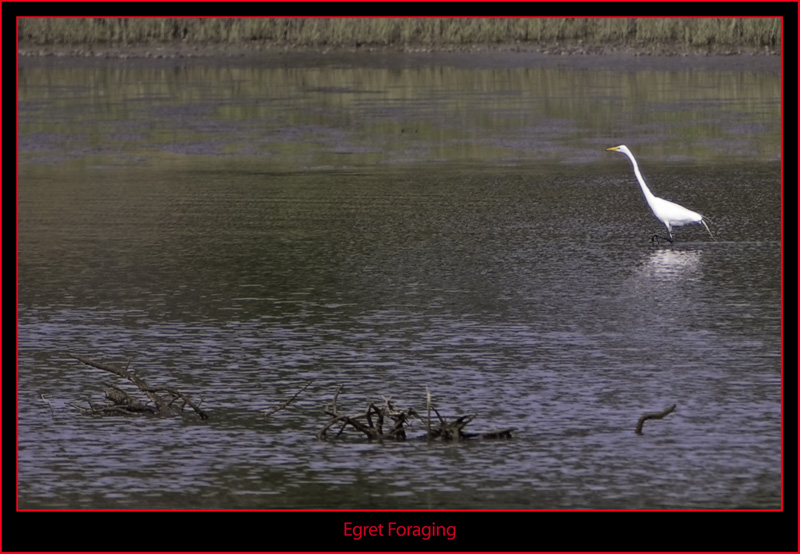
|
When I got back to the facility after visiting the housing project we are preparing to rehabilitate, I took a look around to see what was going on in the neighborhood. I viewed
four or five Egrets, a few Great Blue Herons and an Osprey nest with young on a piling in the river. Many birds were in the area as could be ascertained by their calls
and seen in flight but none were exactly nearby. I set up my camera and walked down the pier to the ‘lighthouse’, a replica of the original lighthouse
now serving as a 'honeymoon suite' for the hotel based just off the
river bank constructed on pilings. I set up my compact tripod, way undersized for the 5d and my lens choice and took some images of this Egret, the closest one to my location although all the
way across the river. You can see the issues with this image scale. A nice photograph but hardly close up at 400mm. Plus at that focal length camera shake can be an issue and the lens is long with the extender adding another 2.5 inches overall. This shot was at f/5.6 in Aperture Priority at 1/320 second exposure. |
|
This Heron was walking the shoreline on the opposite side of the river from my location. While the bird took his time looking for a meal, I had time to experiment with exposure
compensation as I imaged. It was no simple task at the distance involved to keep the entire bird in focus. The usual practice is to focus on the eye and attempt to get a
‘light catch’, or focus on the neck along the same plane as the eye for smaller examples; but being across the river – fairly far away, the focus square in the viewfinder makes this a difficult proposition. The shots I liked best, when the bird
was stretching and moving about, either had camera shake or focus/exposure issues. I can certainly find splendid examples of birds of this nature where I live and hope to have
some opportunities soon when I can get closer for some detailed shots. However, this one will do for now as I continue to gear up for this endeavor.
This shot was at f/5.6 in Aperture Priority at 1/200 second exposure. Having the file information saved with the images is a great help when you get back to the computer and have a chance to investigate the photographs. It's helpful to know what works and what didn't although lighting conditions are never the same on various days. In the 'old days', especially with astronomy imaging, I carried a handheld recorder or created a 'shooting log' log on my computer to identify the exposure information. In astromomy this wasn't too difficult as the average film shot was 45 to 60 minutes. Now, my CCD camera records the data just like this digital camera. |
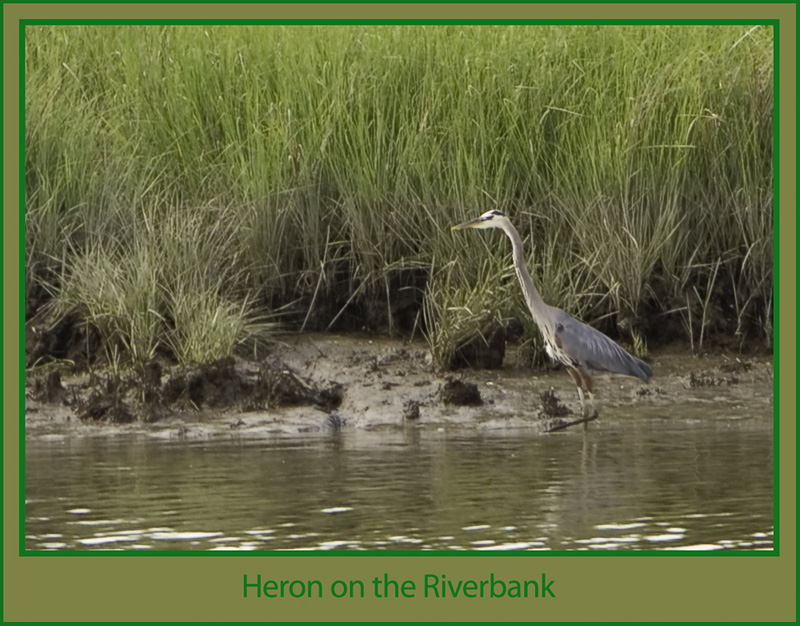
|
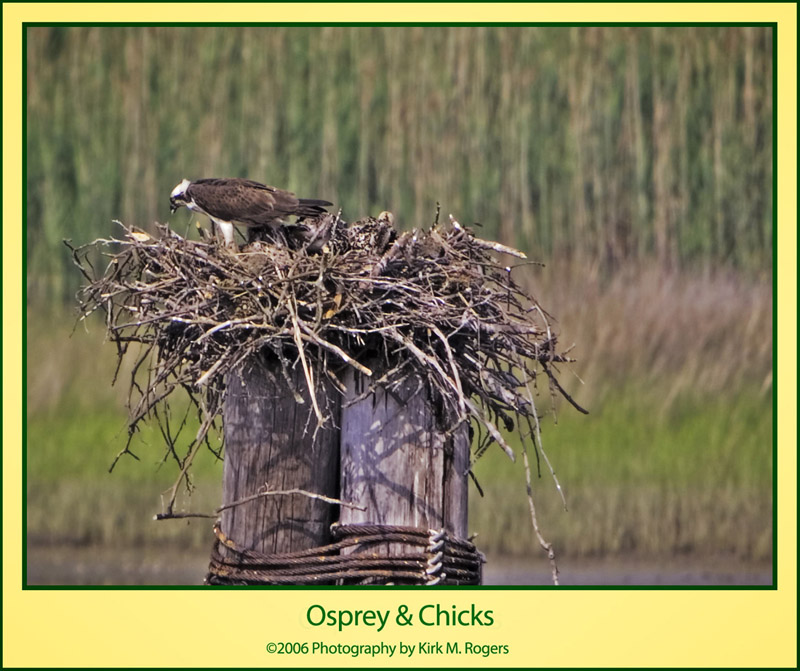
|
This image shows the mother Osprey in the nest with her chicks. This photograph is a prime example of how well the Pixel Genius Photokit Sharpening programs perform in the enhancement
workflow. With the various selections available in this program one can selectively sharpen or smooth portions of the image, the end result is to have the subject ‘pop’ out of the frame.
Compared to the colorful background, I believe this is a good example of this and the piling, nest and mother Osprey indicate nice details for the distance involved in the image.
In this image and the nest photo below, the mother Osprey was keeping a close eye on an Egret just below them in the water. I don’t know if this represented a danger to her young but as you can see, she was watching intently. Neither of the parents bothered the Egret, certainly the father could have driven it away should it have been necessary. The two images weren’t shot in the same timeframe; the mother watched this Egret until it moved from the vicinity of the piling beneath the nest, perhaps an hour or so. I have several images with both the nest and Egret in view but the focus wasn’t successful in capturing both birds in the frame. I considered shooting individual frames and creating a composite of the two, but was more interested in shooting the Osprey group. This shot was at f/5.6 in Aperture Priority at 1/400 second exposure. |
The photograph below is my favorite from the day so I uploaded a larger version to view the detail… This has both adults and the chicks in the nest. I was able to shoot this with the eyes of both parents in view and represents fairly well what they did most of the time – just hang out with the kids. The chicks weren’t too active although they did move around some. I’d hoped to catch them spreading their growing wings or similar but I viewed nothing like this in the few hours I was around.
This shot was at f/5.6 in Aperture Priority at 1/250 second exposure and could have been a bit better as it exhibits a bit of camera shake or movement. As stated, at 400mm it is difficult to prevent any/all vibration, but I suspect this was from me and not mirror slap. I’ll alleviate some of this concern soon when my new tripod system is delivered and put to use. In some respects daylight imaging can be more difficult than in astronomy as the exposures are short and subject to vibration; the single greatest advantage is you can shoot multiple images quickly for as long as you wish. With this session I experimented with the burst feature on the 5d and found it works well for camera selected metering and in exposure compensation bracketing. In RAW format you can easily crank off six, seven or more shots although you have to wait for the camera to download to the card at times. Even so, this procedure is quick and wasn’t problematic. I would recommend the fastest download speed card one can purchase regardless of the storage size. I use 2GB cards and was finding that I could use more storage, so ordered/picked up a pair of 4GB SanDisk Extreme III compact flash cards from my local camera shop. The 5d autofocus feature is quick and fairly painless. I utilized evaluate metering most of the time using the center autofocus square as the primary. Because a RAW file at the distance I was shooting leaves plenty of room around the subject, I can view the image in full pixel size on my monitor and then compose and crop the image as I wish after the fact to avoid having all the subjects centered. I use my own version of the ‘rule of thirds’ these days in composition but personally I don’t mind centered subjects, just not all the time. These images are all at the full pixel size from the 5d files and the layered master files should make outstanding prints on my Epson Stylus Pro 4000 printer. Like most, I archive the enhanced master with the layers and then convert and reduce significantly to achieve a jpeg version for web display. With CS2 I've been saving the achival images as tiff files because these will allow a thumbnail or filmstrip view when I'm scrolling through the folders looking at photographs. Using the native psd format, no thumbnails are displayed, so you have to open the file in Photoshop if you didn't recognize it by name. THe newer version of Photoshop allows saving layers with tiff files intact so there is no compromise when doing this.
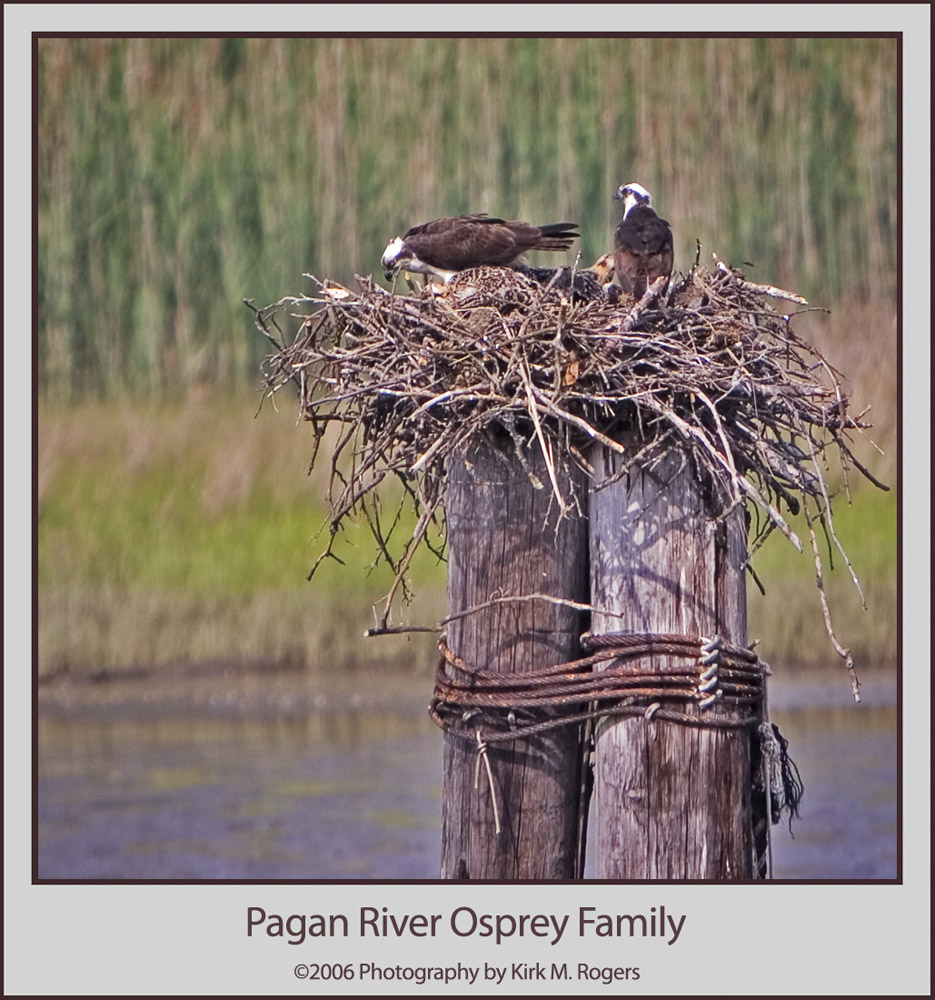
|
|
This in flight silhouette was taken the next day on a rainy, nasty afternoon. It rained from the time I got up and was still raining when I retired that evening. It goes to show that you
should take advantage of whatever opportunities you are given; sometimes waiting can be detrimental as would have been the case if I’d done so until the next day for an imaging session.
Anyway, this is most likely the male Osprey from the family shot, although I can’t say for certain as I didn’t see where the bird went, but I didn’t see any other Ospreys
around the day before.
I like this image… However, I must comment that it was a gray, wet afternoon when I took this shot. My associate Bill (Billy-Bob) Grotto and I were sitting on a balcony, thankfully roofed, smoking cigars, talking and watching with the camera at hand. The best bird shot opportunities had already come and gone before I decided to break the camera out and get prepared; this sequence was the next best fly by. I nailed the bird in flight coming and going as far as composition was concerned but it was well underexposed and the background was terrible. In hindsight, I should have gone to manual mode and set the shutter speed to a more appropriate setting for the conditions. So, I cropped the Osprey out of the background and placed it on a sunset view from a Florida image I took earlier in the month. Afterwards, using Photokit Color II, I employed a nocturnal filter and blended it in to get the composite viewed here. This is the only image noted here that was shot with the 70~200mm f/2.8L lens without the 2X extender. The Osprey was shot at 1/200 second, 70mm focal length at f/4.5. |
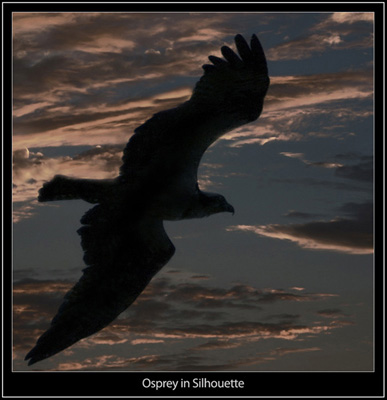
|
After I'd combined the silhouette above I decided to look at a few other shots in the sequence taken as the Osprey flew by. The end result is the composite below, the same bird in flight in three poses . This was created using the same workflow as noted with the image above with the same background image from Florida.
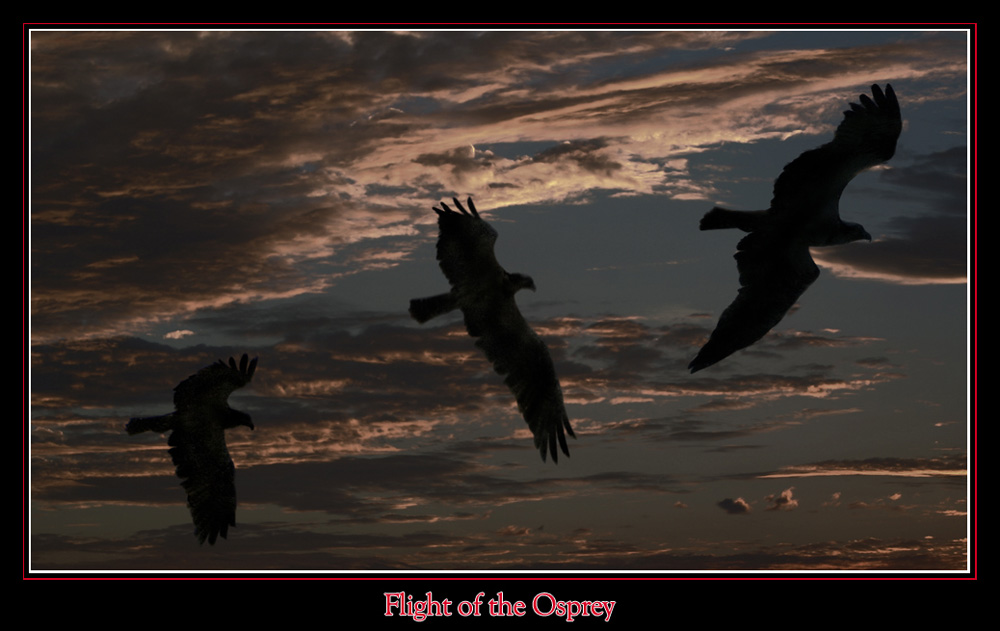
|
I’ll be going back to Virginia over the summer multiple times and hope to improve upon the photographs shown here. Next time I’ll bring a rigid tripod and may have time before then to improve my technique, which is sloppy at best. Because it will be during the week I’d like to stay at the same hotel if I can, but my understanding is that it is difficult to get a room there in the summer with all the boaters coming up the river. Time well tell if I can be around when the Osprey chicks take flight in preparation to leave the nest. In the meantime I'll continue in the photography learning curve and attempt to improve in this endeavor.
Kiro
June 2006
_____________________________________________________________________________________________
As things turned out, I was in Smithfield multiple days in July, after the 4th and the following week of July 10th. I took the opportunity to get up at daybreak – not a big deal as sunrise is over an hour later in Virginia than Maine to image the bird life near the river. Much of this is the same but hopefully you can view some improvement with these images.
The days after the 4th of July brought rain, heavy at times to Smithfield. 'Billy-Bob' Grotto and I went out one morning and he was kind enough to hold an umbrella over the camera and lens for this session. I was soaked through in no time but we did manage to get a series of shots in. Note how much the Osprey fledglings had grown over a one-month period from the images above. They weren’t flying yet but they were practicing and getting ready to start. Find below a photographic summary over several days:
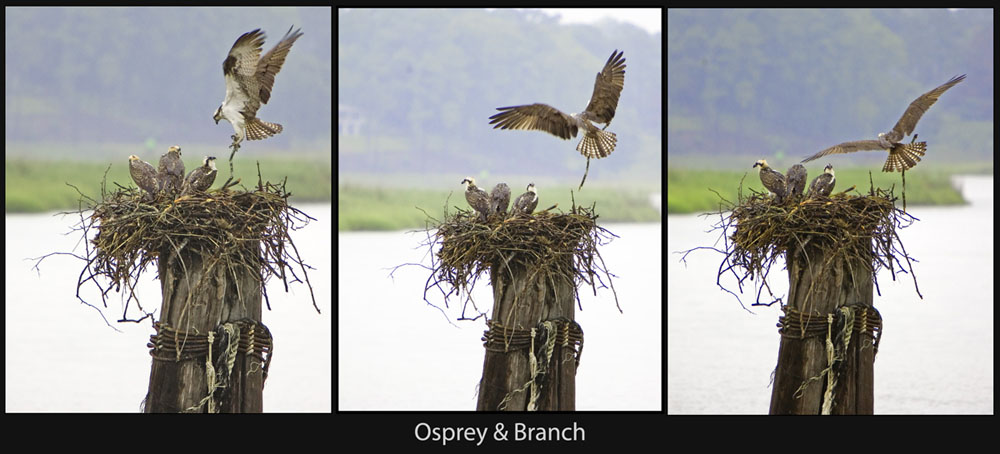
|
You can see how the fledglings look much more like the adults in these views. We noticed the mother was more apt to go fishing and didn’t appear as concerned about leaving the youngsters alone. This series was at 400mm focal length; you can’t really tell how miserable the morning was in these images, but they were exposed in the rain.
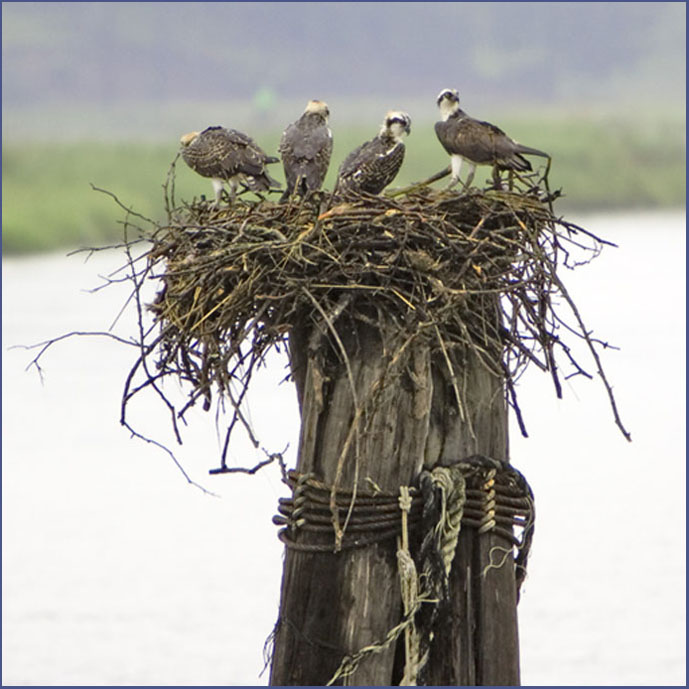
|
This view is of the entire family hanging around the nest in the rain. The parents were still quite attentive to the young at this stage in their development.
|
|
This Royal Tern was out fishing and in this flight view, had proven successful. I tried to image this bird when it struck the water to snag a fish but they are quick and achieving
focus lock is difficult at best. Flight shots are really not good in weather like we had this day, but it is good practice to attempt to track birds in flight as
much of this is an experience issue. This shot, as well as the others viewed here, were shot with the 70~200 f/2.8L lens with the 2X extender.
|
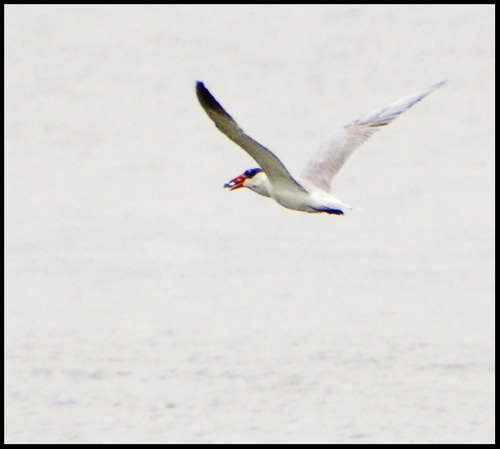
|
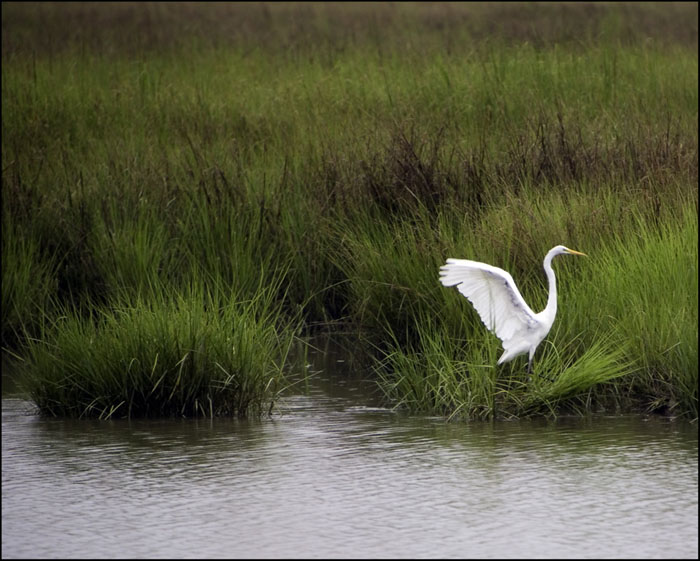
|
This Great Egret flew across the river and landed on the bank to my left. I swung the camera around and took this image. This bird was fairly far away and the focus on the Egret
wasn’t perfect. I was convinced more focal length was required to produce a larger image scale but used what I had for equipment in the field.
|
|
This Laughing Gull landed on a pole not far from me and commenced to making a significant racket. I don’t know if this was for our benefit or not but the bird was
quite vocal sitting in the rain. Linda named this image 'Town Crier' after she viewed the enhancement. This would have been an outstanding shot with a blue sky background on
a nice day. Shortly afterwards a Red Winged Blackbird flew by and the Gull jumped up in reaction to this incursion. I took a shot of this and may post it here later.
|
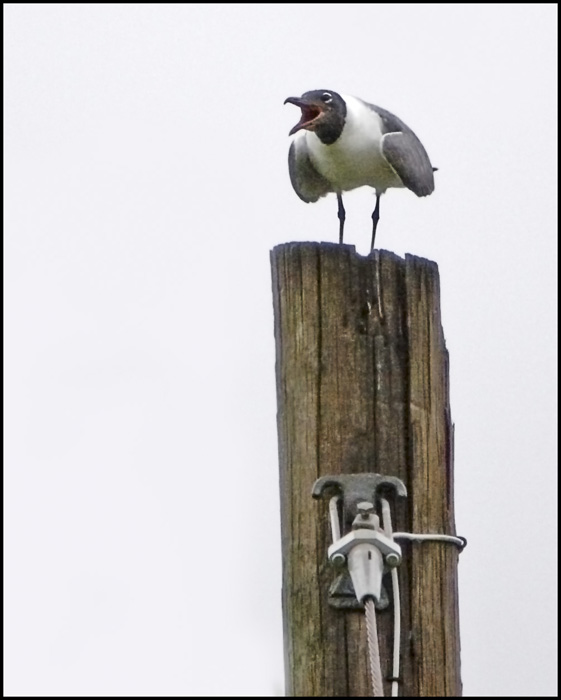
|
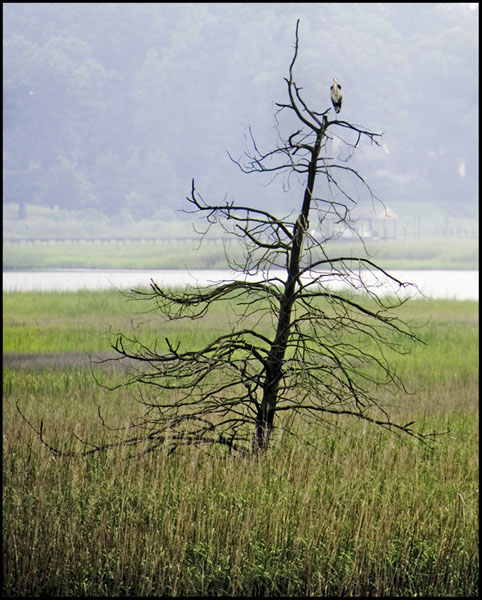
|
'Billy-Bob' and I were sitting on the hotel room 2nd floor balcony when I spotted this Great Blue Heron in a tree on the opposite riverbank. I thought this was kind of unusual and took this shot while the Heron was standing on one leg preening and checking out the area. It was surprising that the branch was as stable with the Heron perched as it appeared to be... |
Because of building permit and other work related issues, I returned to Smithfield the following week of July 11, 2006. The weather was warm, extremely hot and uncomfortably humid compared to our weather at home. Although the sky conditions weren’t ideal, this was the best photography weather I’d experience in the times I was in the area. I was traveling with another work associate, Bryan Stephens; he came along and ably assisted the imaging effort when we had time to get out. I was better prepared this trip and had a Canon 500mm f/4L IS lens, Wimberley Sidekick and 1.4X extender so I could shoot at 700mm focal length. The images below indicate the power of this lens compared to the shorter focal lengths. I was pleased with this collective group and find that this is the type of imaging I'd hoped to be doing.
|
It was just one week later from the last time I’d imaged the Osprey family, but this week found a significant difference at the nest. Both youngsters were flying well and spent a
good deal of time circling the nest and stretching out their powerful wings. The mother was in the nest about half the time I was there and the father was generally
in the area within view although he went off on fishing expeditions from time to time.
This fledgling remained in the nest and I was able to take this shot, which I believe captured the beauty of this young Osprey as the bird watched the other members of the group fly around the nest area. |
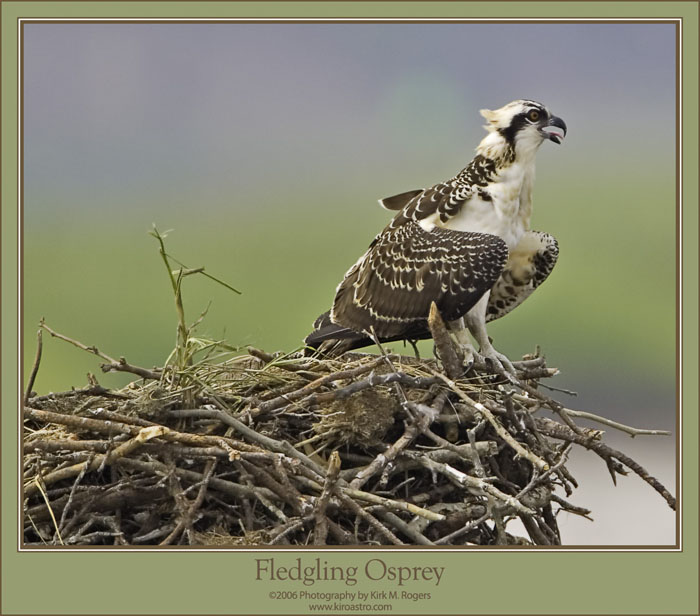
|
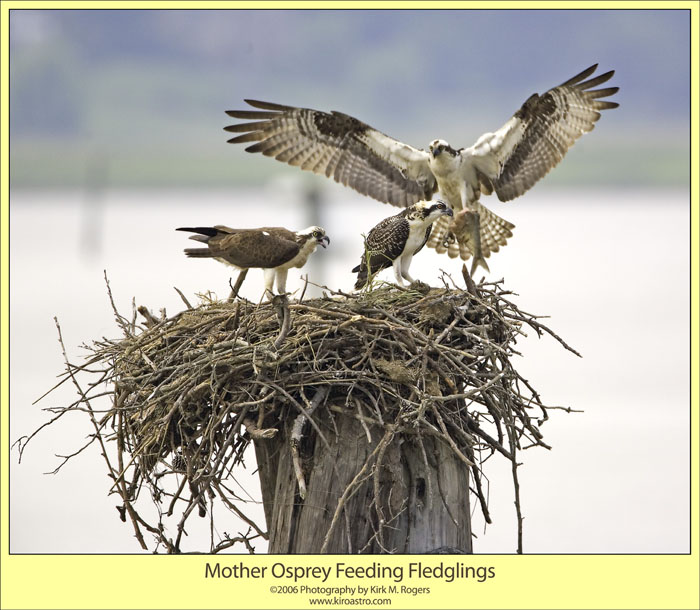
|
The mother Osprey caught this Menhaden (known as a Pogy in Maine), apparently ate half the fish and returned to feed the youngsters with the balance. I took a series of images of the inbound flights and selected this one of the group to enhance. The catch is clearly visible in the mother’s left talon. |
|
In this view the father of the nest is returning from a jaunt around the neighborhood. He simply flew back to the nest and hung out as the younger birds finished their fish meal.
|
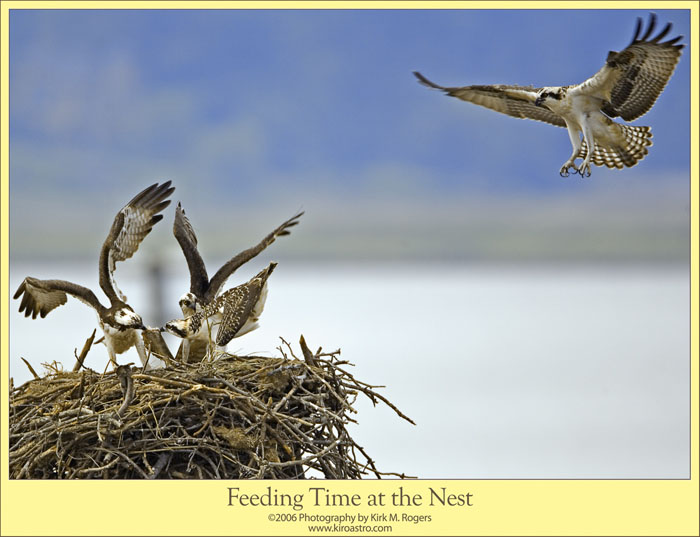
|
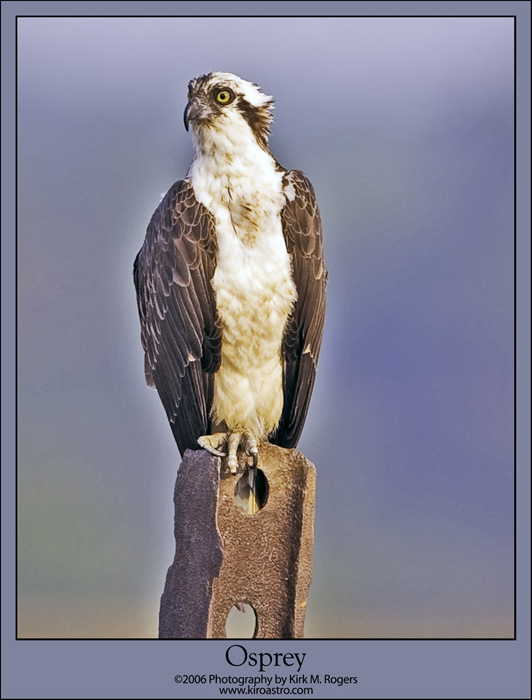
|
This magnificent specimen is the patriarch of the nesting group perched nearby the nest on an abandoned steel piling. I enhanced this image to make it look a bit like a painting. I can’t say how successful I was, but I do indeed like this image and the full resolution print came out quite well. This was shot at 700mm at 1/125 second. |
|
This image is of a Great Egret flying in to forage next to a Heron. The tide was out and the mud flat was full of Fiddler Crabs moving to and fro. This view captured quite a group
of these crabs on the move.
|
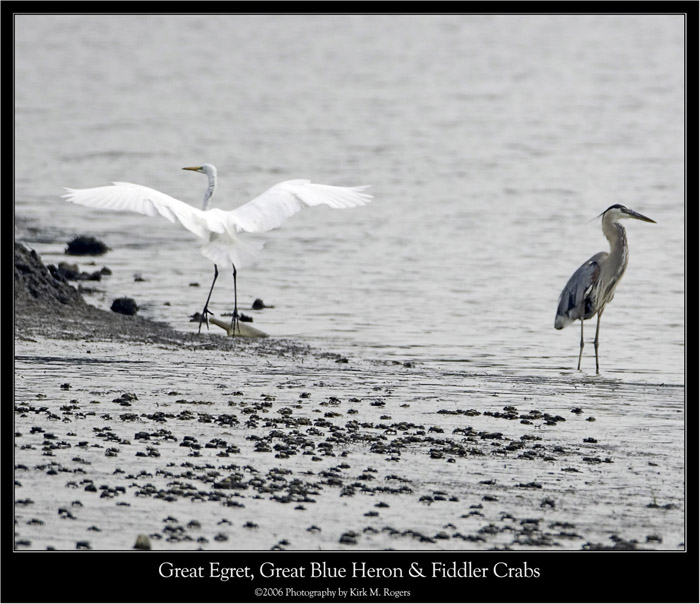
|
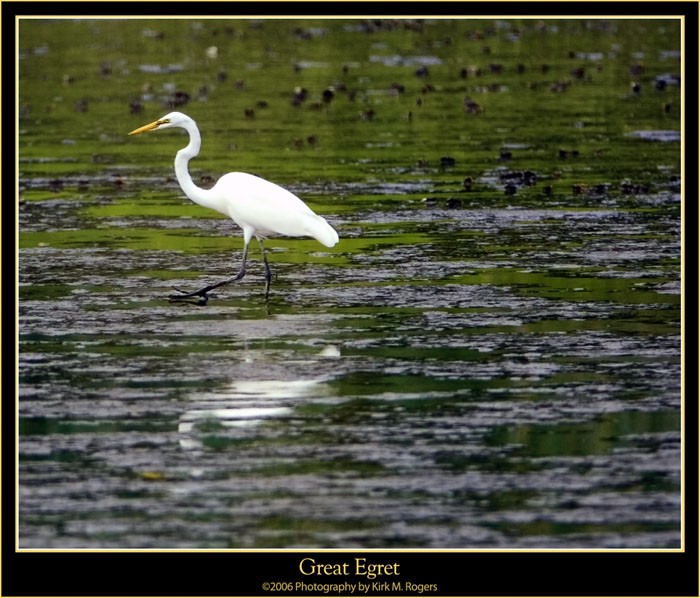
|
This Great Egret was one of about eight or ten that live in the area. At times they flock together in a particular tree fairly far from where I was set up. I took several images of them as a group. Although they can be plainly viewed, the images didn’t have the impact I’d hoped to achieve. At other times, they were off individually fishing and seeking sustenance at various points around the river. |
|
The following views are of a local Great Blue Heron fishing in the river. I was pleased to achieve a larger image scale as indicated in these photographs.
|
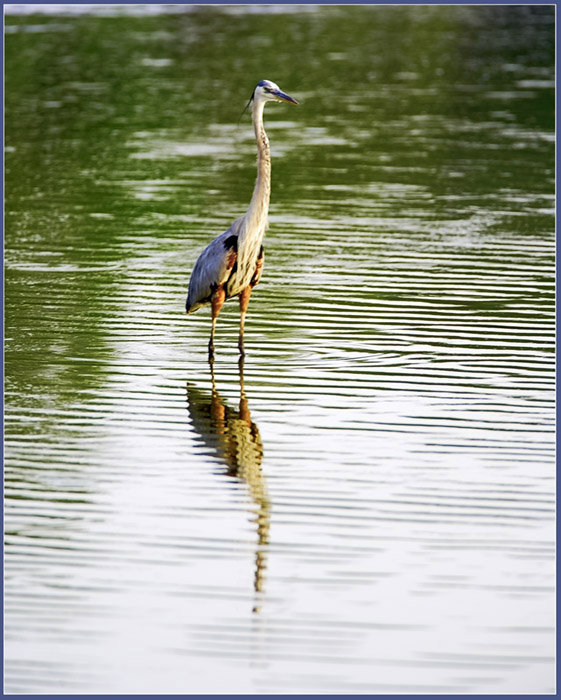
|
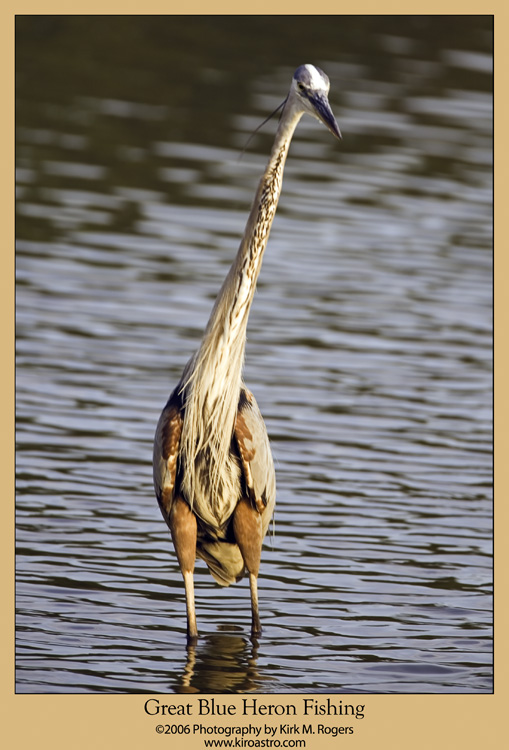
|
This is about as close as I could shoot and keep the outstretched Heron in the field. These birds really are beautiful and common everywhere I travel along coastal regions. |
|
This is a head shot of this magnificent bird. I was pleased with the power of the lens and the detail this image provided.
|
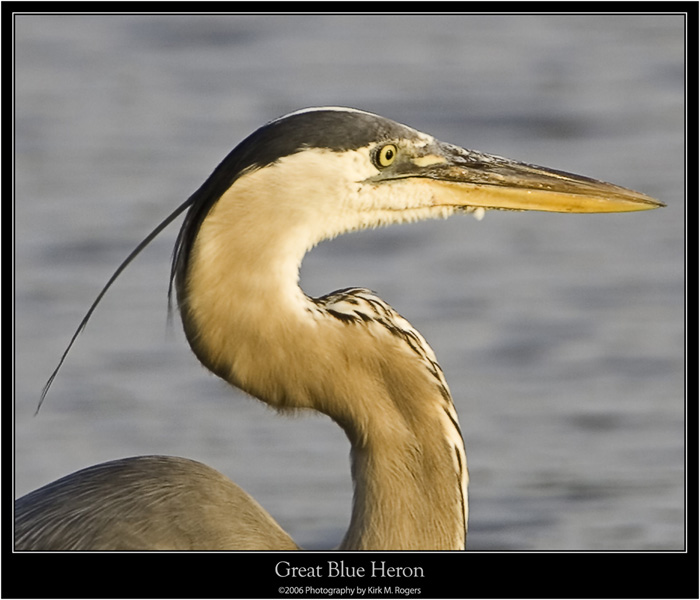
|
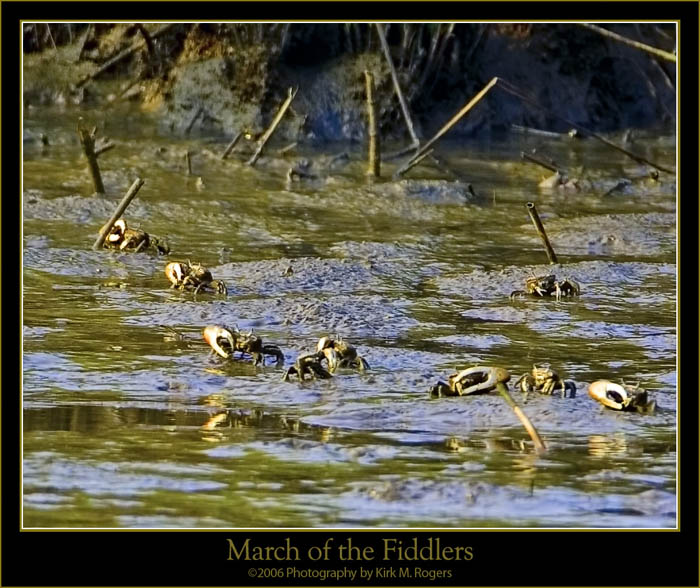
|
This view is a close up of the Fiddler Crabs on the mud flat. They were pretty much everywhere to be seen and seek out higher ground as the river rises. I was informed the males have the single giant claw, the second being normally sized and the females have claws that are in proportion to their bodies. |
|
I was able to take this Blackbird image fairly close to where I was set up. I’d shot these birds at various times but finally got a background and location that I liked to get this image.
|
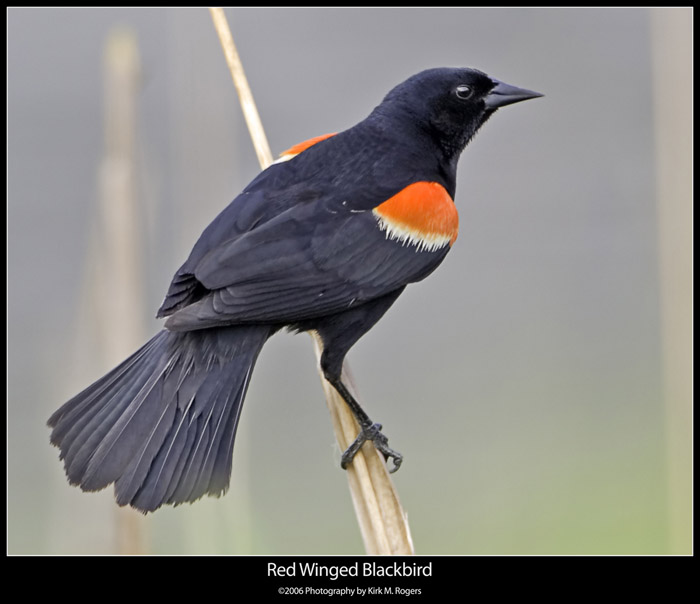
|
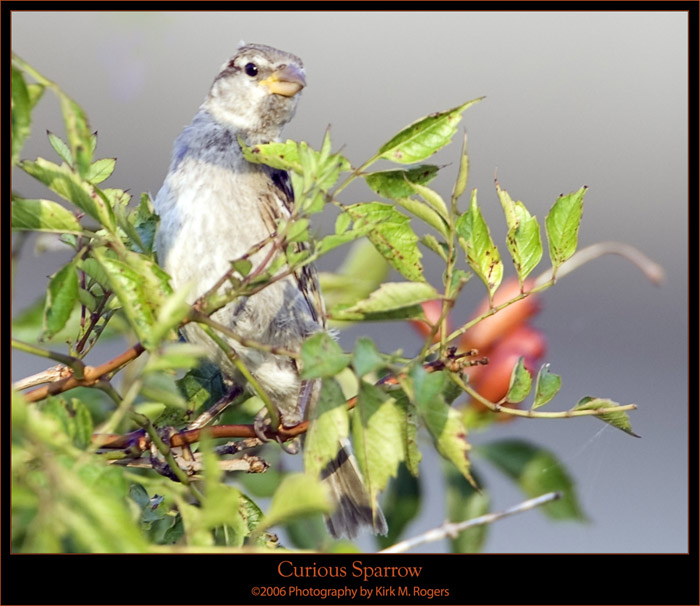
|
This Song Sparrow was one of many flitting around me all morning. However, getting one to image in a location that allowed you too see the bird wasn’t as simple as one may suspect. I was able to expose several of this particular bird and I enjoyed the look on the bird's face as the shutter sound drew attention to what I was doing. |
|
I liked this Sparrow image as well and decided to post them both.
|
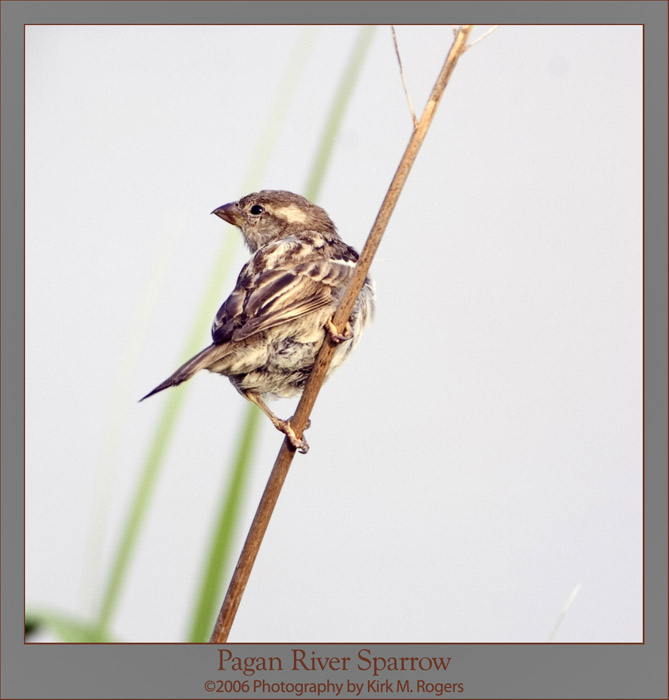
|
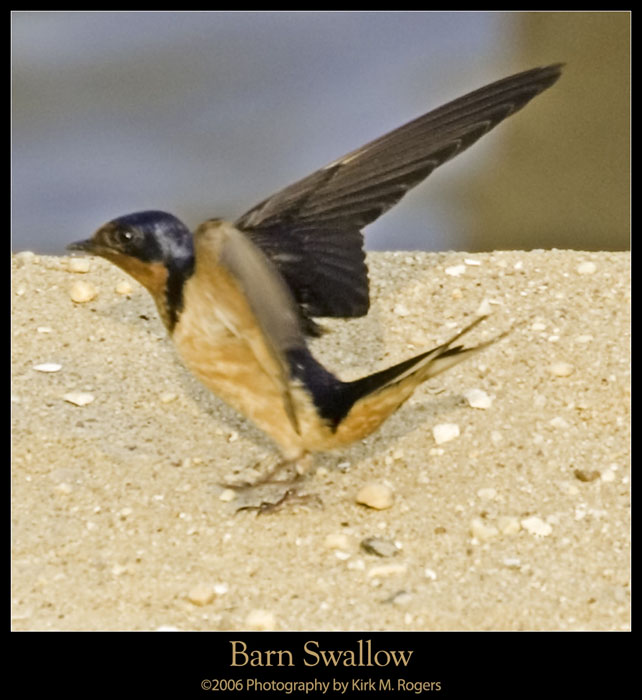
|
A group of Barn Swallows was flying around our area all morning but were much too quick to attempt trying to get an image. However, this bird stopped for a brief rest and I got this not so perfectly focused image off. This is the only shot of this group not taken with the 500mm lens. I was getting ready to leave and had the 70~300 DO lens on the 5D when this opportunity presented itself. This image was at 285mm at f/5.6. |
|
And last but not least, this is the final image from the group that I enhanced. I imaged this American Robin on a lawn. This is the first image I’ve taken of a Robin with a long lens that was stable.
|
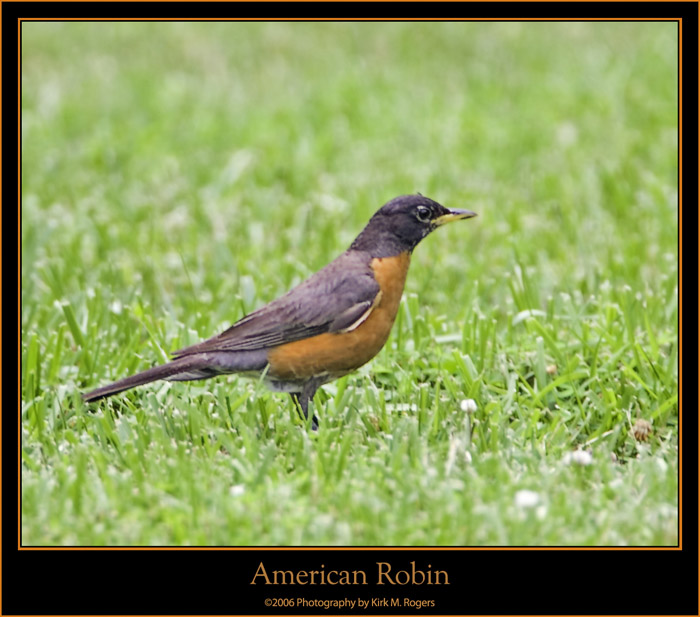
|
So ends the July group from Virginia so far. I know I’ll be going back again at the end of the month but it’s uncertain what equipment I may bring with me at that time. I always have a camera handy for work images so this remains to be determined. I hope if you viewed these images you can see the quality level improvement since I started imaging the Osprey nest in June. I’ll be lucky to see the Osprey fledglings again. They were getting self-sufficient and learning to hunt/fish and feed themselves, so it won’t be long before they abandon the nest and strike out on their own.
_________________________________________________________________________________________________
July 25th - 27th, 2006 found me back in Virginia for business and I again had my camera equipment with me. Bryan, who'd been working on the project in Smithfield full time met me at the airport and indicated he’d been searching out some new locations to image birds if we had time to do so. There was much to be done business wise but the day’s are still fairly long and we could generally get an hour in before going to the project site and we planned to do some imaging. Bryan is great and a true asset both at work and otherwise; even when I didn’t feel like doing much off the job (it was still quite warm in Virginia in July) he encouraged me to get out and shoot and we stayed motivated in this endeavor.
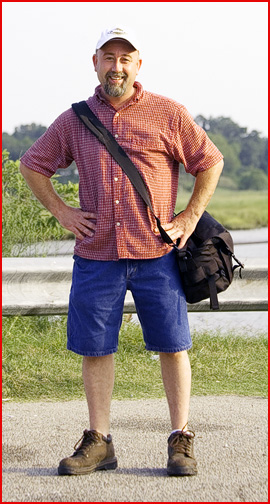
|
Here is a photo of Bryan taken one afternoon… Note he has my camera bag slung and is ready to seek out the local wildlife so we can try some digital capture.
Bryan has good eyes and much better hearing than my old ears these days, plus sharing this experience with him is fun. He’s been staying in Newport News,
about 30-miles from the work site, so he was getting up early to meet me right after sunrise to take advantage of the 'golden hour'.
We’ll only be in Virginia for a few months so figured we’d take advantage of the opportunities presented. I’ve been teaching Bryan what little I know about ‘daylight’ photography and explain to him what it is I’m doing, steps to prevent camera shake, composition, etc. He has no problem getting behind the viewfinder and has taken multiple shots, perhaps even some posted here as you generally can’t tell except from memory who did what with the camera. He is also an avid outdoorsman and knowledgeable about being in the woods and near water. Thanks Bryan for your able assistance; it's been fun to say the least. |
We started out back at our favorite Osprey nest to check out what was going on there. The nest is deteriorating and it was obvious the adults were no longer keeping it up. We’d met a local couple that also was keeping an eye on the nest, Renee (pronounced Reenee) and Allan, and they’d kept me informed via email of the goings on between trips. The two fledglings, I learned later the local park ranger referred to them as ‘the twins’ were still around but the parents were gone as far as I could tell. During this visit, I didn’t see either and can’t say if they were present in the area or not. So, we’ll start this new segment with some images of the twins…
|
However, before posting the recent shots, take a look at this fledgling Osprey image. This young Osprey got stranded on the walkway of the ‘Lighthouse’ building at
Smithfield Station last time I was in town. It couldn't jump up on the banister and the walk was too narrow for it to get a start to fly. We're not certain
where this Osprey came from but he wasn't part of the family we'd been keeping tabs on.
I informed the facility about this and the Owner threw a blanket over the bird and released it from captivity. I told
him I’d taken an image of it and here is a reduced version of it from July 12, 2006.
|
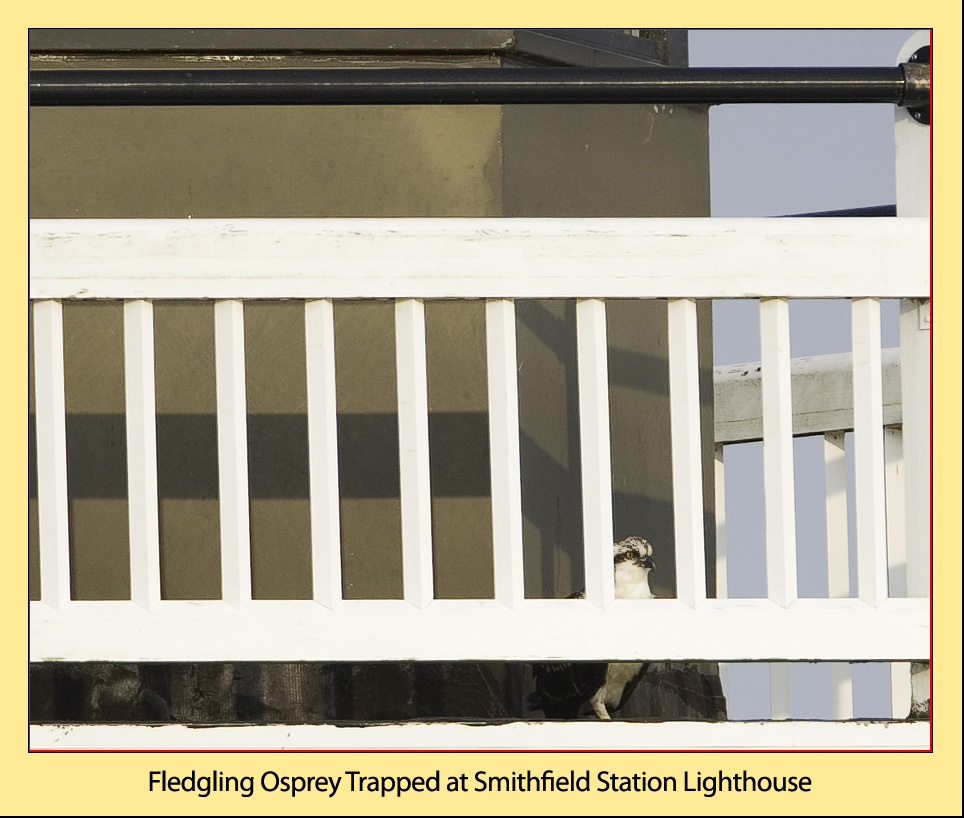
|
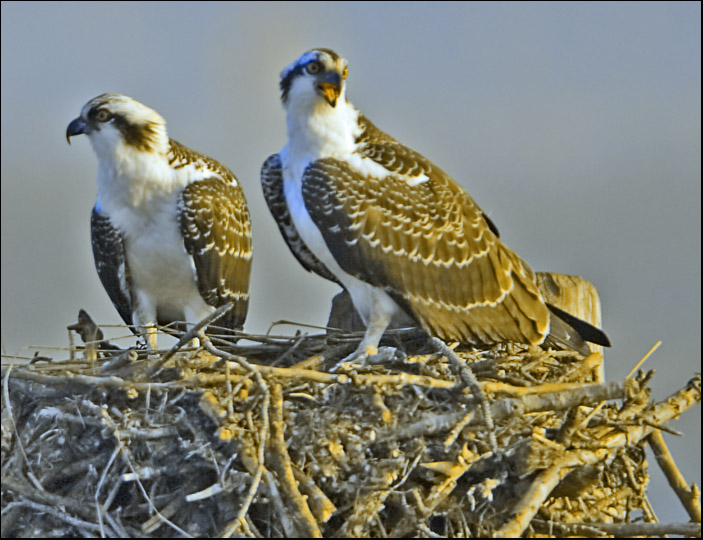
|
Here are ‘the twins’ in all their glory. They are indeed beautiful birds and had become proficient at hunting and fishing since I viewed them last. |
|
Views of the young Osprey - It appears the youngsters had taken over the perch usually occupied by their father and found it a good viewpoint to seek fish in the river.
|
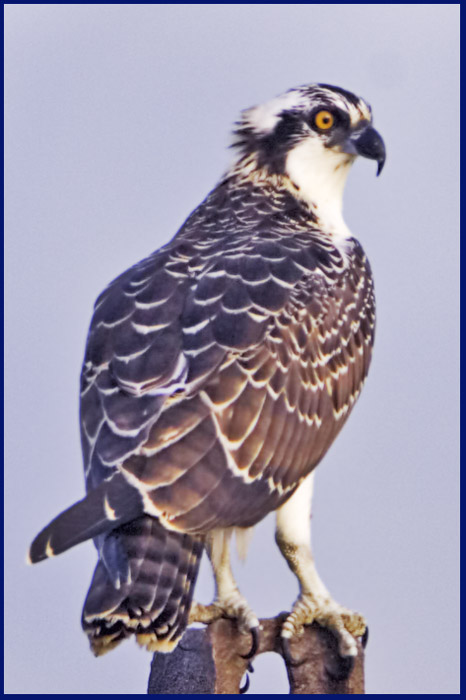
|
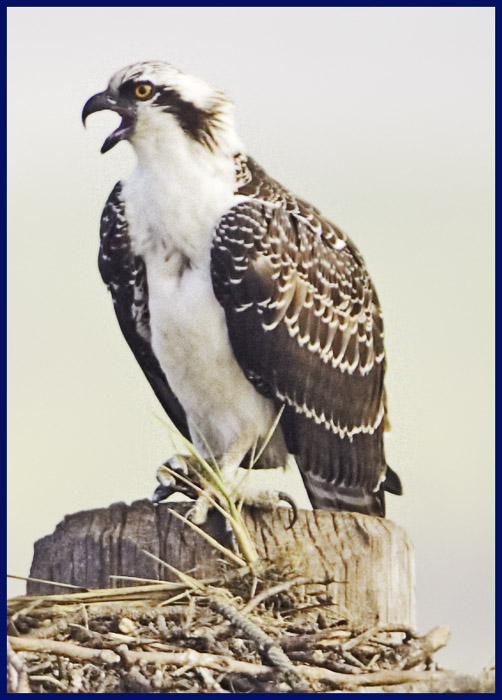
|
The piling this young Osprey is perched upon indicates how much the nest has deteriorated. This was used for a platform when the adults built it and now the nest is shrinking. |
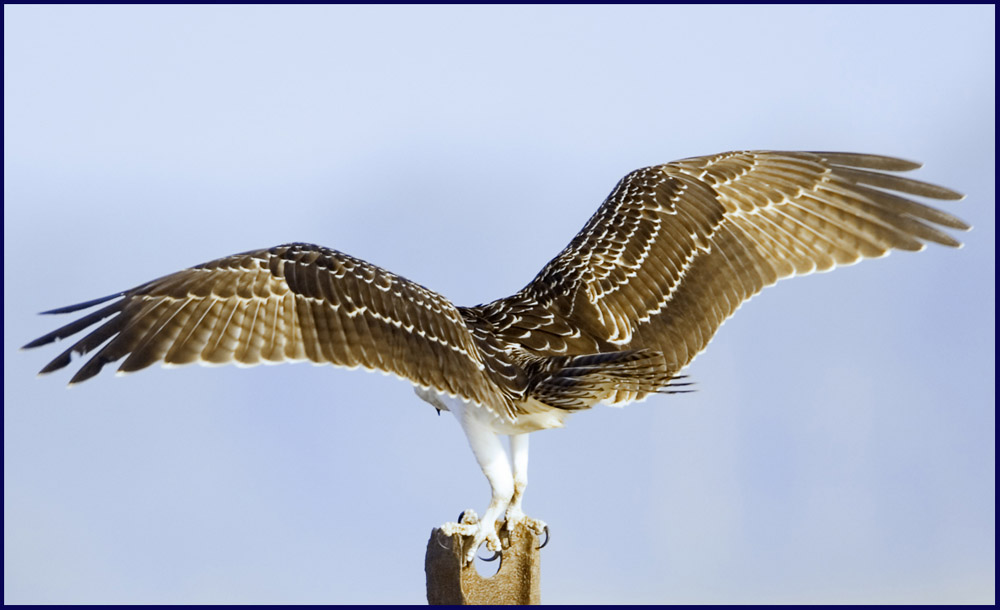
|
|
This image concludes the Osprey group I enhanced from this trip. I won't be returning to this location before the last week in August so may not
see these Ospreys again, although I'm certain they'll be somewhere in the area. I never get tried of watching these beautiful birds and photographing
them in flight.
|

|
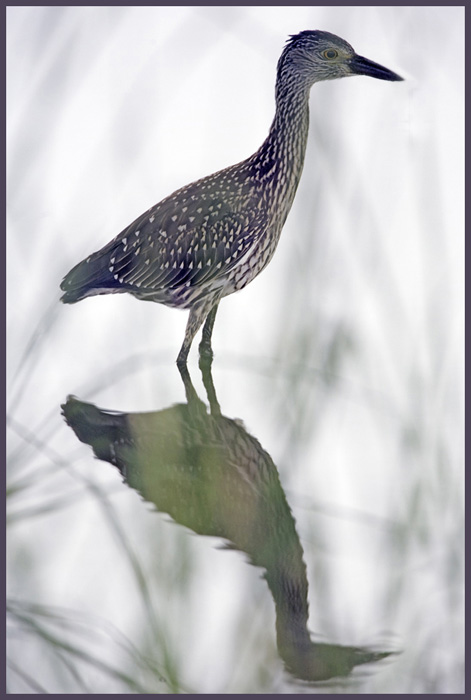
|
|
We’d decided to test out some new areas hoping to find some different birds. One morning we were out and about and thought we’d check out the usual spot by Smithfield Station
before we left. I’m glad we did because I had an opportunity to image this shy Yellow-crowned Night Heron juvenile, who happened to be on the mud flat near to where we generally set up,
allowing me to get some detailed shots through the high grass and growth by the river. I never could get an unobstructed image, so you can see the grass
between the bird and the camera in these views.
This heron is referred to locally as a 'marsh hen' and it took me a bit of time and several inquiries to identify it - juvenile Yellow-crowns don't look much like the adults... One great clue was the fact that the heron is seeking out crabs as noted in the image below. Yellow-crowned Night Herons eats mainly crabs. |
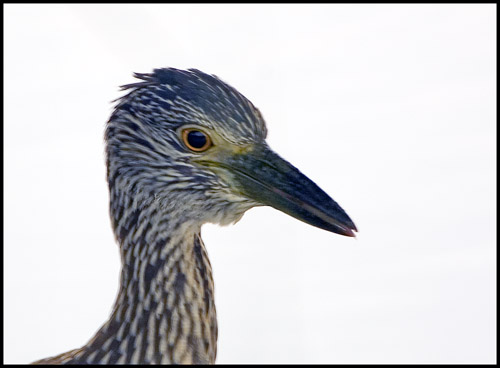
|
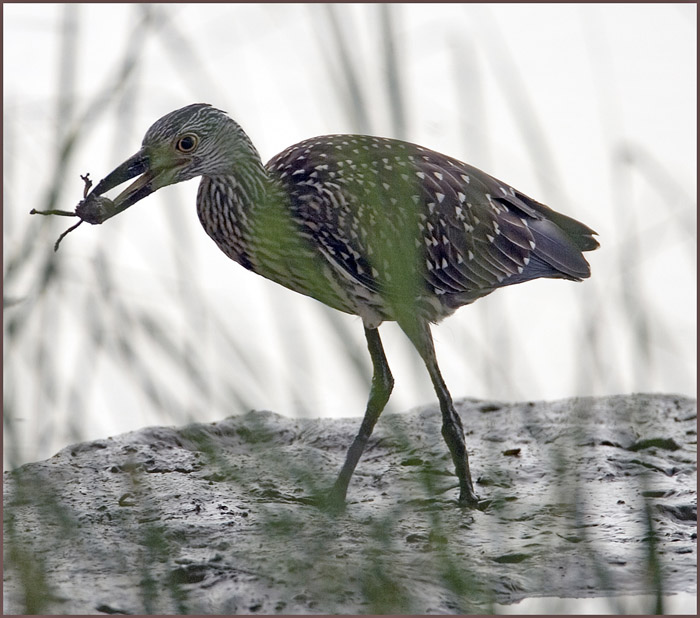
|
| I’d wanted to try to find some Fiddler crabs to image close up, so we looked for a site to do this during the time we were around Smithfield Station. Right next to the hotel is a bridge crossing the Pagan River and when the mud flat was exposed these critters would be in or around their holes or out scavenging for food. Some of the earlier Virginia shots have hundreds of these crabs searching the mud flats. We found a spot near the bridge embankment that looked promising, so I changed to the 70~200 f/2.8L lens and mounted the camera on the tripod ball head. These images were taken at this time. Bryan pointed out that this particular crab was about as large as he'd seen in the area, perhaps 1.5 inches across the shell. |
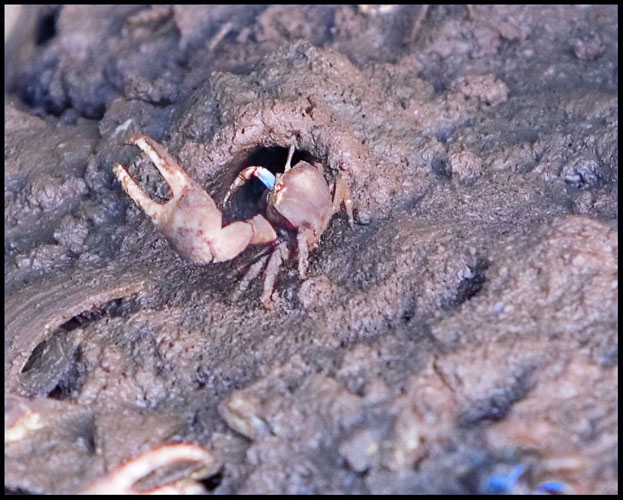
|
Keep in mind how small the image scale is here. The blue crab at right in this image has a body width no larger than perhaps a dime. The largest crab in view may be just over an inch not including the large claw.

|
| There were two areas we wished to check out, a new site in the Town of Isle of Wight and one we’d visited before called Nike Park. Nike Park has athletic fields and trails going into the woods but generally has a lot of activity and people around. We were looking for songbirds so this wasn’t problematic as long as they weren’t right where we were attempting to image. We traveled to the park one day after work about an hour or two before sunset and obtained a few bluebird images as viewed here. There were the usual Great Blue Herons and Great Egrets but we didn’t shoot them. There were people by the river so this wasn’t conducive to allowing a close approach to the birds. |
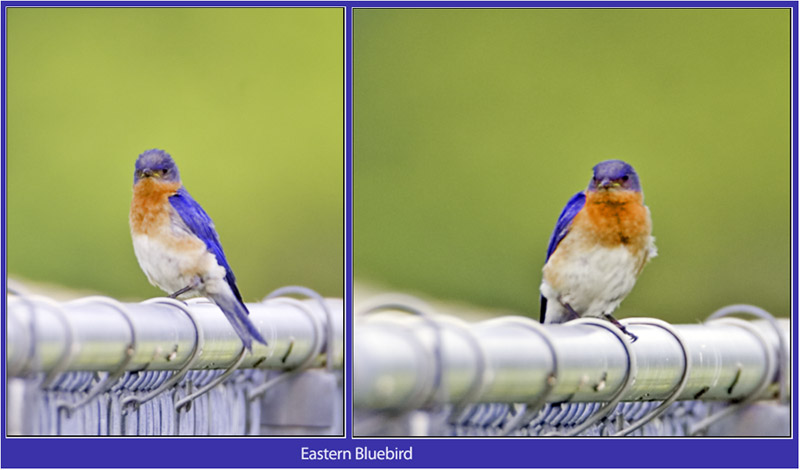
|
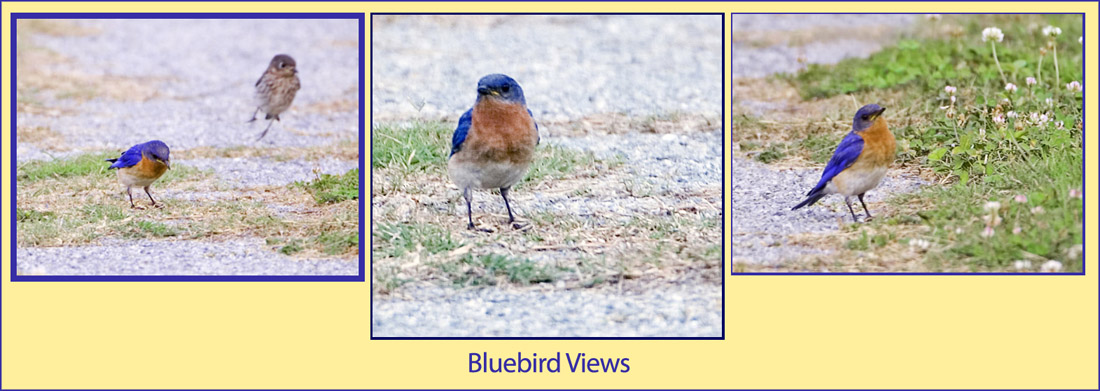
|
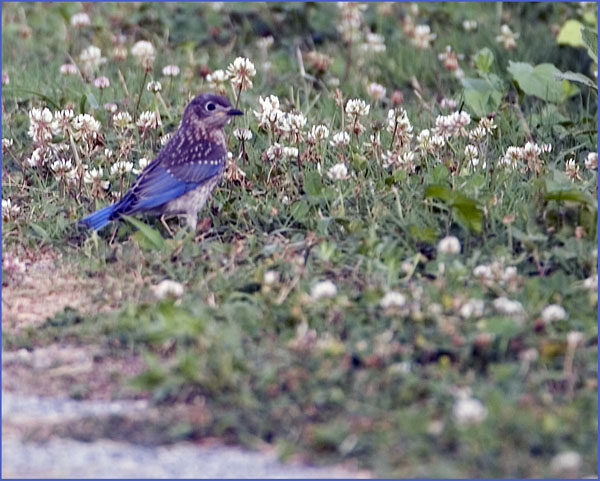
|
Before leaving the Nike Park images section, I wished to post this photograph because it indicates how beautiful these birds are. There were examples of many age groups in the birds we looked over, mostly on the ground seeking sustenance. |
Bryan had been investigating a still water area near a State Park in Isle of Wight County. I didn’t realize it at the time until we arrived, but this park, Fort Boykins Historical Park, was a military installation located on a bluff above the James River. The site of Fort Boykins has been a part of US history since 1623. ‘The Castle’ as it was known earlier, was later named after General Francis Boykins, a merchant and a one-time sheriff of Smithfield, who served on George Washington’s staff in the Revolution and was used by the Continental Army during that period. It was built in the shape of a irregular seven-pointed star, common construction for that time and was manned in the War of 1812. In 1813 two British warships were sunk by the guns of the fort. Later the British attempted to storm the fortifications from the river but were repulsed. Refortified during the War Between the States (aka the American Civil War), the fort served to protect Richmond from the 1862 Union Naval incursions up the river, when it was found the fort’s heavy weapons couldn’t be depressed enough to fire upon ships in the James although returning fire from the river was effective. Afterwards the fort was evacuated and abandoned by the Confederacy. The fort was later partially destroyed by Union Naval forces coming up the James and no longer served the South in the war. Portions of the fort remain although some sections have eroded off the bluff and into the river.
Looking at the area it appeared ideally situated for this type of defense. It was also a decent place to image from, whether shooting down on the birds along the river from the bluff, or along the wooded trails that form part of the park. We later figured out that we viewed only a portion of the park and will investigate this further if time permits on another trip. There were houses in the area and we didn’t wish to get onto private property, not knowing the lay of the land. We managed some respectable images from this location in the time we spent there, but the songbirds were a bit elusive.
Shooting from the bluffs above the river was interesting although not much could be done to improve the image scale as the area was fenced off. I’m sure the State was concerned that someone would attempt to get down to the river, or worse, fall over the edge. The following shots were taken from this location.
| This Eastern Kingbird snagged this feast in the grasses just on the other side of the fence from where we set up. Afterwards, the bird perched on the branch where we took this image. This tree was below the bluff and had potential to be a good spot except the activity level wasn’t great when we were there. |
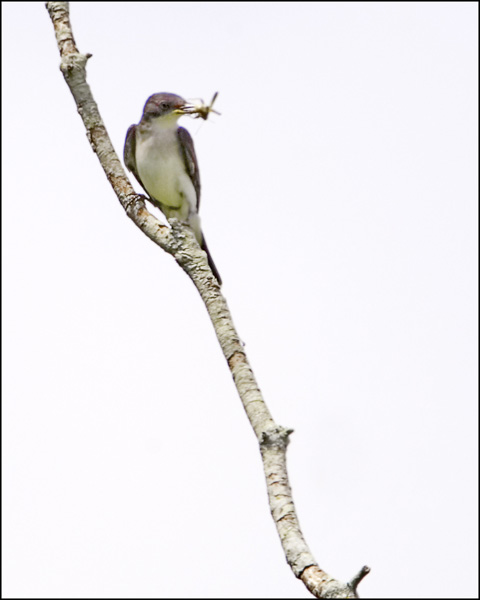
|
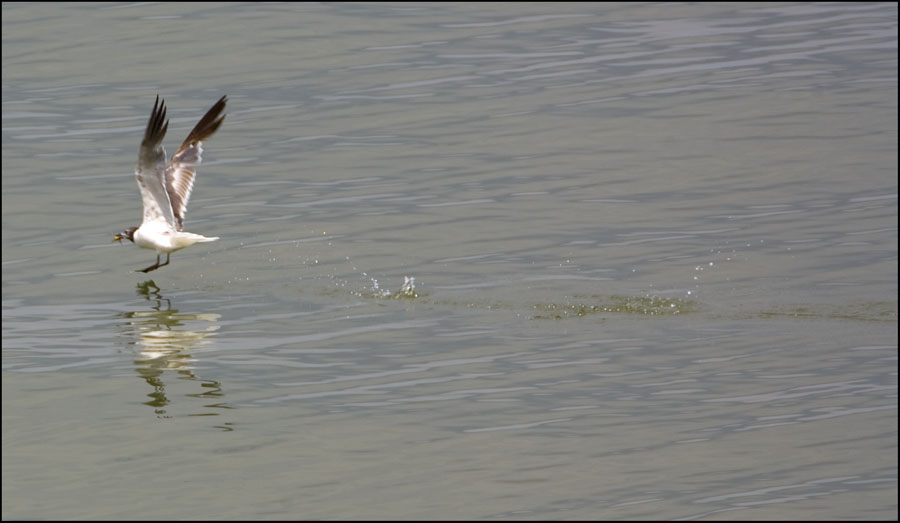
|
This Laughing Gull skimmed the water below us and I was able to get this exposure as the fish was snagged. I kept the crop large enough to see where he touched the water and still retain the reflection. Below us we viewed some Great Blue Herons lounging, many seagulls and a few other birds. |
| I took a series of images of this Cormorant in the water and flying around. I processed several versions but didn't wish to post multiple images where the images scale wasn't as large as I'd prefer. |
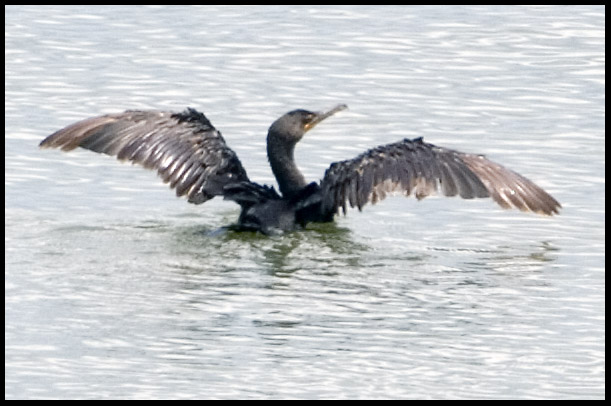
|
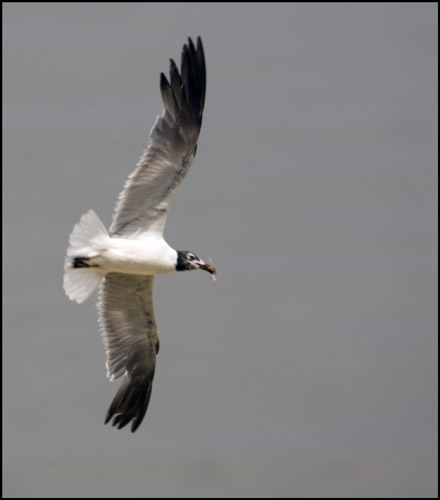
|
This gull was actually flying below us providing an opportunity for me to get a shot on the wing. If nothing else, it was good practice as panning birds on the wing is no simple task when they fly erratically. |
| On the way back to the parking area we viewed a pair of cardinals. The male was elusive and was no where near us but the female landed in a tree above and I was able to get a fairly close image of her. We also saw some flickers, tree swallows and a few other varieties of birds including a hawk flying overhead. We waited to learn if the hawk would come back our way so we could try to obtain a wing shot, but the bird must have kept going. We packed up and left the park shortly after this shot. |

|

|
On the way into the park - a gravel road, we passed by several small bodies of water filled with a great deal of algae. One had a public boat launch into a swampy area that appeared to be ideal for bird imaging, except that most of the activity was across the water from where we had access. We decided to make an early morning visit here to see what we could find and the next morning, this became our destination after sunrise.
Where it’s so hot in Virginia I always had the air conditioning on in my hotel room. After the last visit, I learned that you need to keep your lenses out of the room because once they acclimate to the cold overnight, you have instant condensation as soon as you get outside in the warm, humid air, even in morning. This happened to us several times and waiting for the Sun to clear the optics is a frustrating time as you really can't, or shouldn't wipe off a coated optic. This is just like my experience with telescope optics, no different except one doesn’t require dew prevention equipment to image during daylight hours. So, I left the 500mm f/4L lens in Bryan’s truck overnight so we didn’t have to experience this condition allowing us to commence shooting as soon as we arrived and set up. This location proved to be a good one first thing in the morning and offered us a different variety of birdlife.
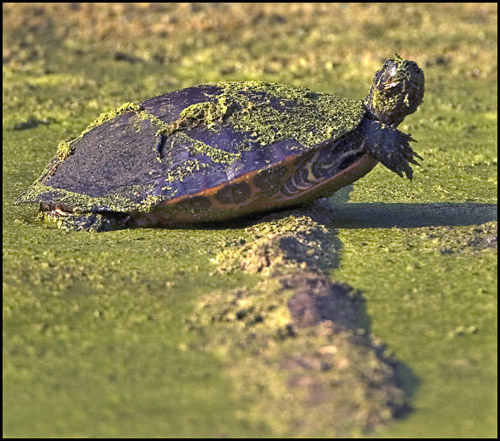
|
We came across this large turtle sitting on a log on the opposite side of the road before we got to the boat launch. This animal was fully two feet long, maybe larger and wasn’t really too far off the road. I didn’t wish to approach closer so shot this image from the mid point of the road hoping no traffic came by in the meantime. |
| Head shot of the same turtle. The log this animal is resting upon was probably eight inches in diameter. The turtle went under the water in a fraction of a second. It's hard to believe they can move that fast when spooked. |
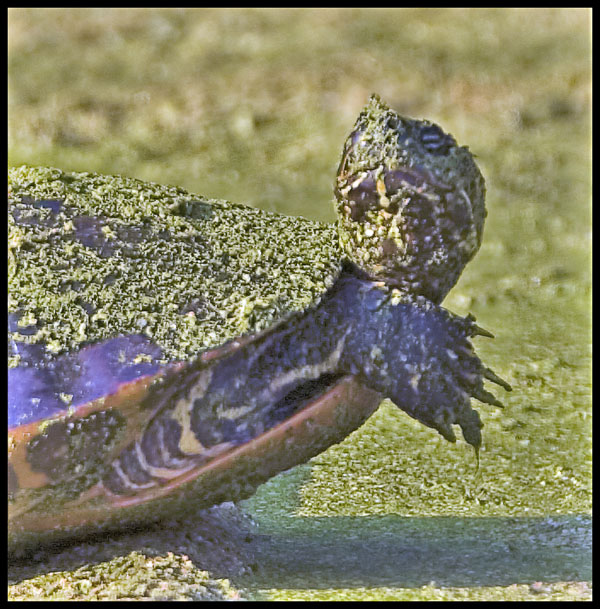
|
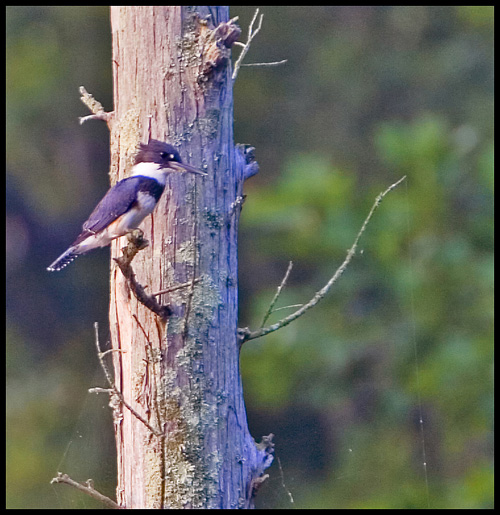
|
We were impressed with this site as soon as we arrived. We viewed a pair of Belted Kingfishers flying about and they became our first target of interest. There was a Kingfisher at the hotel site, but it was constantly flying and whenever it perched it was never in view. I got off several shots on these birds from a long distance; they’re not large, so the image scale wasn’t great and the exposure wasn’t premier either. |
| One bird came back and perched on a dead tree closer to the camera. At 700mm, this was as close as I could get and obtained this image. |

|
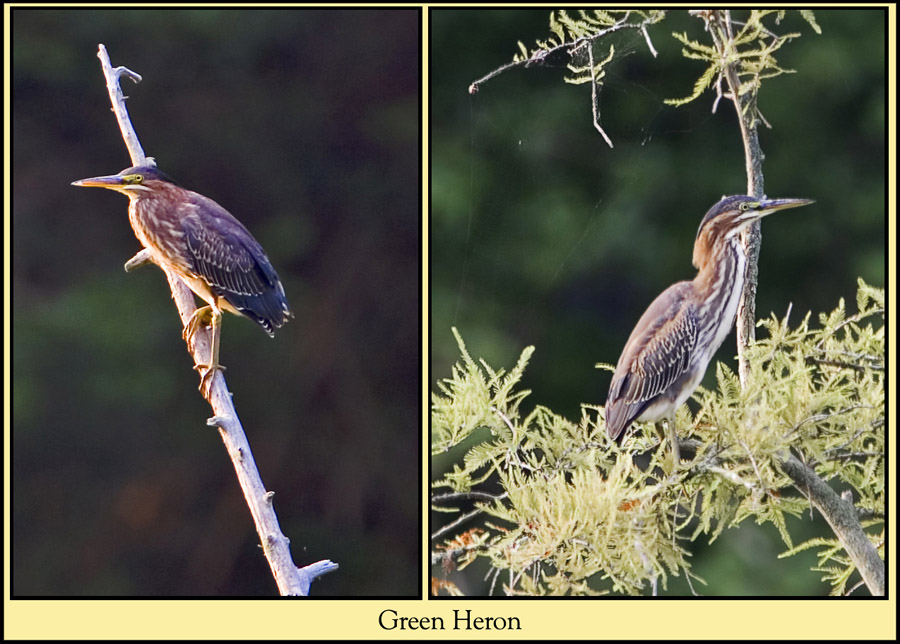
|
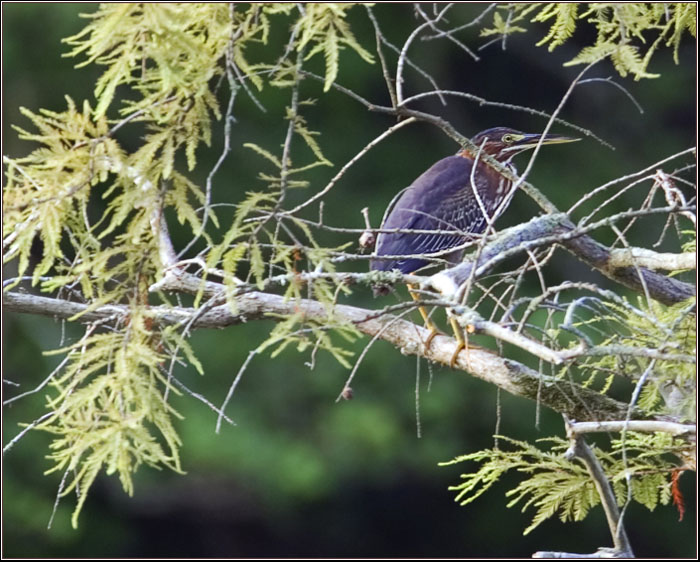
|
I kept this image a bit larger to show off the beauty of this beautiful heron. They really are shy and not often viewed in the open. I was particularly pleased to be able to obtain these images as these herons are not prominent in Maine at least to my knowledge. |
| I imaged this dragonfly about as close as was possible shooting with my longest lens at 700mm. I turned off the autofocus and just got within the manual focus range to get off three shots on this creature. The detail in this image is excellent as the dragonfly was no longer than two inches. We figured this tree branch was no more than fifteen to eighteen feet from the tripod. There were dragonflies all over the area but trying to image one was nearly impossible as they stayed constantly in motion. |

|
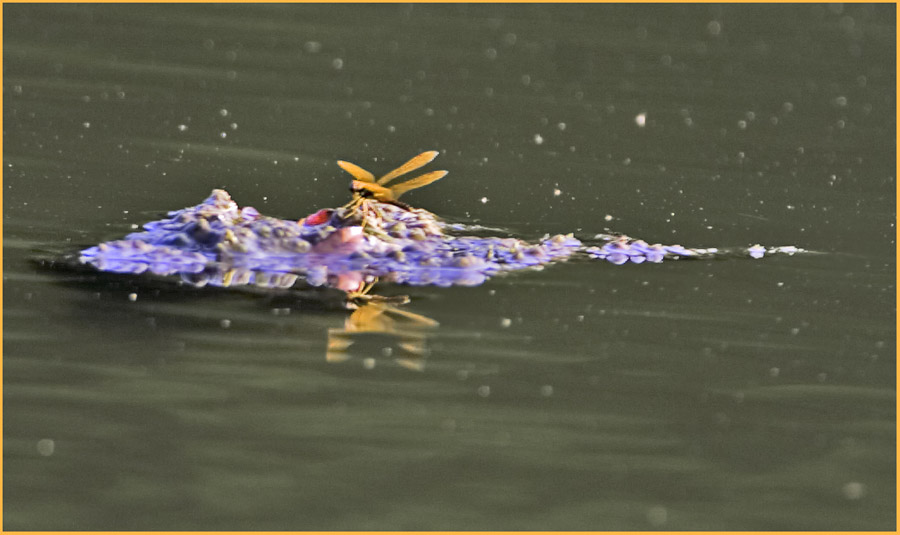
|
This particular specimen did stay in one place for some time. Unfortunately, the perch was out near the middle of the swamp and the insect was really small. I shot this dragonfly many times and just couldn’t get an image I was satisfied with. This one isn’t great or as detailed as I’d hoped, but it indicates the color and has the reflected image in the water. It will have to do for now until I can improve upon it. |
The last two images from this group are simply outstanding im my (humble) view. Several of these birds were flying around and exhibited wing and tails colors that I was not familiar with at all. I had no idea what they were and don’t recall ever having seen one before. This bird perched in a tree to the left of my tripod, near the tree where the dragonfly image was taken. It was great, about as close as I could ever hope to be and with a clear line of sight and good lighting. Bryan and I make a point of staying still and moving as little as possible hoping for opportunities like this and it does pay off at times. When I first viewed the mandible on this bird, I thought it was in the shrike family as it also exhibited a hint of an eye mask. Once I had an opportunity to investigate some sources, I quickly realized I had imaged a Yellow Billed Cuckoo… to my knowledge, I’d never even seen one before and I was astounded. Even more surprising to me, these can be found in Maine… These are some of my favorite images from the time I had to shoot on this trip.
| Yellow Billed Cuckoo - Pronounced just like the Cuckoo clock - this bird is closely related to the Roadrunner according to the Sibley Guide. I found these to be beautiful, a dark beak above - nearly blue in my image with a bright yellow below; a hint of red on the wings and a white belly. They also display white tail markings in flight. |
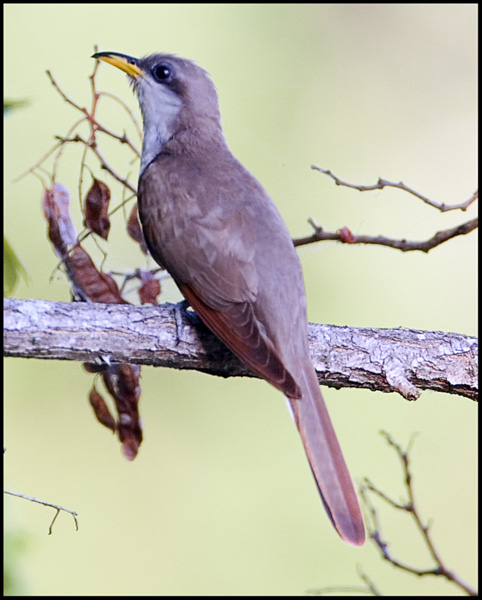
|

|
This is a smaller image scale of the same bird, which I believe nicer in composition with the color surrounding it although it is a centered composed, which I don't do often. I obtained three good images, two which are shown here. The image scale was good and the focus and detail excellent. This file is large enough to create a spectacular 16" X 20" print, which I'll do eventually. I look forward to an opportunity to image this beautiful bird again another time. |
This ends my file upload from this particular visit to Virginia… I won’t be back in July and August is just around the corner. It’s difficult to say if my schedule will permit another imaging session in this area, but I certainly plan to take advantage of any opportunities that may be presented. Besides, Bryan will most likely find some new areas to investigate…
I took the fine folks at Smithfield Station a group of prints when I was last there, my favorite Ospreys and some songbirds and a few others posted in this article. These were well received and I only brought images from right around their facility so they could show their customers what’s in the area if they express an interest. They have a large expansion under construction and I gather they will be interested in using some of my images in the new building for display purposes.
___________________________________________________________________________
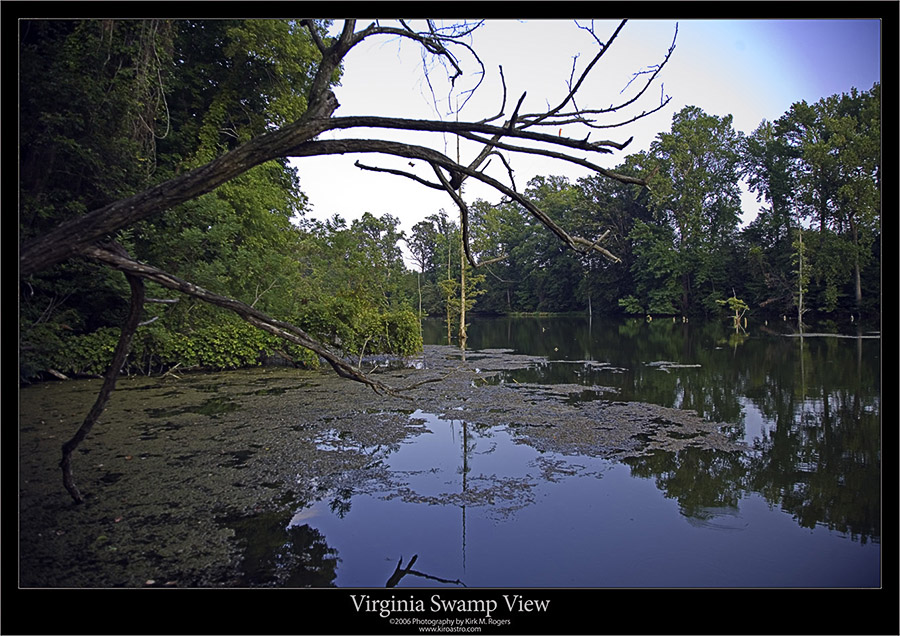
|
My monthly trip to Virginia found me back in the area from August 28-31, 2006. Once again I carried my camera gear so Bryan and I could try our luck imaging what we could find in the areas we frequented. However, this trip was different… My flight out of Portland was cancelled outright and while in the airport a discussion ensued about what all the bumped passengers would do next. It didn’t take long to figure out no seats on outgoing aircraft were available and there was talk about taking a airline provided bus to Boston to make connections. I could see where this was going and determined the best course was to take positive action to ensure getting to the meeting the next day - drive to Virginia. I telephoned for a ride home, re-geared and started driving south. It was just less than 800 miles to the hotel and I didn’t arrive in Smithfield until about midnight.
Obviously this prevented any chance of imaging the day of my arrival and although it was a much later night than planned, Bryan and I discussed this via cell phone. We elected to revisit Fort Boykin Park and to check our favorite swampy area (the boat ramp) along the way in the morning. He arrived early and using my truck so as to not unload and repack the camera equipment, off we went.
| The flat gravel area in this image is the end of the ramp where I set up my tripod when imaging at this location. There is litle choice otherwise short of getting in the water. |
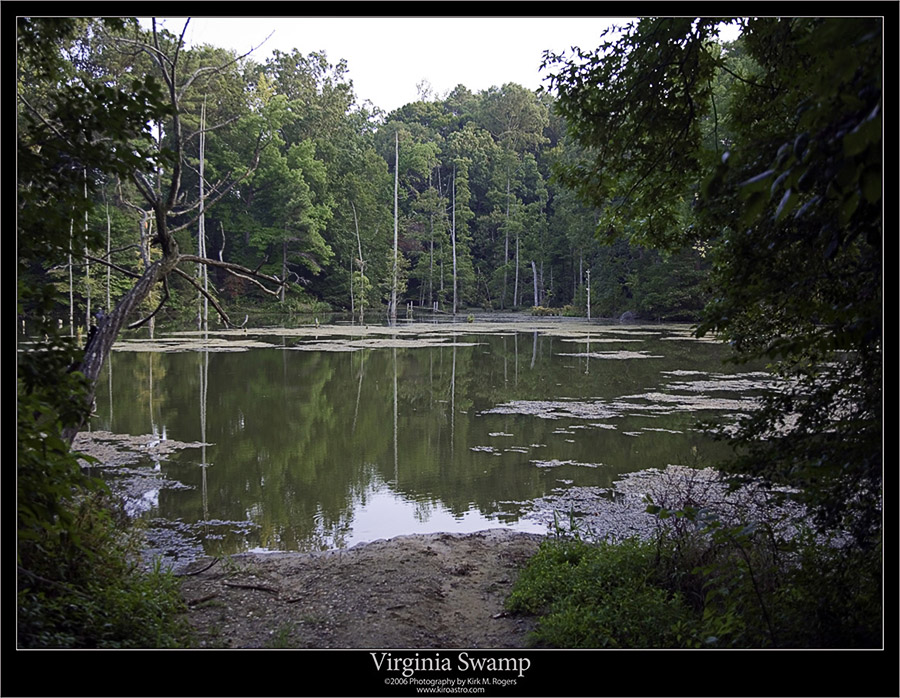
|
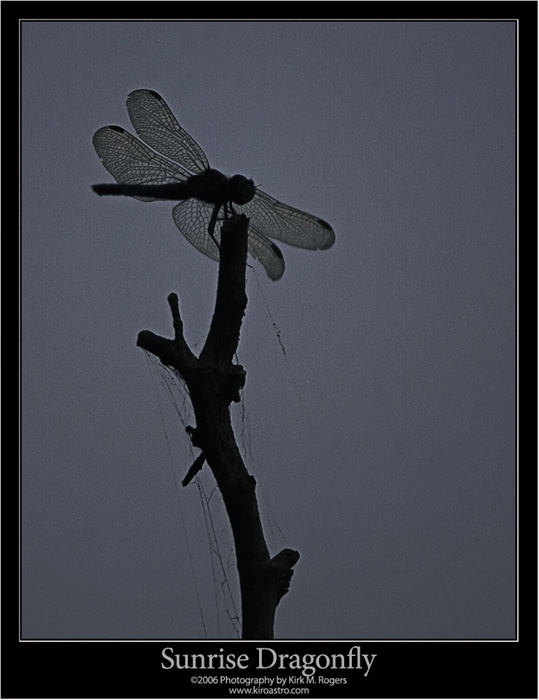
|
The boat ramp was quiet without much stirring. A Belted Kingfisher was perched in a tree but as soon as I walked down he quickly left the area. Even from across the water
I was either perceived as a threat or simply disturbed the tranquility of the morning scene. Besides the kingfisher, the only other bird in sight was a Great Blue
Heron and this bird also flew noisily away; they have a distinctive, honking voice. The light was dim and it would be sometime before the sun was high enough to
illuminate the site. No birds were in view but there were many dragonflies about, some flying/perching then flying/perching again near where I set up the tripod.
Shooting with my 500mm lens, they were about as close as I could focus and we took multiple exposures of several nearby.
This tiny dragonfly was imaged sitting on a branch. Note the web remains hanging off the twig. |
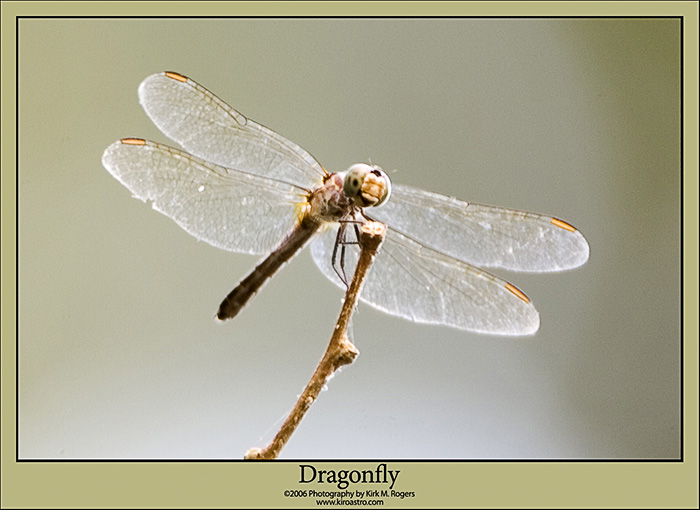
|
|
We didn’t linger long in this area. We knew the lighting would be better at the fort with greater opportunities to image birds that live in that setting. We packed up and moved on.
Upon gaining entrance to the park, we took some lenses, the tripod with camera and lens mounted and walked in. As we arrived, I viewed a Red Tailed Hawk sitting on a pole watching over a field seeking breakfast. I was hoping he would stay a bit and we stealthily walked down a gravel road behind him. The bird was aware of our presence and I took the following image of him looking over his shoulder right at me. |
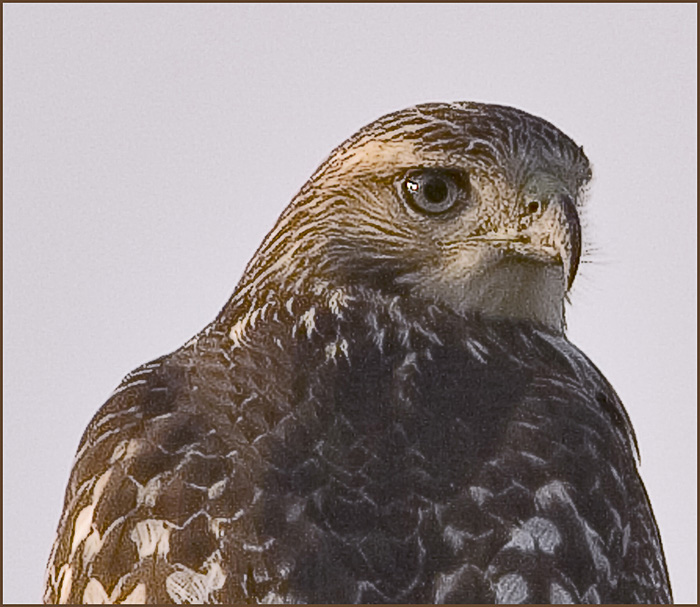
|

|
Afterwards we viewed some other birds near us including a Brown Thrasher but we weren’t able to locate this bird in the brush to get an image so we headed
towards the James River overlook. On the way I spotted a spider on a single web strand climbing upwards.
I placed the tripod down and took a few exposures.
There’s a dying tree near the bluff overlooking the river that makes a great perch for imaging birds. I always check this tree to see what can be found. While I was checking things out a beautiful finch like bird landed in the tree. I couldn’t see the bird’s colors well in the lighting but I was fairly close and shot a series of images. Once I had an opportunity to investigate these files on the computer I verified my identification - this beautiful bird was a Blue Grosbeak. I don’t recall ever have seen one in the Northeast. |

|
|
We walked back to the bluff and Bryan spotted a group of fins moving rapidly in the James. He pointed this out to me and it
became clear that this was a dolphin group chasing a school of fish. I quickly re-set the tripod and shot a series on the rapidly moving group.
I was fortunate enough to get several shots of the dolphins when above the river. This photo, taken from quite far away, is what I supposed to be a mother and
young dolphin in pursuit of the fish.
As we were exiting the bluff area, I again looked back at my favorite tree. There was a Kingbird perched there and every so often the bird would fly into the wind playing in the gusts and then re-perch. I moved closer and took several shots of this bird sitting at the top of the tree. |
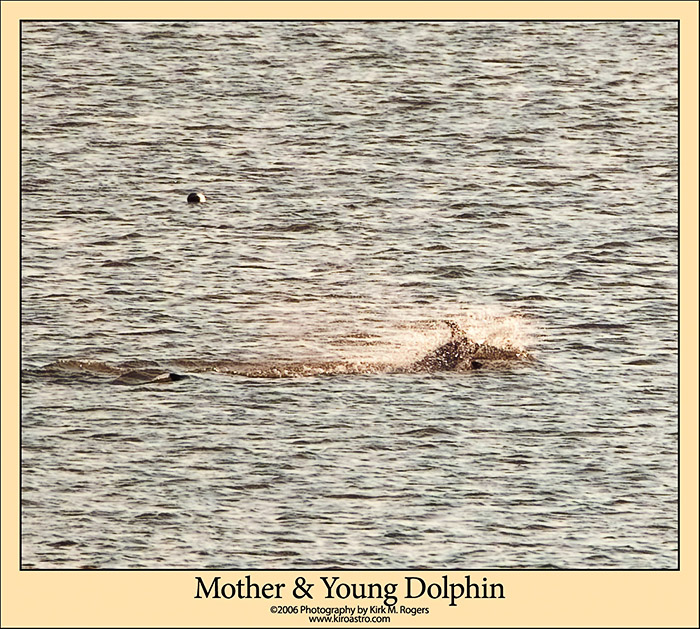
|
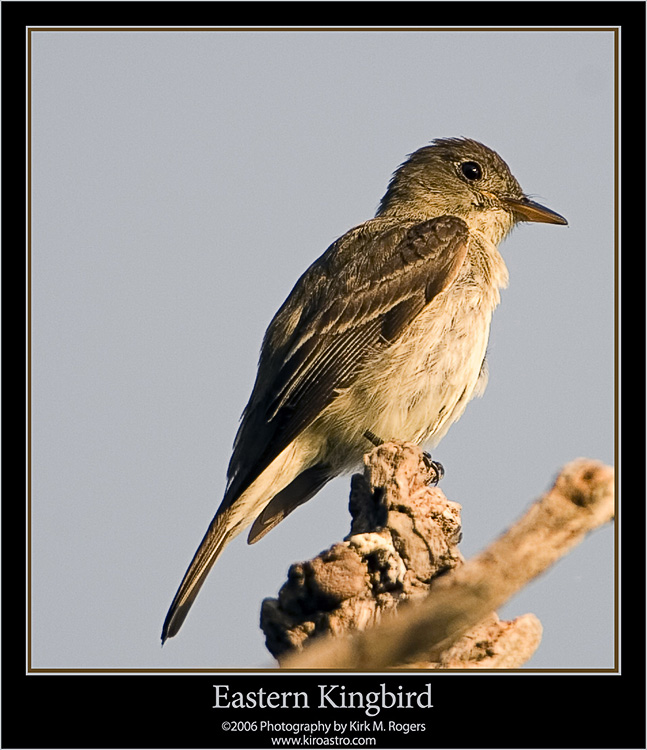
|
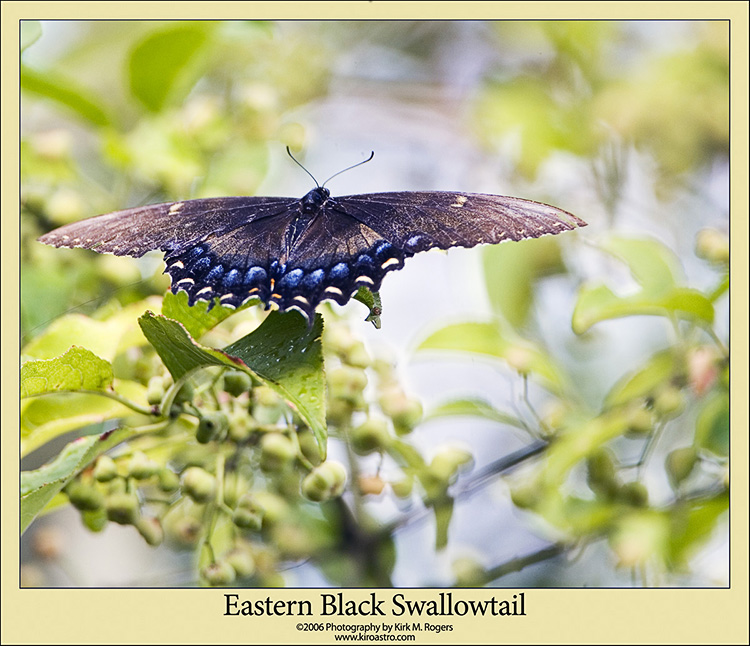
|
There was a portion of the park that we hadn’t visited previously and we’d determined to check this out next time we visited. So we walked the path to see what we could find. This path went through the trees to several open areas, each segment offering a different view and possibilities. One clearing we entered had many butterflies in flight and we followed several of these visually until the landed so we could get some images. The two Swallowtails we imaged can be seen here. This was my first attempt at shooting butterflies and both were imaged at 700mm. |
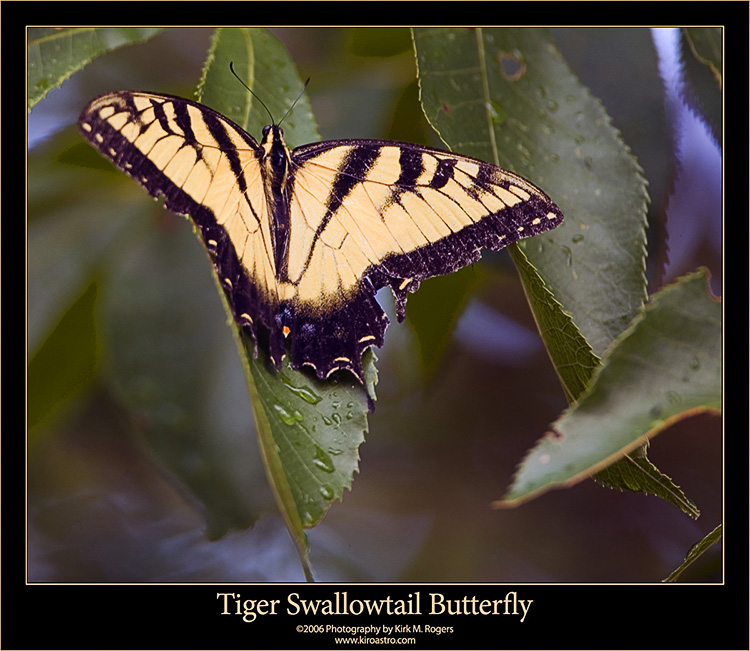
|
| We noticed many spider webs in one section as we walked down the trail. The sun was getting higher as we discussed this so we decided to find some that were backlit, which is near perfect for this endeavor. We shot several using the sun to our advantage. In one case I couldn’t get far enough away, so pulled off the extender and shot a web partial at prime focus – 500mm |
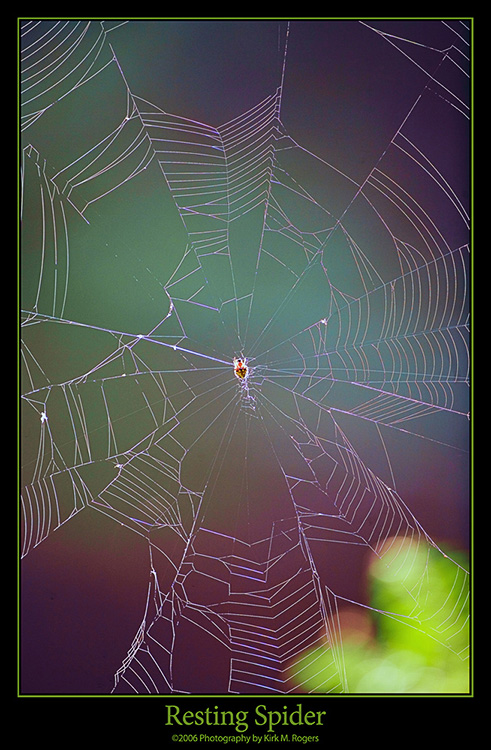
|

|
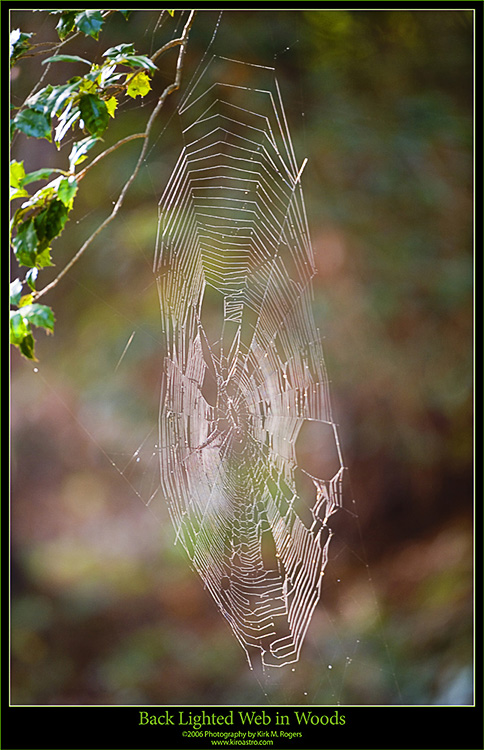
|
These webs are nearly invisible walking the paths unless you happen to catch them backlit by the Sun. |
| Shortly afterwards we entered a large clearing surrounded by forest. We viewed a pair of Ruby-Throated Hummingbirds around some flowers high in a tree. We walked over but the tree was so high that obtaining a decent photograph was unlikely as they were quite far off. What we did see was a wren in a pile of brush in the clearing and I moved over to set up for an image. I shot this bird multiple times and ended up changing to a higher ISO rating as the images were indicating motion. The sun wasn’t yet high enough to illuminate the clearing that early in the morning. I did get several keepers from this group as can be viewed here |

|

|
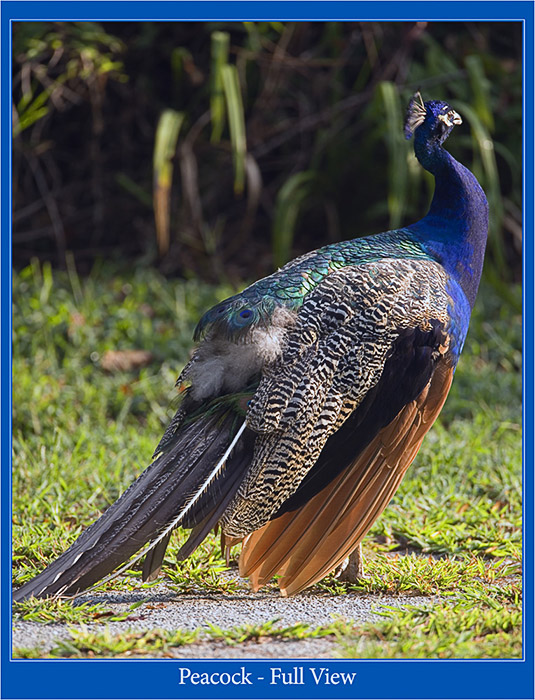
|
Our friends Renee and Allan had indicated that one of the families that served as caretakers in the park raised Peacocks at one time. They’d asked if we’d seen any of these previously and we actually had although we were never close enough to get a good look. On this particular morning we viewed a pair of Peacocks foraging as we walked out of the woods heading back towards the parking area. I still had the long lens on the camera so getting an overall shot was difficult and we had to wait as they moved around to accommodate the image. The images I selected from the series can be viewed below. |
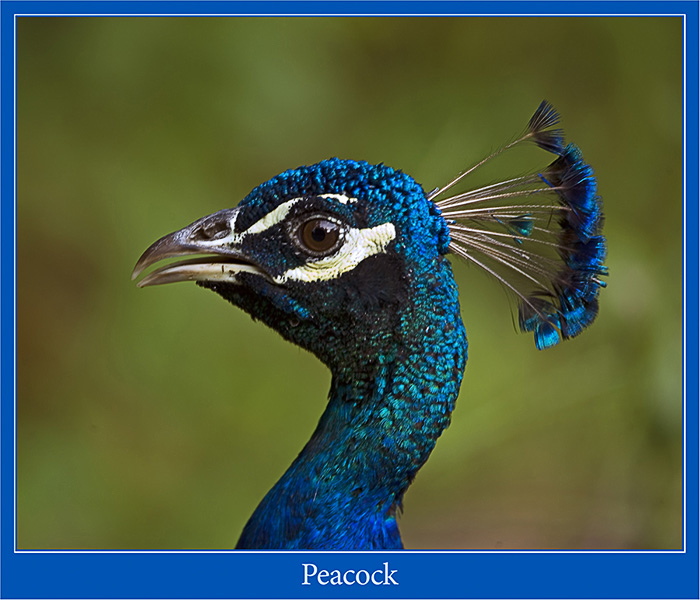
|
| By now we were checking the time as we had to get to the project to start the workday. As we walked down the wooden stairs towards where we left the truck we viewed some birds at the bottom of the stairs, flitting around in the trees and on the ground. One was a male Cardinal, a common bird but one I’d never obtained a definitive image of yet. We waited while the bird changed position several times, hoping to get the Cardinal illuminated with sunlight. Finally the bird perched on a tree and I shot several exposures at a reasonable distance for detail as can be viewed here. This ended or imaging session for the day and we were off to work. |
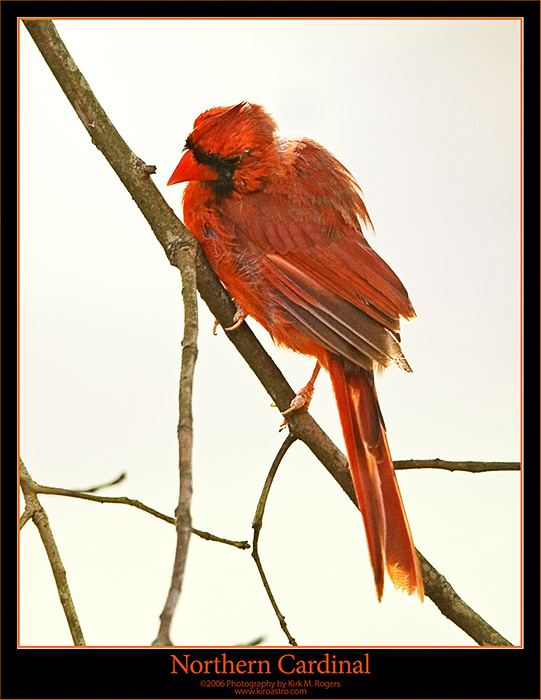
|
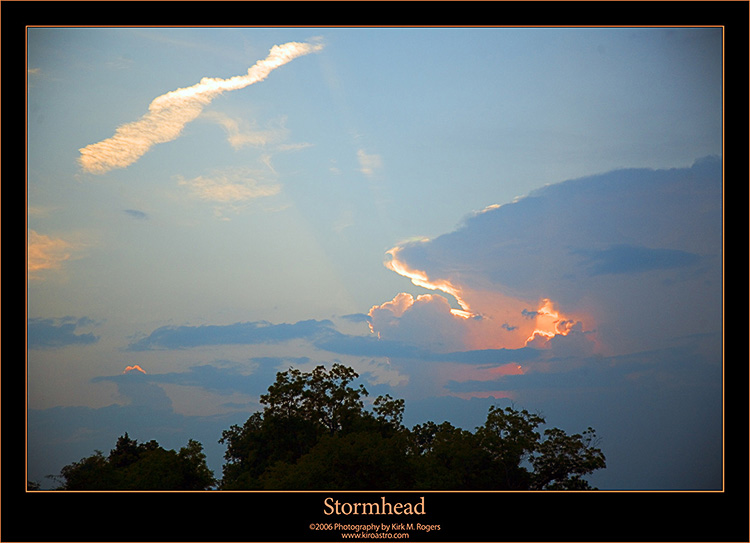
|
We’d been watching the weather as Hurricane Ernesto moved up the coast and the forecast was indicating high winds and heavy rains would be entering into the area. I was concerned about this, but where I had my vehicle this time, could set my own schedule for the return. The sky conditions were definitely starting to deteriorate and storm clouds were forming. After work, later in the day as I returned to the hotel, the cloud formations looked threatening and lighting could be observed in the distance. I installed a short focal length lens on the camera and took several images of the storm head moving in. |
| The rain that commenced precluded any further imaging this trip. We had dinner at a wonderful restaurant with Renee and Allan that evening and in the rain they provided Bryan and I a driving tour of Smithfield afterwards, which proved interesting indeed. We plan to reciprocate next time we’re in town together. |
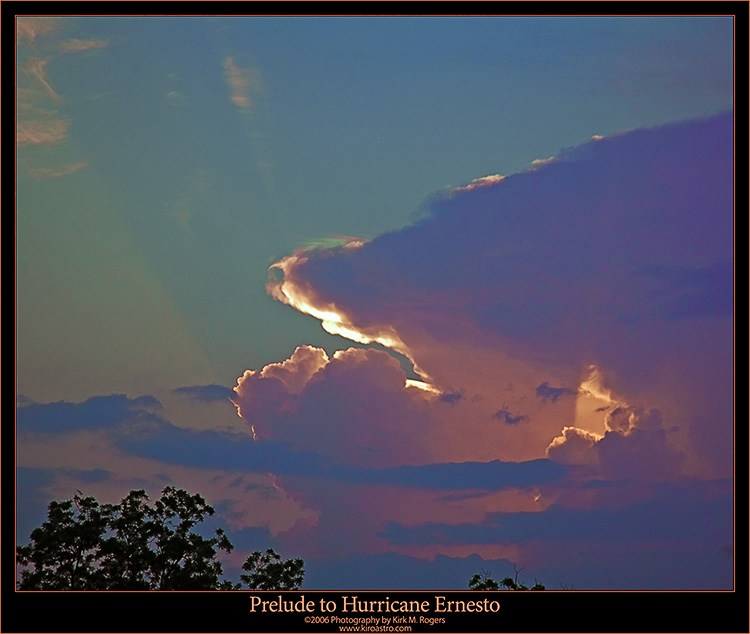
|
I’ll be heading back to Smithfield in several weeks for the September meeting and certainly plan to bring my imaging gear along. Once again we plan to visit our favorite areas, perhaps explore new ones and add some new images to this account.
___________________________________________________________________________

|
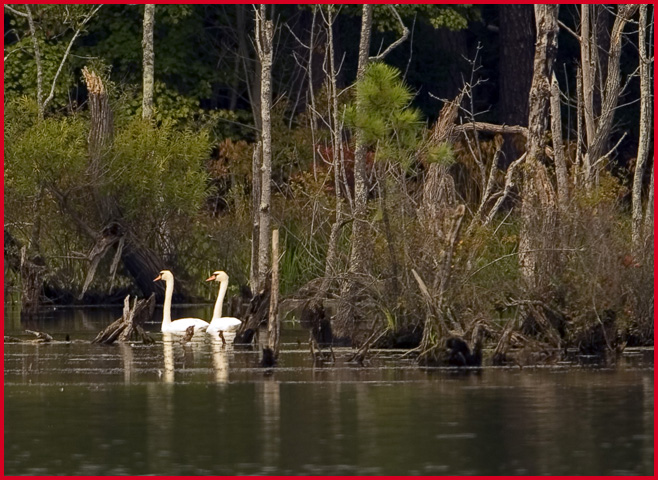
|
I returned to Virginia the last week in September to inspect the project and attend the monthly requisition meeting. I was pleased to learn the weather had cooled down and the humidity wasn’t
as prevalent as in the past months. Hurricane Ernesto had carried in an abundance of water through heavy rains and frenzied tides and the area was experiencing a bumper crop of newly hatched
mosquitoes. In consequence, the one time we visited the Fort Boykin site was cut short due to this hatching. Because I was unable to obtain lodging in Smithfield the Monday I arrived, Bryan picked me up at the airport mid-afternoon and we determined to stay in Newport News to take care of some errands rather than travel directly to the project. Billy-Bob was flying in to attend the meeting late afternoon as well and required transportation. Sunset was around 1900 hours so we decided to check out a spot locally to image before heading to the hotel for the evening. Bryan had found a reservoir that had a park constructed around it and we took a drive over after the work day was completed. |
|
Although we didn’t have much time, I could see this locale had merit and it appeared the park was well utilized by joggers, kayakers and other folks just wishing to take a walk
around the grounds. We followed some of the paths around the water and viewed the birds and activities. A pair of Mute Swans could be seen across the lake and I placed the
tripod down to learn what the image scale would be like from our location. We were shooting at 700mm with the 500mm f/4L lens and 1.4X extender.
We viewed a plethora of turtles everywhere and their heads could be seen above the surface as they just hung out and enjoyed the day. Bryan took an image of one of these and I later imaged some that were even closer from the bank. We discussed project issues and planning as we strolled the grounds. |
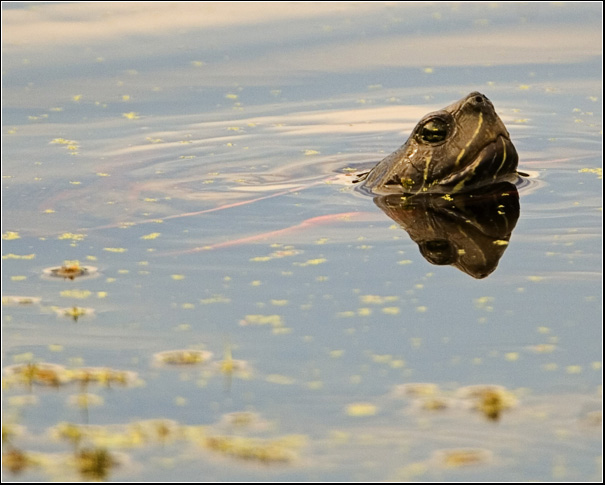
|
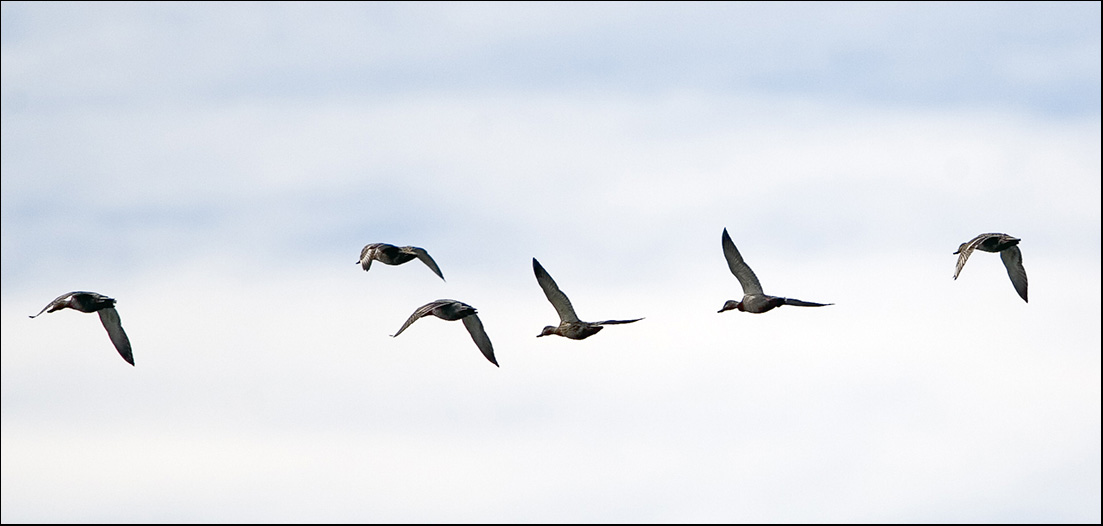
|
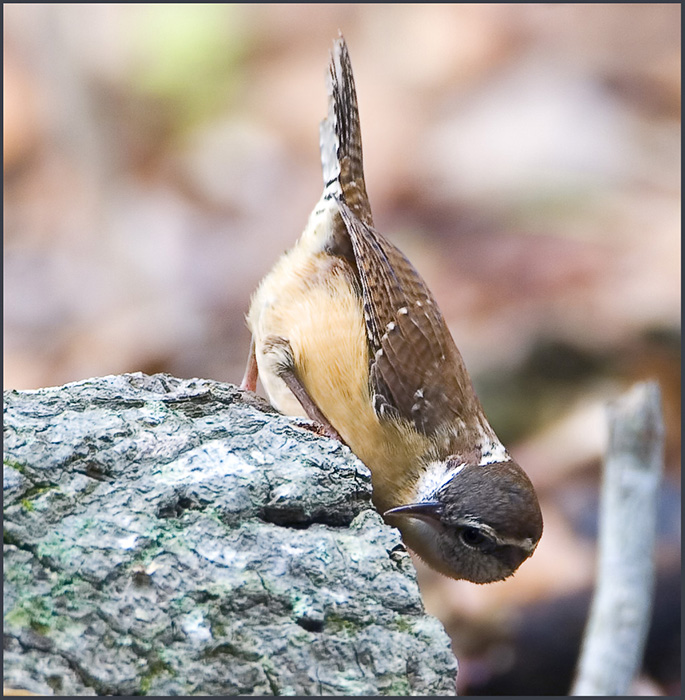
|
We weren’t really in the right locale for the lateness of the day in relation to the setting sun, but we viewed many ducks, mostly Mallards with some Wood Ducks mixed in
flying in a group to circle back and land on the water. As usual, we were mobile and didn’t have much opportunity to set up to image the group, although I did get several
exposures of the end of the bunch as they came in for a water landing. There were quite a few songbirds in the trees around us as we walked the path and I tried in vain to isolate one of the warblers flitting about to get a clear shot. I did get several exposures but no ‘keepers’. This was a disappointment as I was hoping to add a good warbler image to my life list. I later identified the birds from the poorly focused exposures as Magnolia Warblers although it’s difficult to be certain. There are times when using autofocus isn't the best choice and this was one of them. The branches and leaves can stop focus cold when the bird is behind them in the field of view. A Carolina Wren did pose for me long enough to obtain multiple exposures as he perched on a log. |
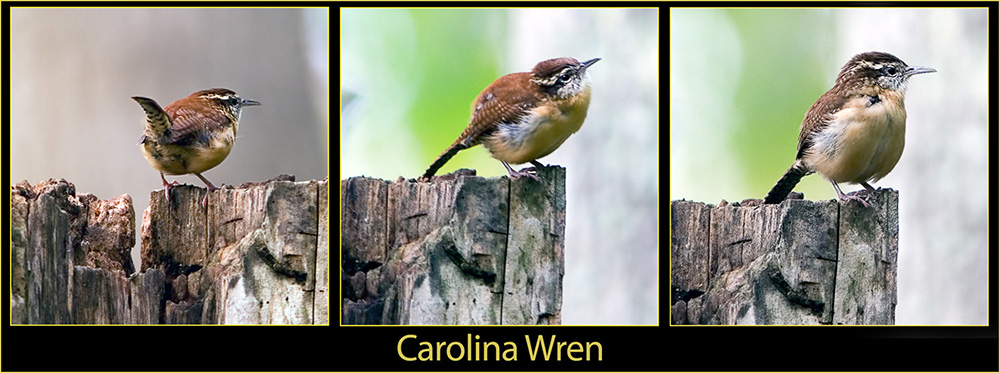
|
| I talked to this fellow as he put in although I didn’t plan to photograph him on the water. He came out of the tree line and I imaged him from across the way. The 500mm lens really is an exceptional optic. |
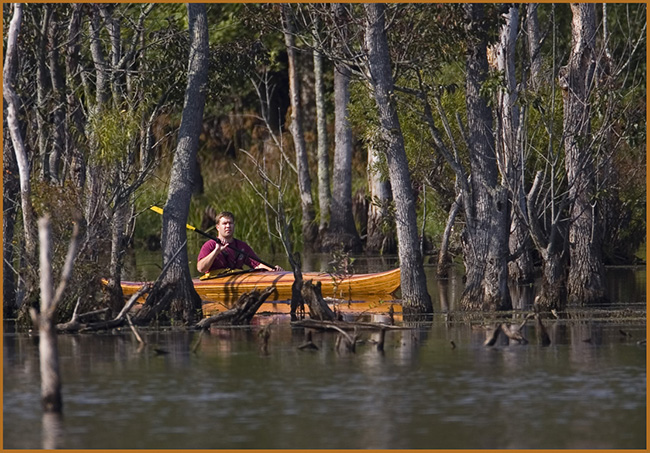
|
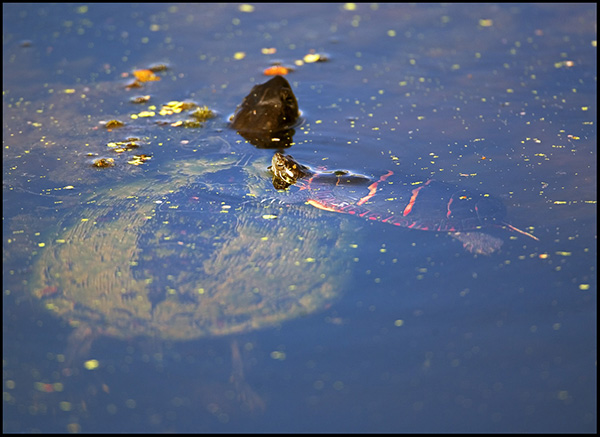
|
We watched this pair of turtles as the smaller one kept after the larger. We weren’t certain what they were doing, but after a bit the smaller one decided to use his bud as a float…
Shooting around the water has me investigating polarizer filters for the 500mm lens, something I should add to my gear.
|
| We could hear a raptor in the distance and decided to get closer to find out what was going on where the bird was sounding. As we approached my phone rang, loudly I may add and the hawk flew out of a tree near our location. I don’t know if we would have had an opportunity to image the hawk close up, but we did view the bird fly to a tree in the distance and continue to call. I took several shots of this fine specimen from a distance, still calling out to the neighborhood. |
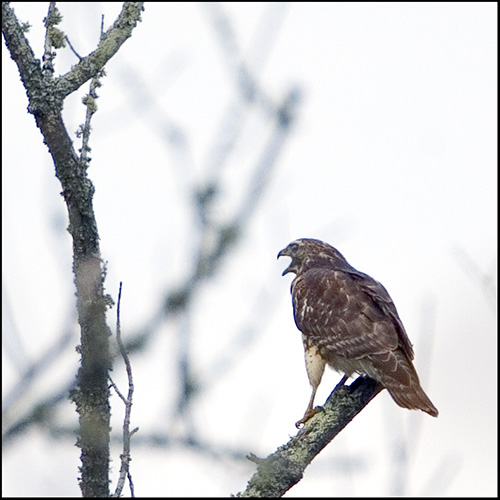
|
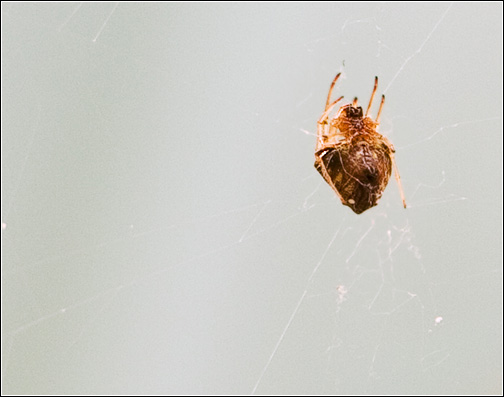
|
I noticed a spider web and walked over to see if it contained a spider or if the insect in the web was a victim. It turned out to be the spider but with the lighting
conditions I was unable to achieve a focus lock because of the background colors. I solved this by having Bryan stand directly behind the web. His pale green shirt
made the spider stick out and I took several images from around twenty feet away. In the cropped file you would never know that Bryan was the back drop…
|
|
We viewed a Cardinal in a tree with good lighting and I took a series of images of this bird. The first group was the better and he certainly was a handsome bird.
Later on the way out, I shot another Cardinal in silhouette, which I’ll include in this account.
We decided to head back to the airport and followed the path out to the road, where we would walk back to Bryan’s truck. Across the road was another small pond bordering a golf course and I walked over to take a look. A Great Blue Heron could be seen as well as a Great Egret. The Egret was closer than many I’d imaged in Virginia and I took my time trying to obtain a good image. Most were overexposed a bit but I’d bracketed enough that some good images were enhanced from the group. I shot some with and without the egret’s reflection in the water as can be viewed here. Afterwards, we packed up and left. |
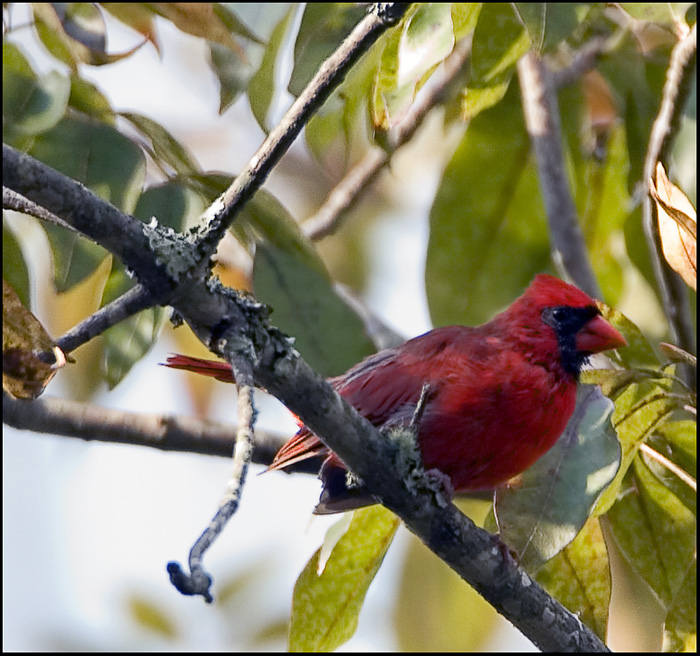
|
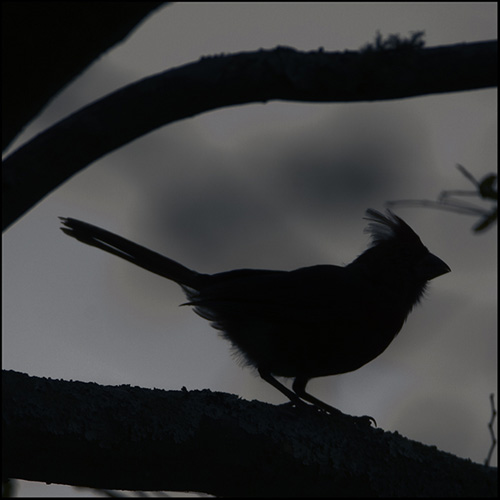
|
A Northern Cardinal perches in a tree in the darkened forest. This male was backlighted indicating his distinctive shape when this shot was taken.
|

|
|
As the daylight hours were shrinking with the advent of fall, we didn’t attempt to image in the mornings this trip. The project was active and as sunrise in Virginia
was nearly 0700 hours, there wasn’t time to shoot before commencement of the workday. Between this and other work obligations there wasn’t time to do much overall.
I use my camera for work related shots anyway, so we kept the gear handy in the event something of interest cropped up.
We had our requisition meeting mid-day on Tuesday and everything went well. After work hours, Bryan, Billy-Bob and I decided to take a ride over to our favorite swamp area and on to Fort Boykin Park to check things out. This location is near the project site so we got there shortly after 1700 hours. Just before you arrive at the boat launch, there’s water (and green slime) on both sides of the roadway. There were the usual turtles sunning on logs and I got out of the truck checking if anything else could be viewed. Often the tree line by the water has herons, kingfishers and other birds perched quietly that can be viewed if one makes a stealthy approach. |
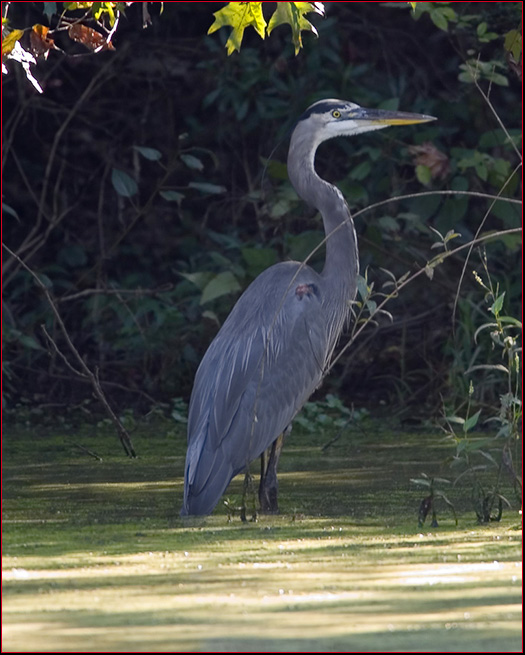
|
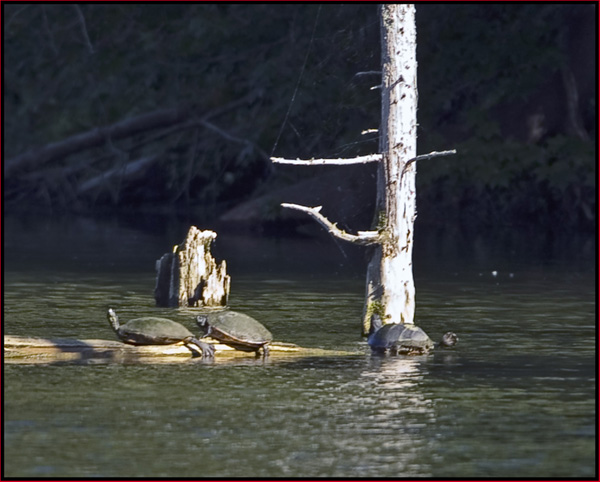
|
We were surprised by the many turtles we viewed this month. These critters are always around but there were many more visible than anytime before over this September week.
|
I’d never imaged anything of interest on the water opposite the launch ramp except a turtle, but Bryan noticed movement in the undergrowth near the water. As we watched a small Green Heron immerged and walked down a tree branch near the water. The heron waited patiently and after a few minutes snagged a small fish from the water. The heron walked around the tree with his catch in beak as I shot a series of exposures of the event. This bird was significantly closer to my set up than the Green Herons I’d shot across the water at the boat launch and I was pleased about this sequence overall. We left here and went to Fort Boykin where we were quickly bombarded by many, many mosquitoes. Worse than that, we didn’t see any birds and my favorite tree wasn’t much help in the afternoon. It’s a morning location with the rising sun and as the sun sets, there’s no way to set up a tripod behind it to shoot from the other direction. It didn’t take us long to figure out we were in an uncomfortable spot and it was time to move on.
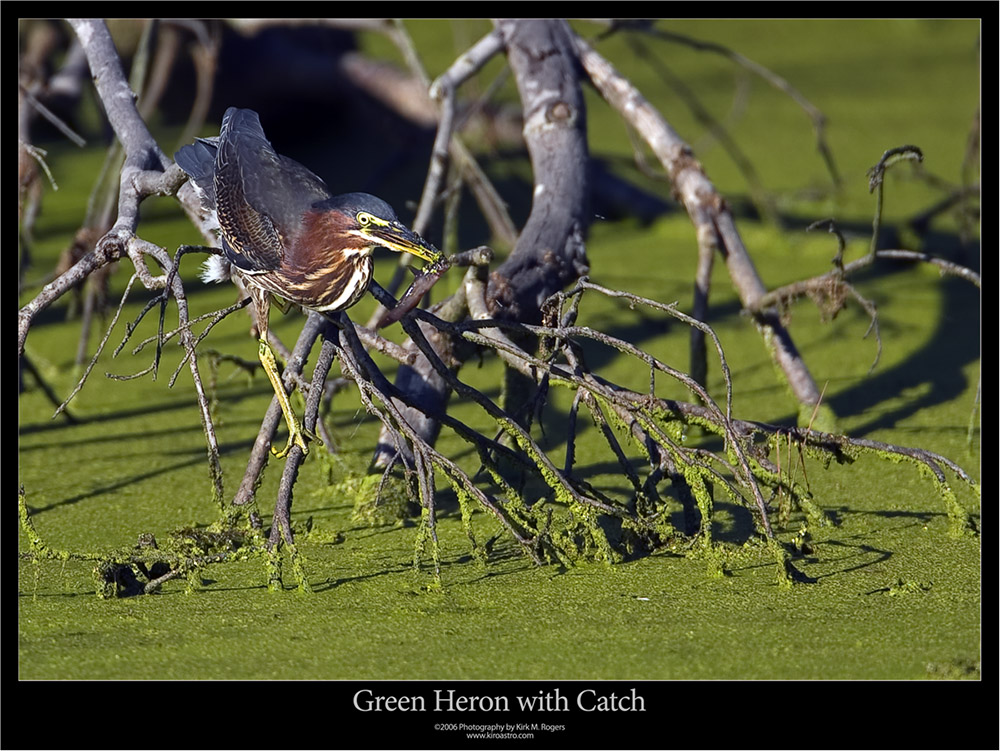
|
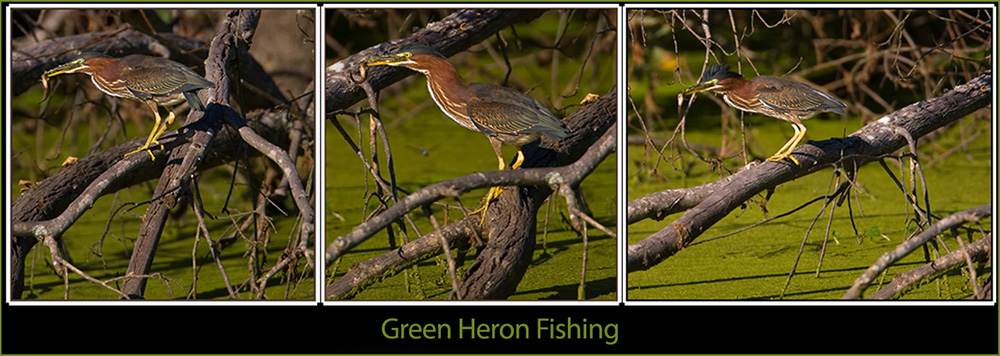
|
| We placed the tripod, camera and lens in the back of the truck to keep it accessible as we traveled back to Smithfield. As we drove along the fields of cotton and soybeans a Turkey Vulture swooped low over the road and landed in a tree to our right. I asked Bryan to stop and I grabbed the tripod to see if I could get close enough for a large image scale exposure. I’d been shooting these vultures on the wing all summer and never really got the image I’d been seeking. This is the first one I’d actually viewed perched and I definitely wished to give imaging it a try. The vulture watched my approach; there was no way to remain inconspicuous with low fields on either side of the road. I didn’t watch him and looked around like I didn’t realize the bird was there and avoided walking directly towards the tree. When I believed I was getting close enough to spook the vulture I stopped to get an ‘insurance’ shot – something’s better than nothing and this bird was closer than the average shot in flight. I took some images, checked my histogram, picked up the tripod and started moving closer. The vulture took flight but didn’t go far; he lengthened the distance to about the same as the first group. I moved as close as I thought I could get away with and was fortunate enough to capture several wing stretches during the few minutes all this took. |
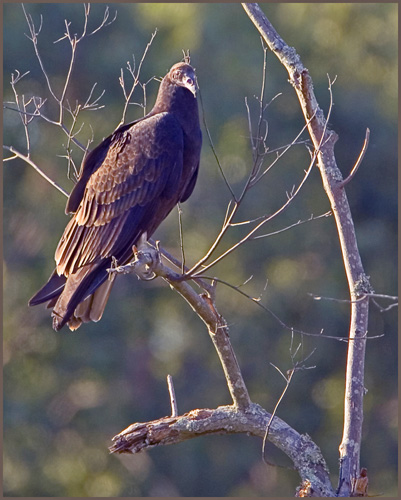
|
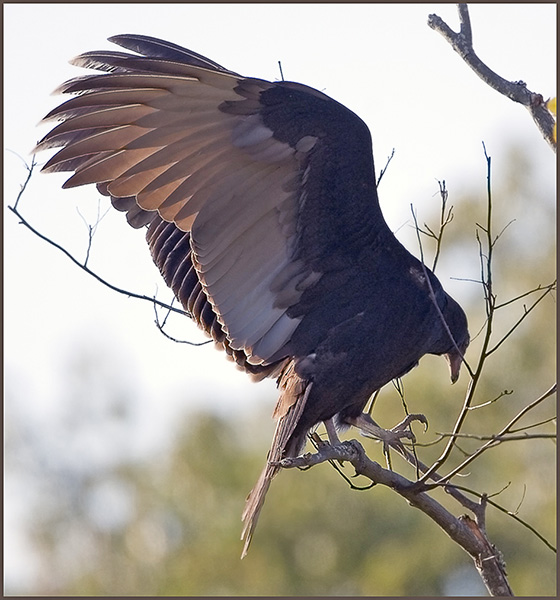
|
The next morning Bryan had to take Billy-Bob to the airport in Newport News for his return flight home. I hadn’t planned on going, but we had set up a computer at
the site office and learned some accessories were required to complete the installation and get the office on line. As I had to purchase these accessories, I traveled
in with Bryan and Bill. Because we were too early for the local Best Buy to be conducting business after we dropped Billy-Bob off, we took a short drive to the Mariners Museum to see
what time they opened, hoping to do a lightning tour of their ironclad exhibit. We were a bit early for this as well, but hung out in a park near the entrance
to the museum for a time. The trails here were active and this must be a favorite jogging area for the locals as there was a great deal of activity ongoing. Bryan spotted some
white birds on the distant water and thought they may be swans, so we mounted the long lens and followed the path to the pond. They turned out to be a pair of Snow
Geese. I took several photographs, looked around briefly and we left. One of our associates, Rich, joined us at the museum and when it opened we paid the fee and went in.
|
|
We watched a pair of Snow Geese meandering around the pond. I was taken aback by the eye color of this goose... this bird was photogenic to say the least.
There were also twelve or fifteen turtles in view here as well. The painted turtles can be quite beautiful. This is one of my favorite photographs from the September trip. |
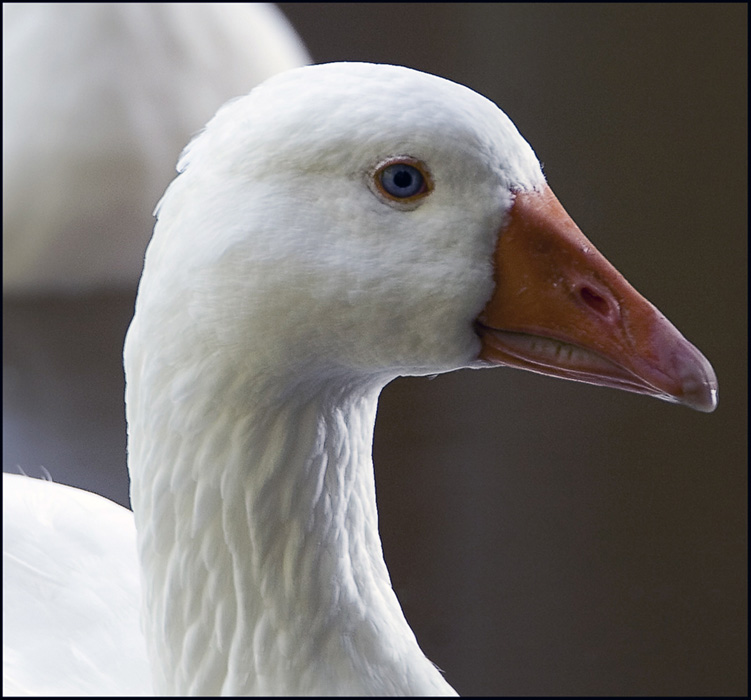
|
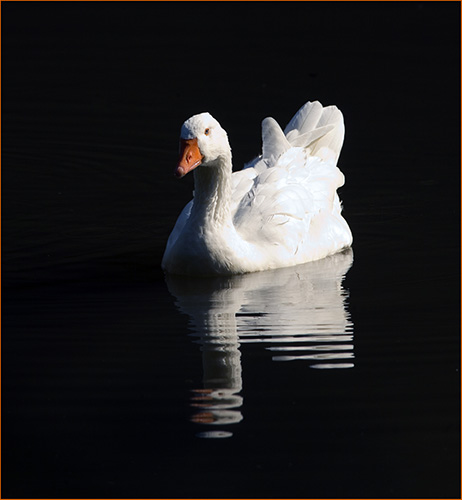
|
This body of water had several Mallards and a few Kingfishers off in the distance. It was probably the wrong time of day to see much avian variety and we weren’t there long in any event.
|
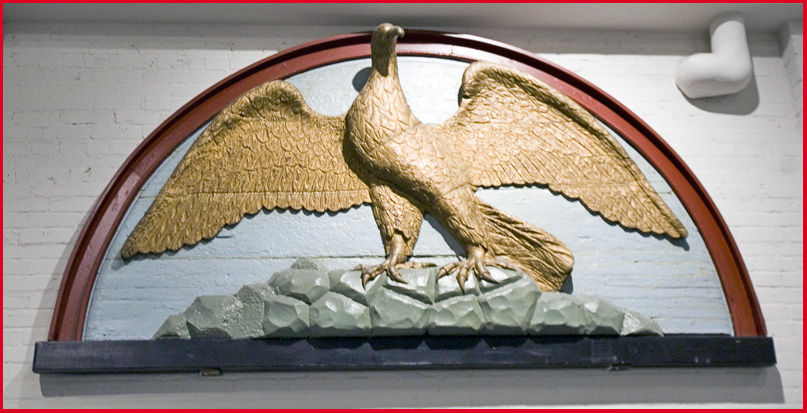
|
|
As we didn’t have much time, we talked to one of the Docents for a few minutes, took along a plan view of the different wings and went on our way. I hadn’t been
to this museum since I was quite young, in elementary school perhaps, when my family lived in Norfolk. Trailboards from the USS Hartford of Civil War fame. |
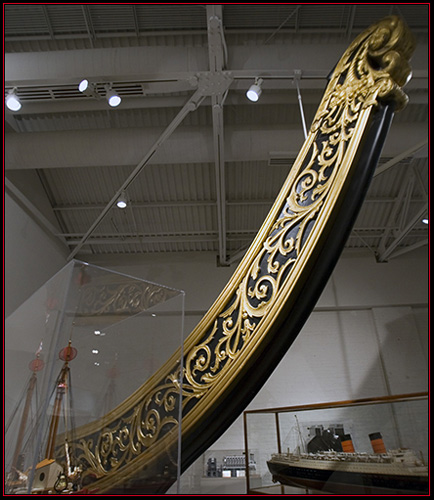
|

|
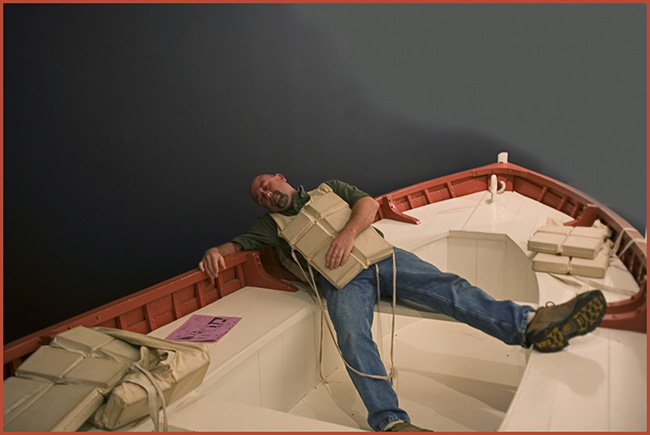
|
The museum had a Titanic display set up and we viewed the artifacts & photographs from this ill-fated vessel.
I’m certain one could spend a day reading and enjoying the exhibits of this wonderful place – I know I could... We had no such luxury time wise however and focused on a few things as opposed to everything available. I was disappointed to learn the ironclad exhibit was closed down as they were building an entirely new wing to house the turret of the USS Monitor raised in 1996. This was still in the treatment tank so you couldn't really see it either. We learned they offer a 'hard hat' tour each day at 1530 hours that you have to sign up in advance to take. This tour goes through the treatment rooms where the various Monitor parts are being prepared for display. Even worse from my perspective, the ironclad exhibit and all the artifacts had been moved in preparation for the new wing grand opening so none of this portion of the museum was available to view. I had my camera with no flash with me on this lightning tour and took some images as we hurried through the wings. Bryan as a Titanic survivor... I told him I was going to call his Momma if he didn't get out of the lifeboat... |
|
The displayed ship models are truly outstanding. There were two brothers whose life’s work was constructing historic vessels and many of these were exhibited
in a room by themselves. These really aren’t ship models per
se – they are constructed just like the actual vessels, not models, miniature ships and the detail is truly inconceivable to view. This room was pitch black... The
only light is in the display cases shining on the ship exhibits, enough to walk around by and I figured I’d try to get a few shots. I didn’t see a sign anywhere
prohibiting camera use and viewed other folks with cameras, mostly point and shot varieties with built in flashes. Shooting in this room was not a success but again
I was amazed at what the Canon 16~35mm f/2.8L lens can do in lowlight conditions. Outside of this room I imaged many of the figureheads that were mounted along the wall.
People looked at me quite strangely and I suspected they felt I didn’t have a prayer of getting an image in the main hall without a flash. However, I knew better and
with a bit of creative enhancing the results can be viewed above where I grouped the images.
A Venetian Galley - the detail of this and the other ships was astounding and accurate in evey respect according to the information. This photo was taken with the camera handheld at 1/8 second, ISO 1600 at f/2.8 in a nearly dark space. |
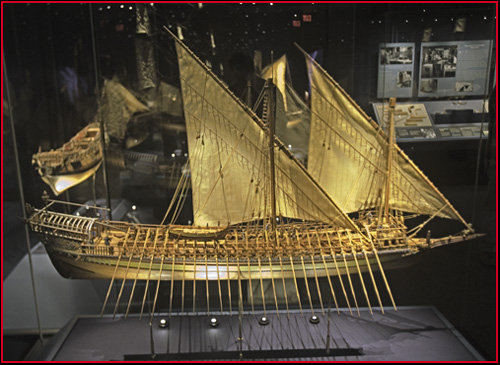
|
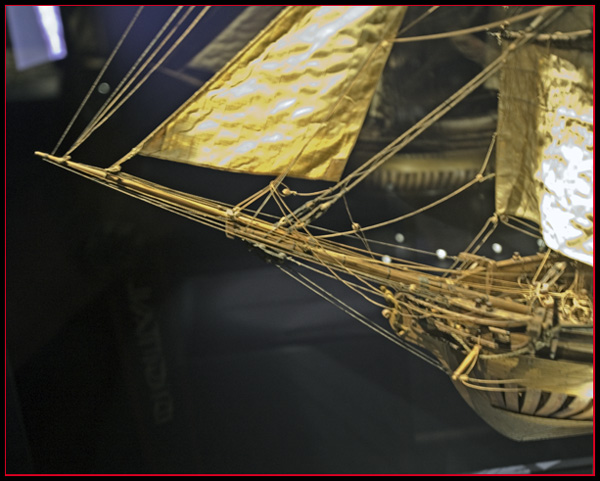
|
This detail is from a United States warship in the days of sail. This portion of the vessel alone is striking with the attention to detail of these ships. |
| A hull model of a 17th century English trading vessel. I can’t remember the specifics, but this may have been an East Indiaman. |
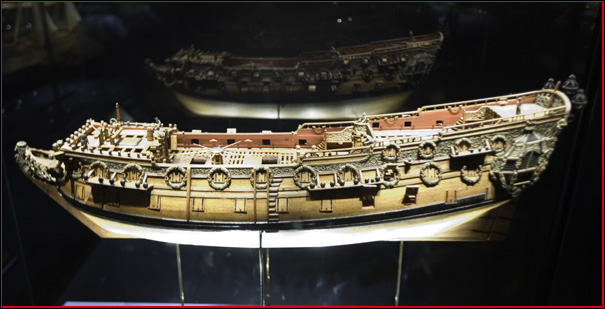
|
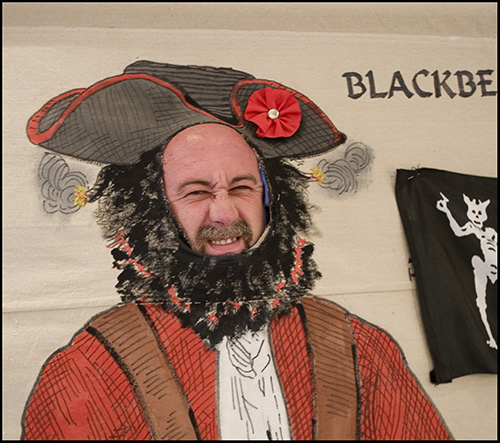
|
There was a pirate display for children we noticed as we walked by. I got both Bryan and Rich to poke their heads through the pirate backdrop so I could take photos of them.
You can see ‘Brybeard’ here, but Rich’s shot had too much camera shake to be of much use. The ‘history of exploration’ wing was interesting and they had a nice display about Admiral Lord Nelson and the era in which he lived. None of this information is new to me and this display was right down my area of interest. Probably a good thing as we had to get going although I would have liked to have spent more time investigating. If you are ever in this area I would recommend this museum without equivocation. It is truly an interesting and outstanding place to visit… |
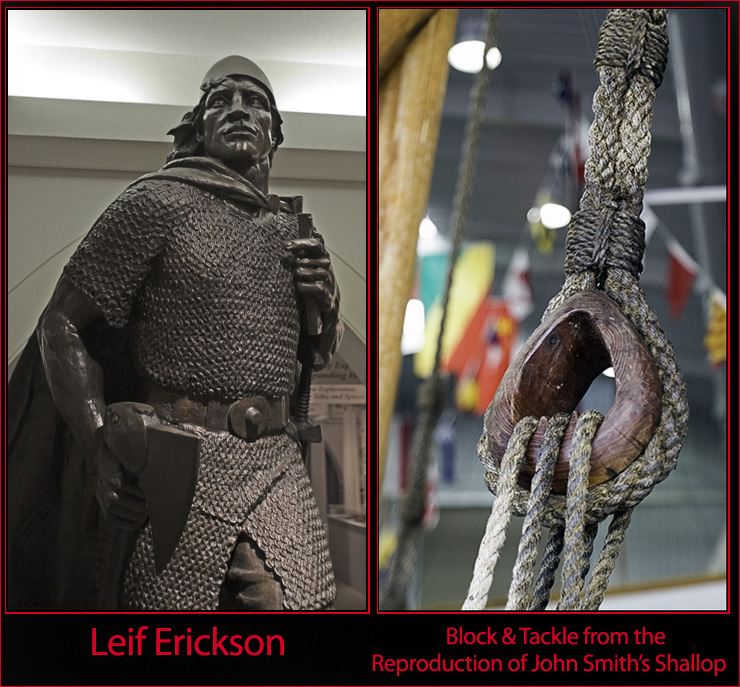
|
| Thursday afternoon we were returning to the project site after lunch and Bryan spotted a beautiful turtle in the road. Rather than have it run over, he stopped and threw it in the truck. This turtle, about seven inches long had beautiful markings and when June at the site office viewed it she wished to take it home. I was taking some project photos and had Bryan put it in the grass so I could take some images of the shell markings. The turtle didn’t appear out of the shell so I took several images of it on the lawn and went back to doing whatever. Later we looked for it and it was gone… It didn’t take long for it to head off and we hoped it was able to find a good place to relocate and stayed out of the road. |
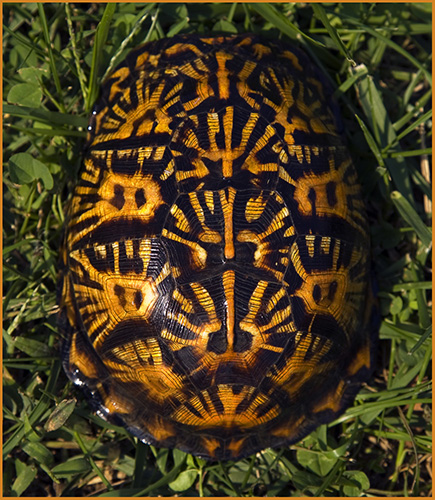
|

|
On Thursday evening we planned to meet our friends Renee and Allen for dinner. To this end, we met them in Smithfield late afternoon as they wished for me to
speak with a local frame shop owner about the possibility of displaying some of the Smithfield Osprey images. Everyone in the area watched this nest as the
fledglings grew and they were discussed frequently in town. They believed having a nice image of these birds may be something the locals would be interested
in. I had a brief meeting, looked around the gallery, which was really great and filled with limited edition historic prints – I really appreciated the works as they had much Civil
War art and
off we went. I asked Renee and Allen to pose for some images right outside the gallery on Main Street. We ended up crossing the road by the old courthouse
and I took some exposures there. I set the camera on the tripod and took a timed exposure so we could have everyone in one of the images.
Now you two will be even more famous than ever! |
|
We did some touring as Allen drove us around and discussed the local history. We drove to Surry County, not far from Smithfield and had dinner at a
family restaurant that had really great food. Renee had carried along the prints I’d brought her in October as she wished me to sign the group. As we
were doing this, the Owner came by and indicated his wife would really appreciate seeing these as well and to please show them to her before we left.
We later did this and I learned that she too was interested in photography and talked about this for a time before leaving for Smithfield and the hotel.
I was flying home the next morning and Bryan and I were on the site for several meetings before heading to the airport in Newport News. I walked around the side of the office and sitting right by the door, just as if wishing entrance - was our turtle. We didn’t know where this rascal had been or had it managed to get back, but June indicated she was taking it home. September didn’t allow much time for photography but I knew I’d be back at least once, possibly twice more to complete the work. Even staying for the week it was nothing like summer due to the loss of daylight and shortened days. However, there’s always next month… |
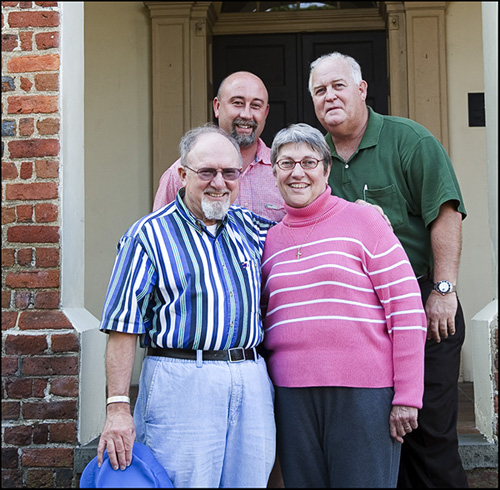
|
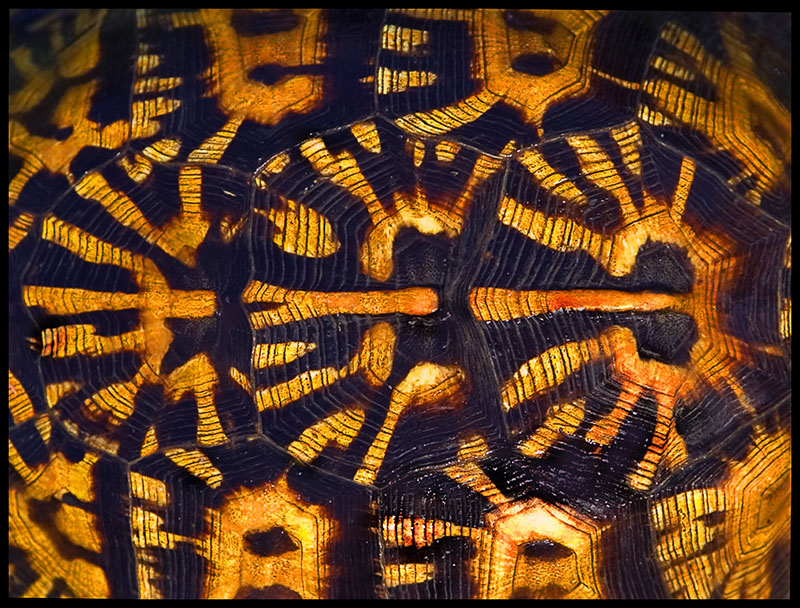
|
____________________________________________________________________________
I returned to Virginia in October for the usual requisition meeting. Our time on this project was almost over and the project was over 90% complete at this inspection. I thought about not carrying my photographic equipment as the days are much shorter, but elected to after speaking with Bryan. After the few times we got out, I was quite pleased that I did because the changing season found new imaging opportunities in our favorite spots.
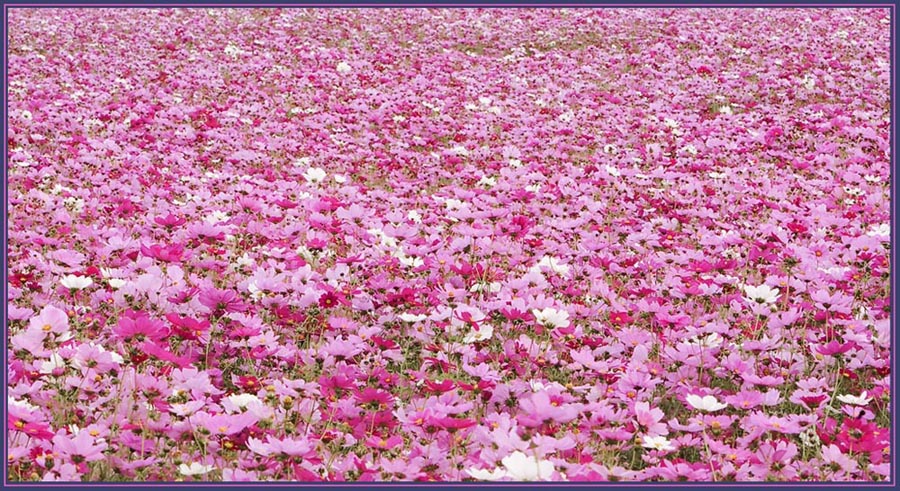
|
Bryan picked me up at the airport in Newport News and we crossed the James River Bridge going into Smithfield. Not far before we got to the project site, we came across a beautiful field of flowers a few feet above the road elevation. I indicated to Bryan that we should stop and take a few images of this as the girls back home would love it… The camera gear was in the back of the pick-up so it wasn’t long before we were set up and walked up the knoll. I set up the tripod and took a series of shots, some down low closer to the flower tops and some higher. Of the shots taken at this location, the one represented here was my favorite.
While we were doing this a police officer stopped by and spoke with us. Bryan’s truck has Georgia plates and he may have thought we were broke down or perhaps up to no good. We’d had some dealings with the local law enforcement related to the project and found all in the area to be really nice folks. Before we left, the fellow from public works responsible for planting this flowerbed drove by and we spoke to him as well. He was proud of his work, rightly so I might add and we indicated we believed this was quite nice. He stated that this bed will be fine until the first frost and that will be it until spring.
|
Last time I was in Virginia I’d told Bryan that we needed to get some exposures in one of the many cotton fields in the area. We didn’t have time to do this previously, but down the road from
the flowers was a large field with a secondary road next to it that would lend itself well to this pursuit. The field or road wasn’t posted that we could see, so I walked out into
the cotton to get a few images. For both the flowerbed and this field, I used my Canon 70-200 f/2.8L lens on the tripod with an electronic cable release. I’d started using the cable
release and like it quite well although for bird images it isn’t much use due to their mobile nature. The electronic release prevents one more cause of camera shake, handling the camera
as you press the exposure button.
While we were standing in the cotton this little fox came out of the tree line and was standing in the dirt road watching us. The fox appeared curious and kept an eye on us all the while. I talked with Bryan and stated this would be a great photo op with the 500mm lens, but it was in the truck behind us about forty yards and we knew there was no way the fox would stay where he was if we moved about. So I took this image at 200mm, all the focal length I had available at that time. The image is good but may have been great with more reach. I’ve been asked how much time is required to obtain the images I can get on one of these trips. Actually, none of this takes much time although it’s great if you're not being hurried when planning the exposures. Imaging the flowers and cotton field took perhaps twenty or thirty minutes. What I view as important is the lighting and time of day. It wasn’t a bright, hard-light day and the sun was in a good location for this effort. I viewed this as the right time to stop, otherwise I would have returned later or in early morning. In this case we didn’t have time to investigate the area and soon afterwards we packed up and headed to the project to do our work related tasks. |
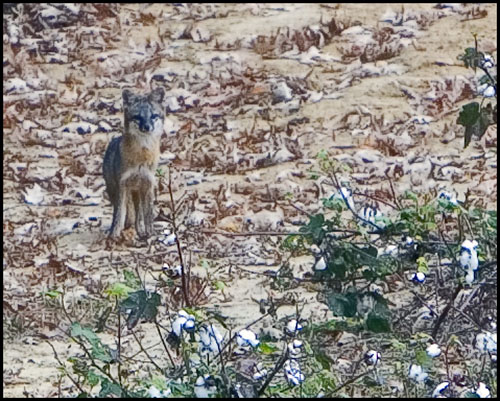
|
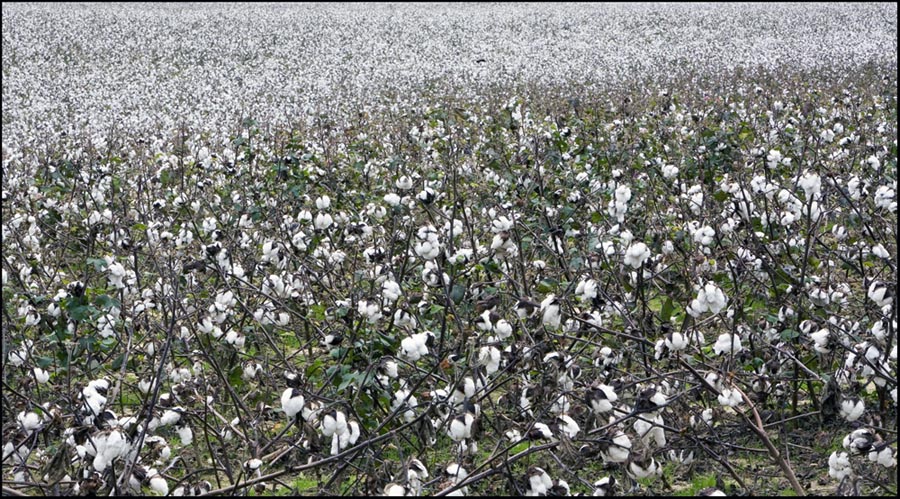
|
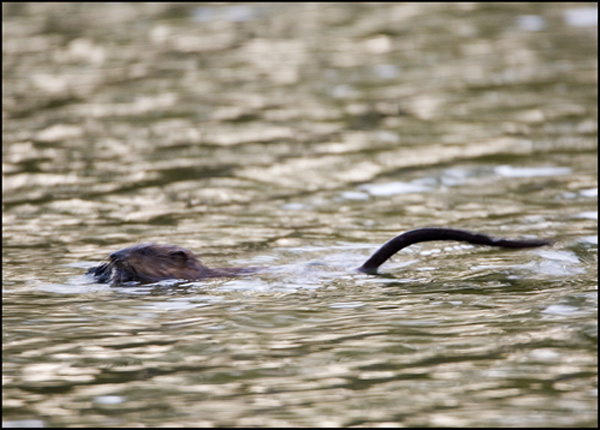
|
After work I checked into the hotel – Smithfield Station where I generally stay. Because I planned the requisition schedule for the entire project in advance, I made reservations
for five months because obtaining a room at this facility is no easy task. There are few hotels in the Smithfield area and most of the work crews stayed on the other side of the
James River and drove back and forth daily.
I talked with Bryan and we decided to take a ride to our favorite swamp location the next morning before sunrise. He also stayed in Smithfield to avoid the drive in the next morning. We weren’t really up that early on Tuesday morning as sunrise was just after 0700 hours. We were at the swamp around 0630, too early as we found, plus it was cold. This Virginia morning was every bit as cold as it had been in Maine. The big difference was in Maine I would have been dressed more appropriately as I had limited clothing choices where I was traveling. However, it was a beautiful sunrise and we looked around as we waited for the sun to break the tree line and illuminate the water scene. In the early light we viewed this critter swimming around and thought it was a beaver. I imaged it multiple times but in the low light conditions it was difficult to get the shutter speed quick enough and most of the images exhibited motion. This is the best of the group and upon analysis, we realized this was a muskrat. |
|
Seeing a muskrat was something new here. The Belted Kingfisher that is always around and flies off out of sight every time we’re spotted was there and did his usual act, although
later this bird reappeared and actually perched across the water from where we were set up. A Great Blue Heron was perched in a tree and was later wading in the shallows, a constant presence in our favorite swampy spot.
We viewed three Pie-billed Grebes, a pair on one side and a single bird on the other. This was great – the fall weather was bringing a different group of animals to the area. One Grebe (pronounced Greeb & related to the loon family) plucked a fish out of the water as we watched. I took several images of this small bird and was surprised by the size of the fish in relation to the size of the bird. The Grebe swallowed the fish with little apparent effort and went on his way. These Grebes proved to be my photographic nemesis… I shot all three multiple times over the next days and never did obtain the image I was seeking. They were always too far away or the exposure/lighting wasn’t optimum. |
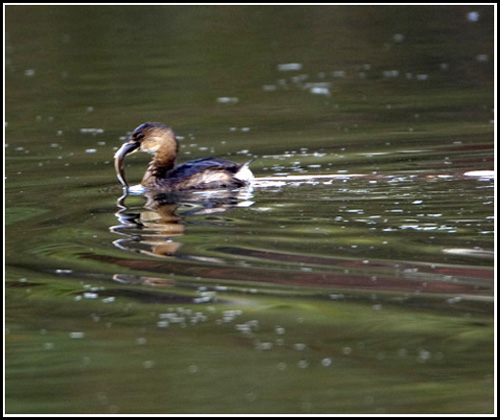
|
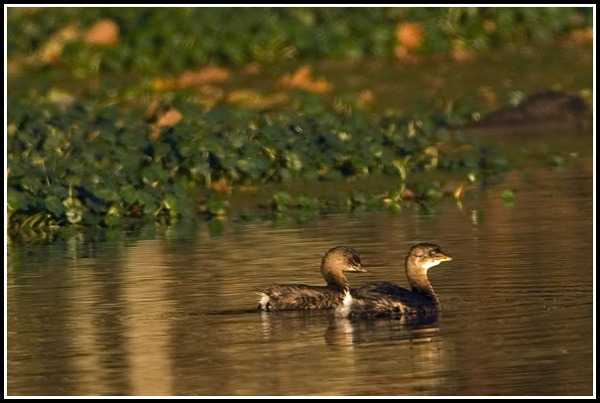
|
As we watched the water a White Tailed Deer buck strolled out of the woods and cautiously approached the water to take a drink. Bryan spotted the deer and I had him line up a shot.
He took an image of the buck but it too wasn’t good on critical focus, just another casualty to the low light imaged at a distance so I didn’t enhance it.
The deer we’d seen in Virginia (and Maryland for that matter) are much smaller than those in Maine I’m used to seeing. Bryan and I had viewed multiple examples of the local White Tails and never viewed one I thought was above a medium sized animal. A deer this size in Maine would have a good chance of survival during hunting season as everyone prefers to seek out the big bucks and probably would pass on this size unless no options were remaining. However, they appeared plentiful and this trip we viewed multiple groups or individuals moving stealthily through the woods. In the image at left the pair of Grebes goes about their morning routine as we hoped they’d move in a bit closer. This image was taken at 700mm and is at 100%, so you can get an idea of how far away they were - these aren’t large birds whatsoever. Another habit they have is when any sign of danger or threat becomes apparent, they instantly submerge and we can tell you with certainty, they can swim a long distance under water. They may come up fifty yards from where you’d expect to see them next. This pair wasn’t too bad and stayed in the area pretty much, but the third, the solitary Grebe was particularly elusive. |
|
I walked back to the boat launch area and coming out of the back of the swamp was a large, ugly duck making his way towards the many stumps and stunted trees in the water.
I set up and took several exposures as the bird swam along and then climbed up on a stump to get out of the water and preen. This was the first Muscovy I’d seen here in
the wild and it was indeed something to behold. I did some research and learned these birds are raised for food and of all things, pets. In the duck world they are
supposed to be one of the best species to dine upon. The image at right exhibits the colors of this duck in the wild or from one of the feral groups that can be found
in various parts. Through interbreeding (especially while domesticated) many other color examples can be found.
We viewed many songbirds moving about in the bushes lining the roadway and I recognized several as being the warblers we’d tried to image previously. We also viewed some Robins and a few other bird types and I tried to image what I could. I got some exposures off, but the lighting simply wouldn’t support the exposure duration required and although the images weren’t terrible, they exhibited enough movement to be rendered unusable. |
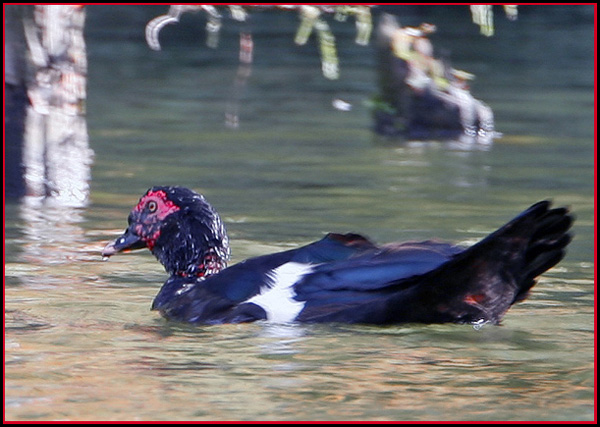
|
We heard the distinctive, loud call of a Belted Kingfisher and I looked around to see where the bird was located. I saw a bird fly into a tree not far from where the pair of Grebes swam peacefully. As I moved towards the area, the Kingfisher flew off; typical I thought and it wouldn’t be seen again. However, this time the bird flew across the water and landed in a tree. Far away granted, but in view and outlined nicely against the green of the leaves. I carefully moved the tripod in the road, found a good point of view and took some exposures. The results can be viewed below.
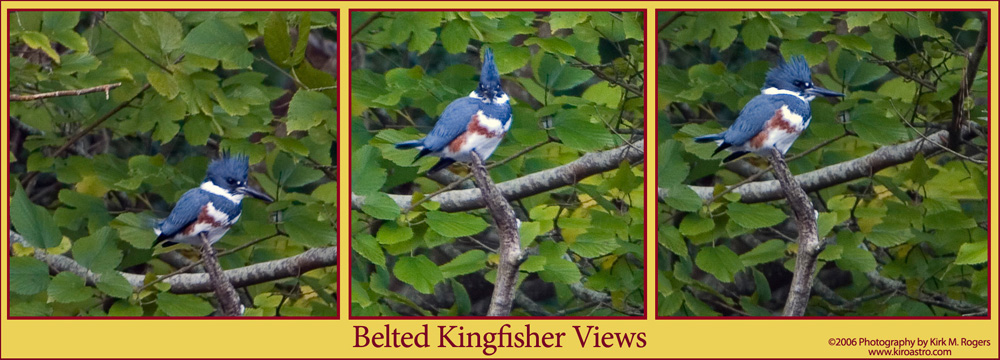
|
We didn’t have much time before going to work so discussed the lighting. It was apparent we couldn’t wait for the sun to get high enough to be optimum at this location and decided to head to the Fort Boykin State Park as we knew this was more exposed to easterly sunrise lighting. This was only a few minutes down the road so we packed up with this as our destination. After parking the truck and pulling the tripod out we looked down the gravel road into the park and spotted several groups of songbirds flitting in and out of the trees and bushes. No unauthorized vehicles were allowed to access this road so we shouldered the equipment and walked down to check the activity.
It took a few minutes to sort out what was flying around and where best to set up to attempt some shots. As we got closer the sun was becoming an issue as we weren’t on the right side of the cover and in some instances would be shooting into the sunlight. Using the bushes for cover, we were able to screen the sun and find a spot to set up. Many of the birds were high in the trees and the angle was difficult to achieve as we were at the base of the trees. In the end result, these bushes and trees proved to be a great spot and I obtained some decent Yellow-rumped Warbler and other images as can be viewed here.

|
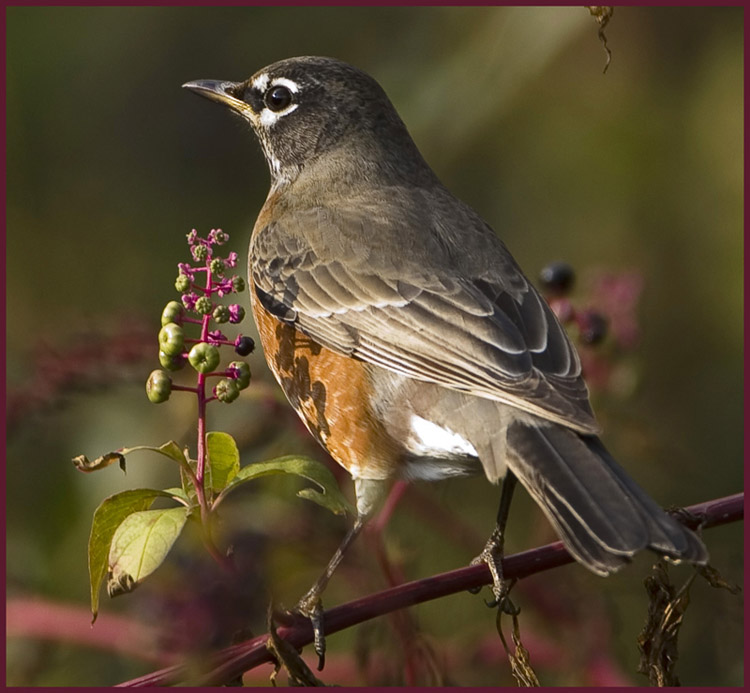
|
I recognize this is a common view of a fairly ordinary bird. However, I really liked the detail in this shot and the high resolution version is stunning at
least in my (humble) view. This Robin was imaged just inside my focus range and I think it came out well. The Canon 5D camera has outstanding resolution
limited only to the skill of the operator and field conditions. I would recommend it to anyone interested in photography. Plus the cost for this body has recently been
reduced making it that much more affordable.
I kept this image a bit larger to prevent degrading the resolution anymore than necessary. 1/125th second at 700mm focal length, ISO 400 at f/5.6. |
|
I also imaged a Mockingbird in the same thicket and these too had great resolution in wonderful lighting conditions. I made up a composite image of this bird that can be viewed below,
but felt this individual photograph had great merit as well. The Mockingbird was reacting to the sound of my shutter as I took the exposures and in this view, the bird is
checking me out and trying to identify just what that particular noise may be.
Canon EF500mm f/4L IS USM lens + 1.4X Extender = 700mm focal length at f/5.6; 1/100th second at ISO 400; pattern metering mode in Aperture Priority. |
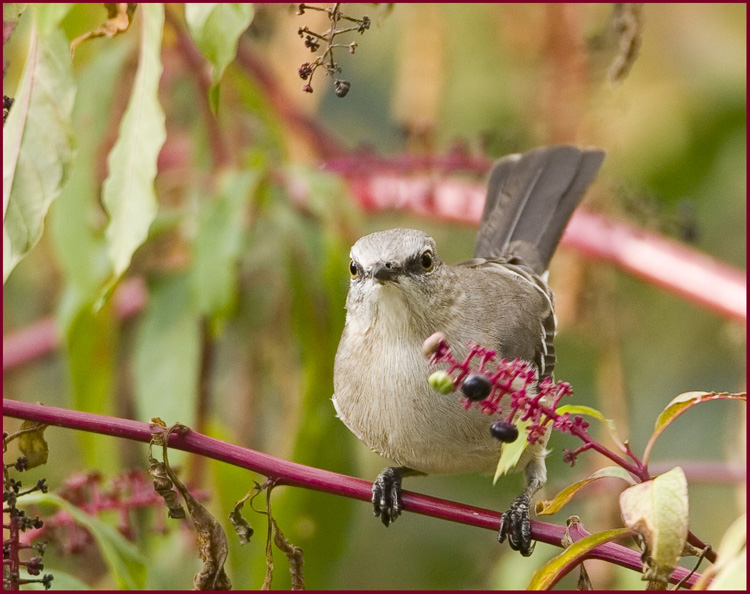
|

|
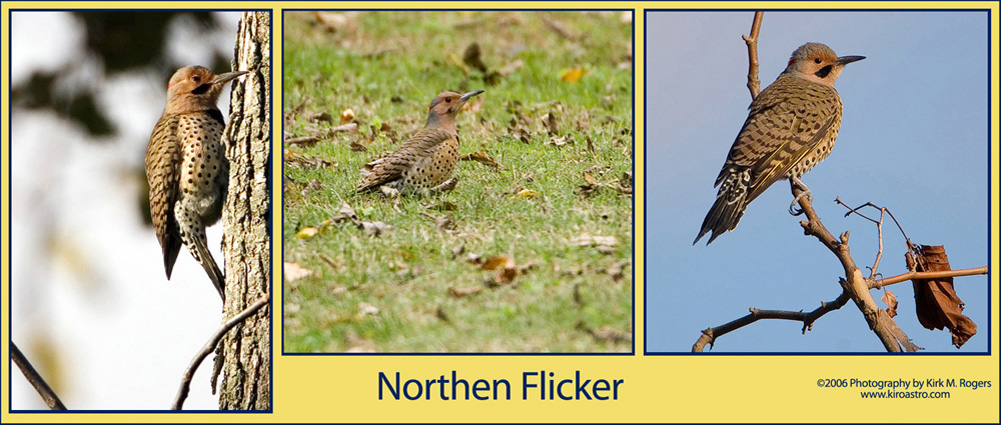
|
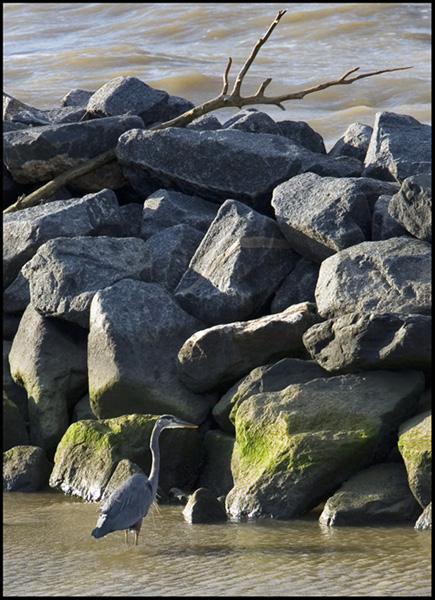
|
Bryan had told me he’d been spotting Bald Eagles in the area. I was incredulous at best as I hadn’t seen evidence of any although I knew they were present in the James River area.
As we walked in the park an adult eagle flew overhead as plain as day… It was magnificent to say the least and we hurried to find a location that would provide an opportunity to
get an exposure of the bird in flight. Although the eagle soared by one more time, the opportunity to take a photograph never was presented. This specimen didn’t appear as large
as what I’d expected but it wasn’t at all that low an altitude either. Bryan indicated he would check this area out as time permitted to see if he could ascertain where the
eagles may nest or seek and optimum place to perhaps image them.
Bryan, I apologize for all the derision heaped upon you and your ‘eagle’ sightings… I was convinced you kept seeing those ‘Georgia Eagles’ (Turkey Vultures) we were always joking about… Time was getting short but we didn’t wish to leave before visiting our favorite morning tree on the bluff above the James River. I’d gotten many fine bird images using the leafless, dead tree as a perch when it is bathed in morning light. As we walked the path to the bluff we realized just how strong the wind was blowing this morning. What a difference as we entered the exposed area… It was clear even if we viewed anything worth shooting we’d have difficulty imaging under these conditions. Looking over the bluff we saw a lone Heron wading by the breakwater and I shot down on the scene as can be viewed here. This final image ended our morning session... We returned to the truck, packed up and went to the project site. We’d determined to get back to this area after work if our schedule and daylight permitted. |
The meeting and the balance of the workday went well. We sure have met some good folks to work with in Virginia and they group on this project are outstanding. Around 1600 hours we decided to call it a day. Bryan and I discussed if we were up for another imaging session as soon the lighting would be ideal in relation to sunset. As is always the case, Bryan was indeed all for getting out and seeing what we can find – he never fails to take advantage of an opportunity to get out in the woods or check the potential imaging areas from my experience.
|
We drove back to the swamp area near the boat launch, which is just a few minutes drive from the project. This is always a great place to image and rarely had we not viewed something of
interest in this location. Fort Boykin State Park is nearby as well and this location also has great merit for wildlife imaging plus a wonderful overlook to the James River.
It’s easy to see why this spot was considered crucial in defense in both the American Revolution and Civil War (War Between the States to those of a more Southern view).
We were surprised to see a four-wheel drive pick-up backed down the boat launch ramp… Since the recent heavy rains & winds the already deplorable road was washed out even more and I would never have taken my truck down there. I walked down and spoke with a fellow fishing, using his tailgate as a work station. He was from Chesapeake and like us working in the area. He stopped here from time to time to check his luck and I explained why we frequented the area when in town. I would comment that many people think you’re a bit whacked when they learn you’d rather stalk wildlife with a camera in lieu of a firearm, but the appeal is very similar in most respects, you just don’t kill anything... Rather than disturb his privacy Bryan and I figured we’d meander up to the park. As we were preparing to place the tripod in the back of the truck Bryan noticed what he thought was a beaver sitting on a log across the road. This area banks up about ten feet from the road elevation and he spotted this head above the rise. As we set the tripod up to take a look, the animal dropped out of site. Bryan had walked up here before and was familiar with the lay of the land. We decided to take a look before moving on. As we climbed up the hill we tried to remain quiet to see if the animal was still around. From perhaps thirty feet away, a pair of eyes could be viewed watching us. I lost sight of the eyes once I looked through the camera and Bryan came over and pointed the lens in the area. It appeared the animal had backed into his den as we were watched. I took the image at right and realized we were stalking a ground hog. However, unlike the area deer, this was the largest, fattest ground hog I had ever seen that I can recall. I’m certain if I were a ground hog I would look much like this specimen… |
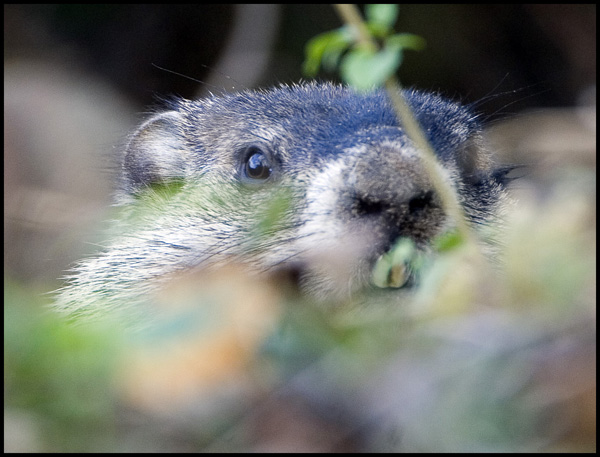
|
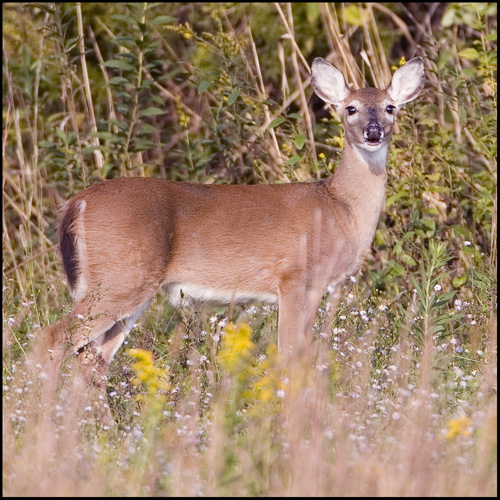
|
As we walked through the woods bordering the bend in the water heading to the James, not much was in view for birdlife. The woods were quiet although off in the distance we could
hear birds going abut their daily routines. Things were starting to appear a bit disappointing when we came across a dirt access road into a meadow. As we stood in the tree line we
could see many bluebirds in their distinctive color flitting about in several trees and several other bird species perched along the poles and wires running along the meadow.
This could prove interesting indeed and we tried to stealthily work our way close to the trees without going into the open.
There was a stack of railroad ties out in the open and we decided to get behind these for cover; this stack wasn't too high in elevation but offered the only usable cover that would work with the location of the sun and may help to break up the view of our forms. Through the lens I could see Flickers, Bluebirds, Phoebes, Mourning Doves and several other birds, a real potpourri of birdlife in the same tree. As we stood still and quietly watched a doe White Tail came into view. She knew we were there and checked us out intently. After a few minutes she had the courage to break out of the trees. I took multiple exposures of this deer including the one at left. |
|
Just as Bryan started to move everything flew out of the tree at once. I looked at Bryan and asked, ‘what did you do?’ We were pretty far away from the tree and thought it
unlikely we spooked them at this distance. He indicated he didn’t do anything, and then we saw what was going on… There were at least three hawks in the area at the same
time and they were hunting. This was enough to get everything in sight motivated to leave the area. One of the hunters flew by us like a shot. It was small and quick and I
told Bryan I thought it was a falcon. I really don’t now what it was but a few minutes later we viewed a pair of American Kestrels (the smallest falcons in North America)
and another predator perched in a tree that I couldn’t identify. This bird too, was small and agile we saw as it took flight. I managed to get an exposure of this bird
right at that time. Although not a great shot and taken from a long distance, this provides a good representation of the scene. I'll investigate to see if I can learn what type of bird this is.
|
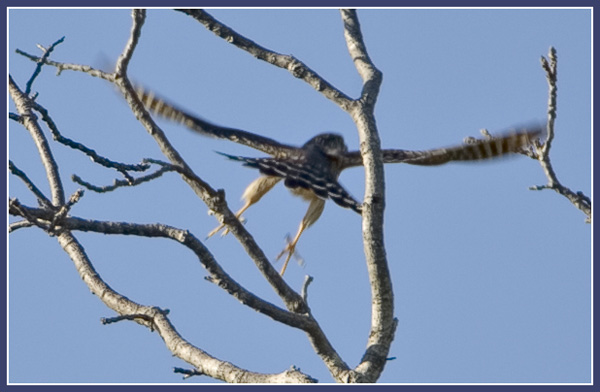
|
The wind was up and blowing fairly hard in this area as well and as we prepared to move again to close the distance to the birds we viewed a Red-tailed Hawk flying into the wind intently watching the field below for prey. I got multiple exposures off on this distant bird and they were in good focus although the image scale was small. The composite of some these images can be viewed below.

|
We were surprised to see some bluebirds sitting both on the wires near a kestrel and in nearby trees. These birds didn’t appear to mind that the predators were seeking lunch although the others and most of the bluebirds had cleared out. We weren’t able to get close to them with all the activity going on – they appeared quite nervous & spooked with all the commotion about. So we got as close as we could and took some exposures. The composite below is of two of the Bluebirds.
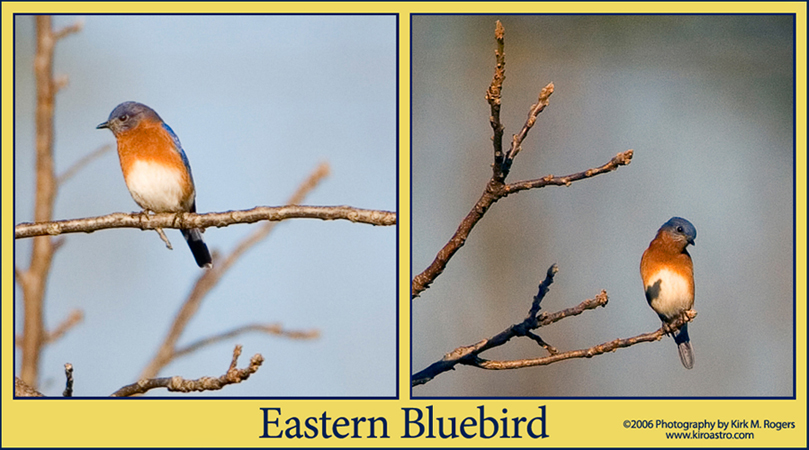
|
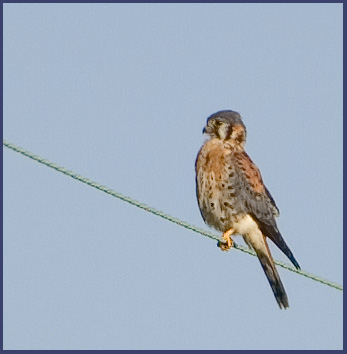
|
One of several Kestrels hunting in the area… I like this photo although it was imaged much farther from the subject then would have been my preference. |
|
An Eastern Phoebe perched on a wire. These small to medium birds are in the flycatcher family.
|
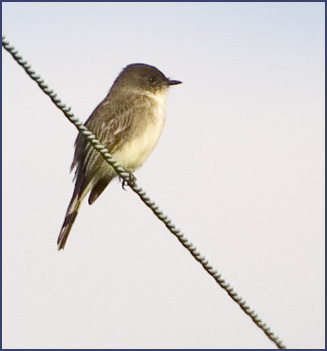
|
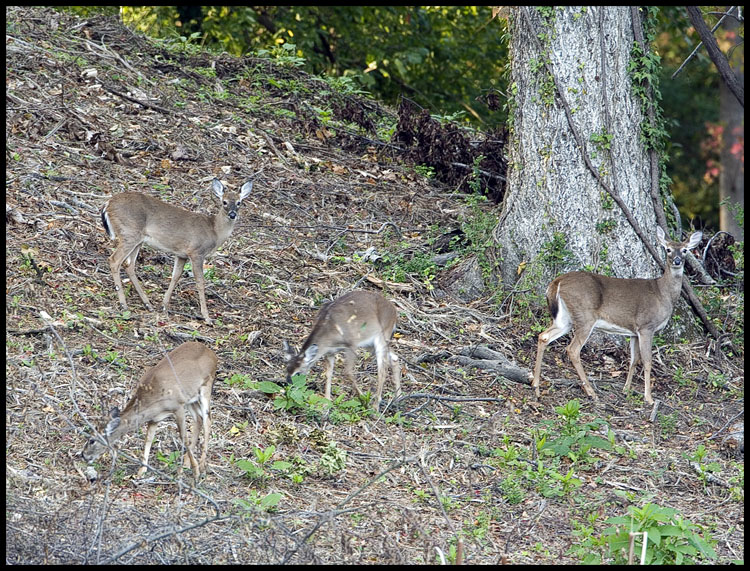
|
It was getting late and we had plans with Renee and Allan for dinner so we started to work our way back to the truck. We planned to revisit this spot as the birdlife was different
here then the other places we’d inspected. I’d like to get a close up Bluebird image, but so far these beautiful birds had eluded my lens at close range. With a bit of planning
this site could be the location to do this. As it turned out, this was the last opportunity this trip we had to get out with the camera.
As we walked down towards the swamp a group of deer was spotted using the cover of the woods to get near the water. We changed course to come out closer to their location and from across the water I took several images of the group as they broke cover. They heard the shutter noise and looked up as the exposure at left was taken although they weren’t particularly spooked and took their time foraging. |
|
June Jones, Manager and matriarch of Jersey Park Apartments in Smithfield. June has been instrumental in the success of our rehabilitation project at this property. Thanks June!
|
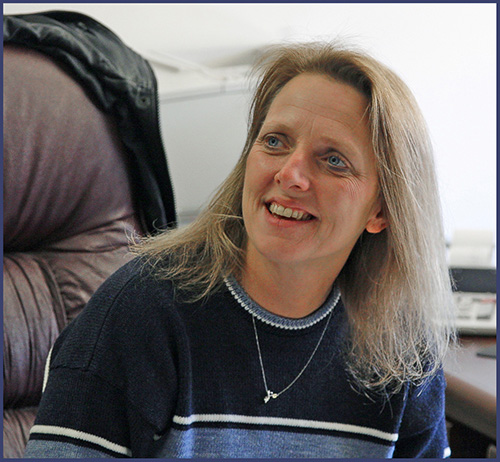
|
I found the October trip to Virginia to be successful in a photographic sense. We had limited time to expend in this pursuit but ample opportunities to get some fine images of the various animals and sights in the area. My trip in November will be compressed and may not allow any chance to image as it’s just before Thanksgiving. This will be the last planned excursion for the Smithfield project and will mark the end of this photo account.
____________________________________________________________________________
The final meeting requiring my attendance in Smithfield was scheduled for November 21st. Had everything gone according to plan, this would have completed the project. However, this was not to be. Although I wasn’t required to go back as far as I know at this time, the project would be operating for several more weeks to obtain certificates to occupy the addition we constructed.
This trip was the days before Thanksgiving and a hectic time. With the short days and our busy schedule the possibilities for imaging were not too prevalent. Bryan and I did find a bit of time here and there to explore our usual haunts and in the end I’m pleased we did because some new bird images were added from this excursion.
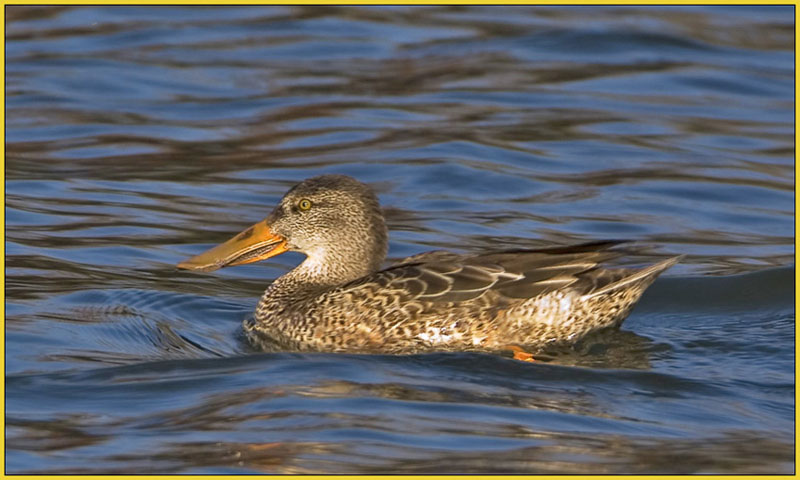
|
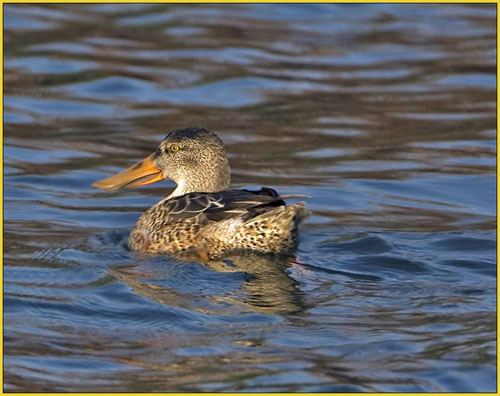
|
Northern Shoveler
After getting picked up from the flight in, we crossed the James River and were heading towards the project site. I asked Bryan if he felt like driving by several of our regular haunts so we could scope out what may be around at this time of day. This works out fairly well as each season I’ve experienced in the area brings new wildlife at the same places we frequented. As we drove by a quiet section of water, we noticed several ducks as well as a Muscovy and we decided to stop and take a look. It only took a few minutes to have the camera set up and ready to image so I walked down the road and set the tripod up. This female Shoveler looks much like a Mallard, but the strikingly long bill is a readily identifiable point and once you’ve viewed this you’ll know the difference. It's not difficult to see why they are referred to as 'shovelers'. This group was foraging not too far from the James River in a calm body of water. |
|
I imaged a Ring-necked Duck, one of several viewed and another bird that winters in the south where they prefer smaller, often wooded ponds. They are common in Maine in the summer
and breed and raise families in freshwater lakes. These birds are diving ducks; they are small and appear much like a Scaup.
|
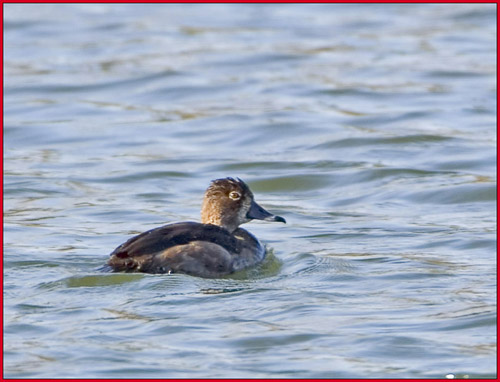
|
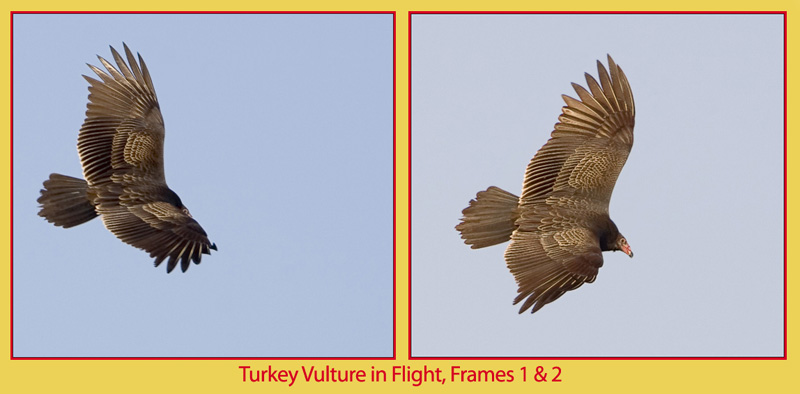
|
We noticed several Turkey Vultures flying in the distance. I had yet to get a shot of one of the birds in flight in which I was satisfied in all respects. In the short time we were stopped, one flew close to me and I swung the 500mm lens, extended to 700mm, achieved a focus beep and took a series of exposures. Later, upon review of the files I was pleased with these images although this specimen was quite far away and the I would have preferred a larger image scale.
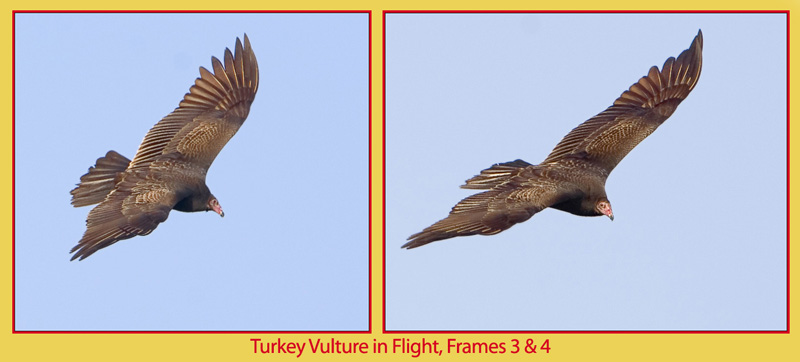
|
We also viewed some Double-crested Cormorants, Mallards and few other birds off in the distance. We were pressed for time so we packed up figuring we could return to this area later on or the next day if our schedules permitted.
|
On Tuesday morning we got up before the sun, not a great feat as sunrise was still around 0700 hours, even with the time change. We had the gear in the truck already
and decided to swing by the swamp to learn what may be out that morning. Several Pied-billed Grebes were still in the area, the usual Great Blue Herons,
Kingfishers could be heard and an occasional Cormorant flew over. As stated previously, the change in season appeared to bring new birds and other animals
and I knew this spot would be missed for imaging with the completion of the project.
This Grebe had just surfaced when I took this exposure. Although not a great image, it represents the best Grebe shot I obtained from this area. These birds are my nemesis - trying to image them is difficult as they are shy, sink under water immediately if they think you’re even looking at them and swim a long way before surfacing. They can clear the area before you even see them again and I wasn’t exactly close to where they were swimming. Several weeks before, Bryan had driven by our favorite swamp area and viewed of all things, a pair of Black Swans meandering amongst the trees, stumps and shoreline… He had his ‘point and shoot’ camera along and took several images of the pair. When he emailed these to me I was truly astounded. They were beautiful and completely unexpected. I asked him to re-check to learn if they were around at a later time but in the coming weeks he didn’t see the pair again. I hoped to have an opportunity to get these swans in the viewfinder with my 500mm lens. |
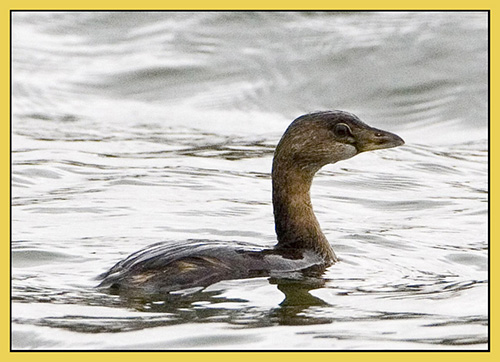
|
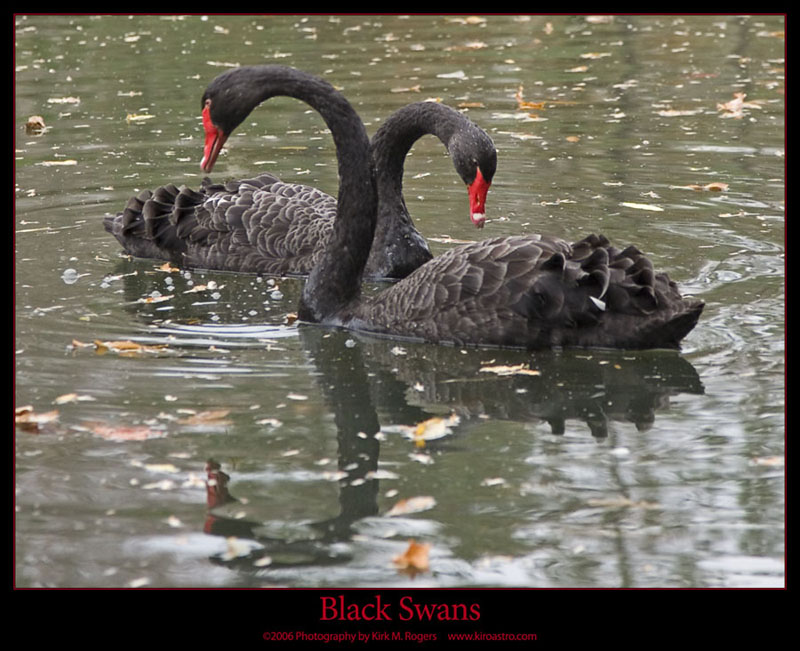
|
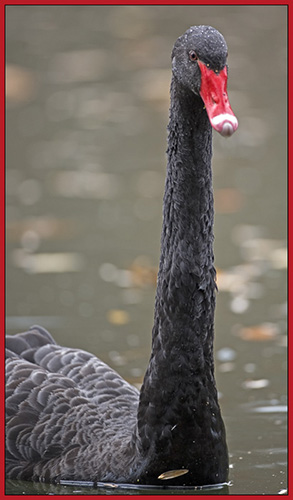
|
These birds are considered exotics in the United States, escapees from zoos or from the care of private owners. This pair appeared to be living in the wild. As we discussed this,
I commented to Bryan I didn’t believe this was a particularly good place for them to live with the many predators and hungry animals around the area. They looked fit, appeared friendly and
seemed to be enjoying a good life.
From what I read Black Swans hail originally from Australia. They may have been kept by the Fort Boykin State Park caretaker similar to what we’d been told about the Peacocks in the area but we never did find out as nobody we spoke with had any knowledge of the pair. I wasn't too concerned by this, I was simply pleased to have an opportunity to photograph them. |
|
I imaged this magnificent pair as they foraged about using their longs necks to check the vegetation and scanned the water for a tasty morsel.
I had enough time to change to a shorter focal length lens and with Bryan’s able assistance, imaged them at various exposures and compositions hoping to
get just the right image for something I had in mind. I probably could have tried for more depth of field on some of the images but overall, I’d say the session
turned out okay. Thinking back, enough time would have been allowed to do some bracketing and more exposure compensation but I was obtaining decent histograms
according to the digital read out.
|
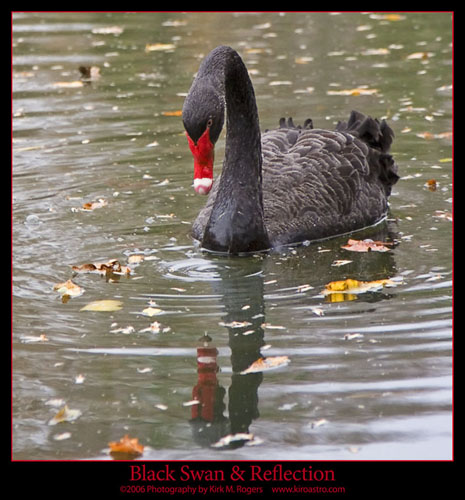
|
I took multiple images of the swans trying to capture the essence of their beautiful movements as much as possible. After a time, they swam off returning to wherever it was they appeared from. We couldn’t stay much longer in any event and I was fairly satisfied that we’d done everything we could in the time the pair was in sight. Even with the understanding there wouldn’t be a second chance to find and photograph the pair, we packed up and we too, went on our way.
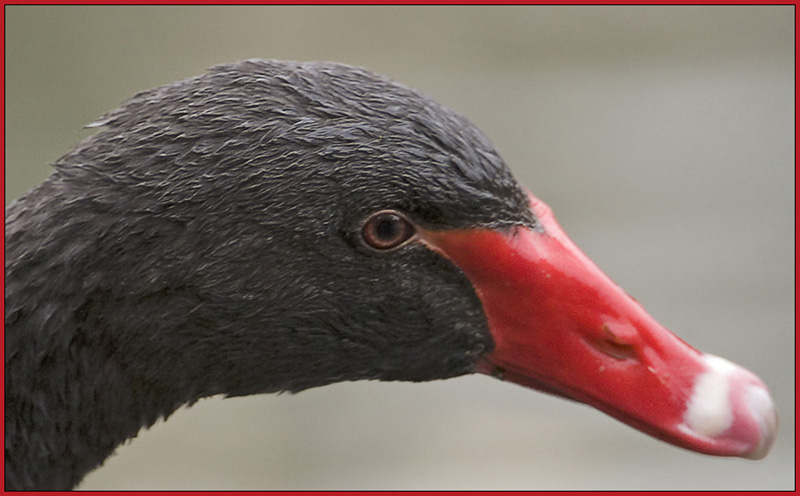
|
The weather reports had been dismal with a Nor’easter scheduled to sweep the area for the next several days. We’d already experienced some rain, heavy at times, but our understanding was that this was nothing compared to what was expected. I would say the reports were correct as Tuesday evening when the tide came up the Pagan River followed with high winds, the water commenced to rise… By early evening the folks at the hotel called and indicated if you have a vehicle to move it out of the parking area to high ground because the parking lot was underwater and it was continuing to rise.
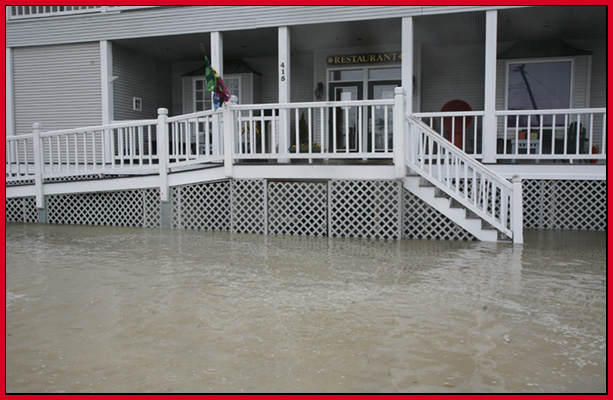
|
I was flying back to Maine the next morning and was concerned with the heavy traffic expected at the airport and on the roadways. It wouldn’t be the first
time I was stuck out of state and at the mercy of an airline trying to get home. I really didn’t want to miss Thanksgiving nor did I look forward to
spending the night wherever if grounded in Philadelphia or elsewhere.
Bryan stayed at the hotel where I was and we watched the latest news and weather, much of it related to the storm as it swept the area. At 0700 hours the next morning I received a call from the front desk… If you’re planning on going, it best be now because the parking lot is flooded and the small bridge nearby is closed with water over the roadway. I didn’t have to be told twice and started packing the few remaining things not yet in cases. Bryan was out and about and reported that the Owner was shuttling folks from the main entrance of the facility to their vehicles so nobody had to walk through the water. Once all our processions were downstairs and we looked around, it didn’t take long to figure out we were going to get wet no matter what we did as it was raining hard. The Owner indicated where I should go with my briefcase and various other goods, where Bryan could drive down to pick me up with a possibility of not wading through the water. I followed his instructions and Bryan drove the pick up down. Even with this, my feet and pant legs were soaked; it was going to be a long day the way things were shaping up and I was concerned the airport would close. As we drove away, I took several exposure of the hotel. After all, this could well be the last time I saw the place and the end of my journal in Virginia, at least in the foreseeable future… |
|
So ends my photo-journal from Virginia. I’d really enjoyed being in the area through four seasons and found the imaging opportunities to be excellent.
Time will tell when I’ll start this process again, but our firm recently put a project in Tampa, Florida under contract so one just never knows…
|
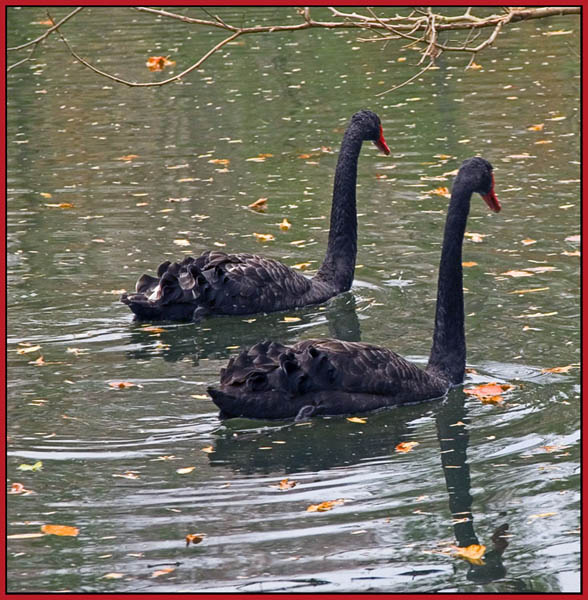
|
Kiro, November 2006
A note about the photography...All images in this account are by the author. Any images viewed that are digitally framed and labeled have been printed at approximately 16"X20" or an appropriate size for the photographic image and added to my collection of works for sale. These are displayed when at shows and events either packaged on foam core, professionally framed or ArtiPlaq™ mounted as a final for purchase. The web versions are nice, but a full resolution print significantly enhances the beauty of these images; all are ©2006 Photography by Kirk M. Rogers - any reproduction, publication or transmission of this content without the written consent of the author is prohibited. Please contact me should you have an interest in obtaining any of the images.